

Mongolia Tours
Cultural adventures in the land of genghis khan.
Witness the wrestling, archery, and wild horseback games of Naadam, meet the traditional eagle hunters at the Golden Eagle Festival, spend the night in a cozy felt yurt, and visit the Flaming Cliffs in the great Gobi Desert, where the world’s first dinosaur egg was found.
All Trips to Mongolia

Small Group Adventure
In the Realm of Genghis Khan
From $5,695
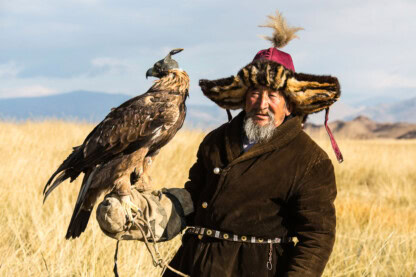
Mongolia’s Golden Eagle Festival
From $8,495
Experience Mongolia
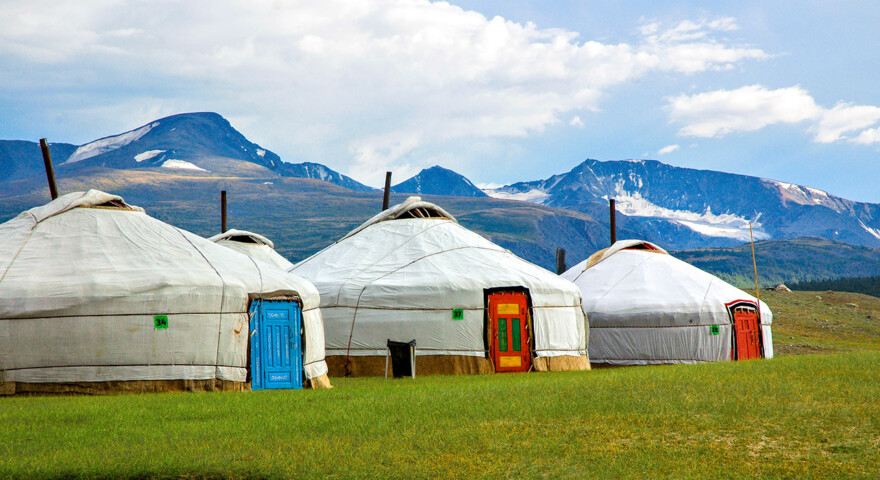
Extend Your Trip
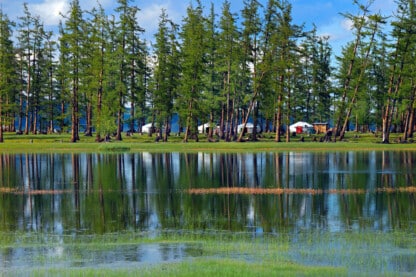
Lake Hovsgol Extension
From $2,395
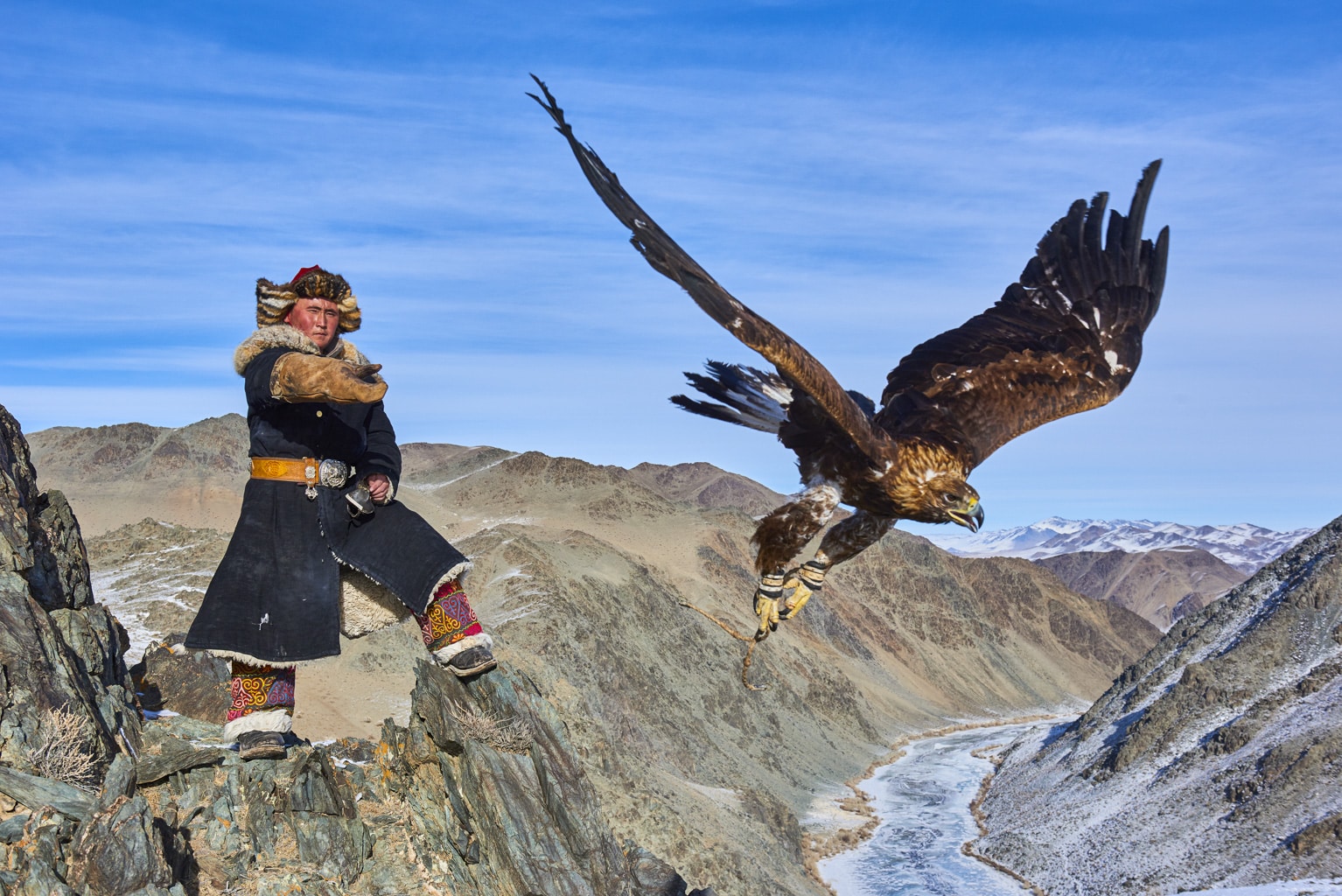
Western Mongolia Extension
From $2,995
Talk to an Expert
Our Asia Specialists know every detail about our Mongolia Tours. They will be happy to answer any questions and help you choose the journey that’s right for you. Contact us to learn more or book your trip today!
- BOOK WITH CONFIDENCE
- EMAIL NEWSLETTER
(800) 998-6634
Nomadic Expeditions

Travel Experts 9am-5pm EST

Where the Big Picture Gets Even Bigger
In the terrain of Mongolia’s rugged mountains, vast fertile steppe, and otherworldly Gobi Desert—you will find a beauty unique to only the wildest places on Earth.
The preservation of these dynamic landscapes may be owed in part to Mongolia being sealed off from the world for most of the 20th century. Yet the greater factor is that roughly a third of the population lives as nomadic herders, moving several times a year among the lush countryside, and they honor the land by respecting and preserving it—as Mongolian’s have done since the days of Chinggis Khan.
Nomadic Expeditions has been leading world-class tours and journeys throughout Mongolia since 1992, upon the signing of the country’s new democratic constitution—travel spearheaded by our Founder and CEO Jalsa Urubshurow, a pioneer in environmental conservation through sustainable tourism. Our infrastructure and expertise in the country has not only set a path for eco-travel to flourish here, it provides unrivaled authenticity and exclusivity throughout your Mongolia tour adventures.
We present the opportunity to seamlessly explore this land of astonishing marvels in rich detail—camel trekking across seas of hypnotic dunes, riding Mongolian horses in the footsteps of the long-ago Silk Road trade route, paddling the “dark blue pearl” of utterly pristine Lake Hovsgol, beholding the falconry of Kazakh golden eagle hunters who once relied on their birds to capture prey during winter in the Altai Mountains.
Staying in luxuriously appointed traditional gers and meeting local families of Mongolia’s eminently hospitable nomadic people—you will come to know more than a place, but a timeless way of life.
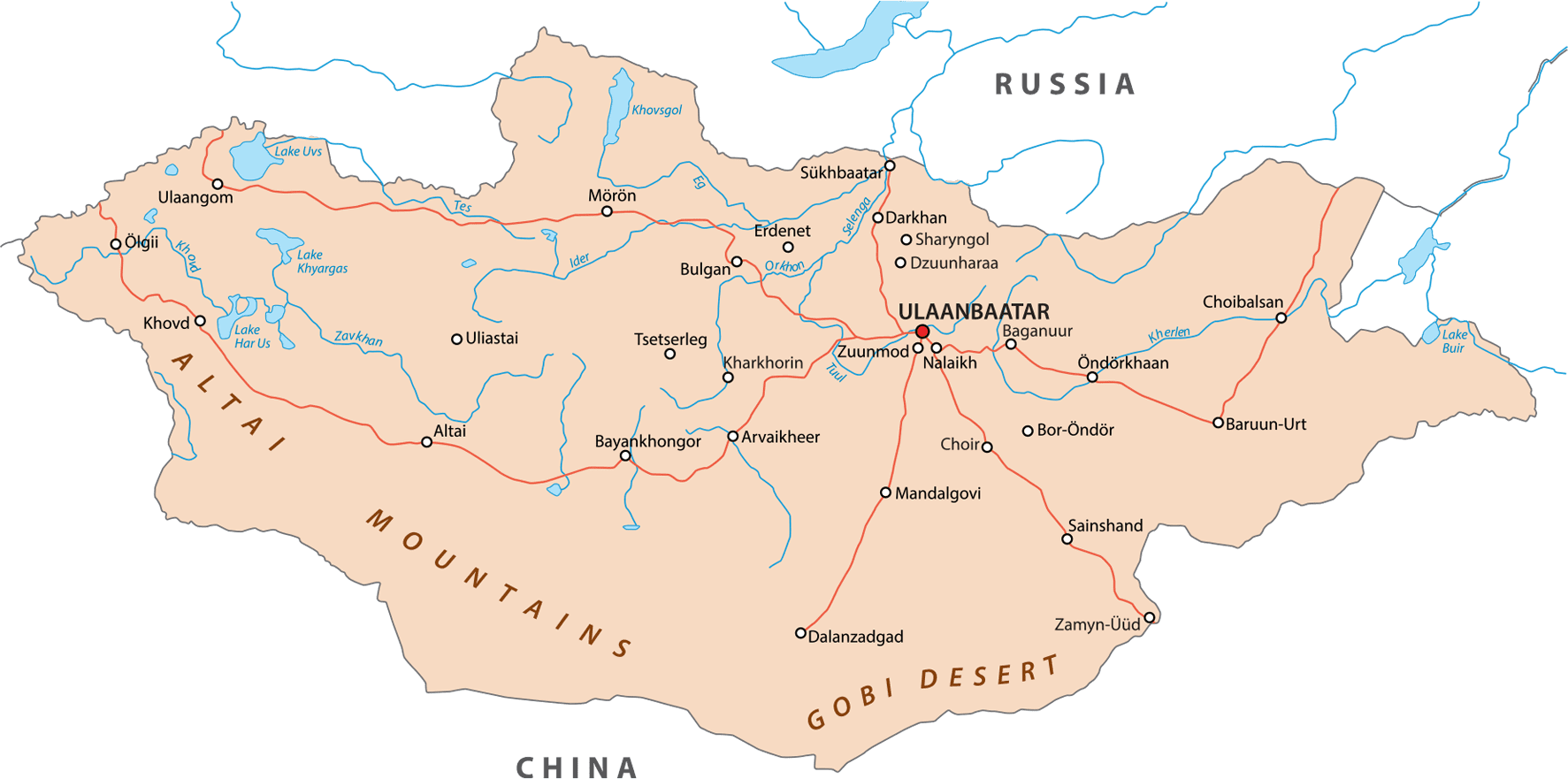
BEST TIME TO VISIT
May - October
Ulaanbaatar, ulaanbaatar (uln).
FEATURED JOURNEY
Golden Eagle Festival
Nomadic Expeditions co-founded the Golden Eagle Festival back in 1999 to help save the ancient art of golden eagle falconry practiced by the Kazakhs of Mongolia’s Altai Mountains as part of their age-old traditions.
DEPARTS OCT.
Returns oct..
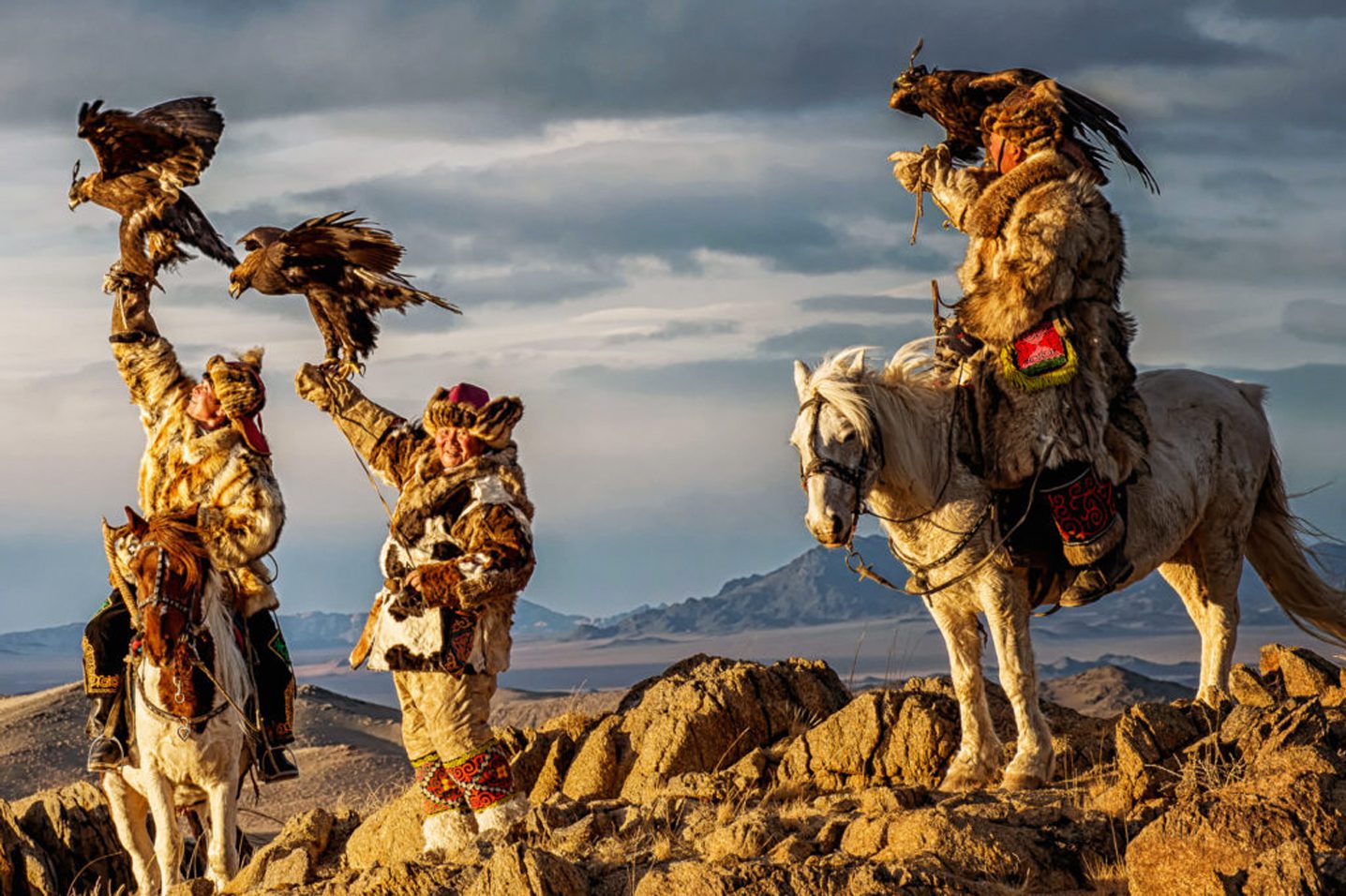
EXPLORE OUR MONGOLIA
Group Journeys
Interested in taking mongolian adventure with a group, find out more about our group mongolian journeys here..
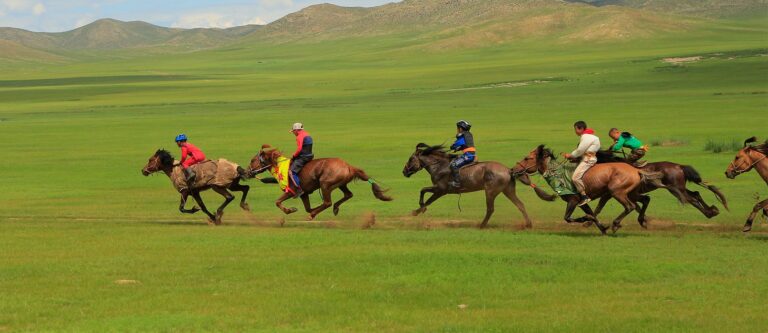
Naadam Festival
Dating back more than 2,000 years, the khans of Mongolia kept their soldiers in shape during times of peace by having them compete in games that replicated aspects of war. Join the celebrations surrou..
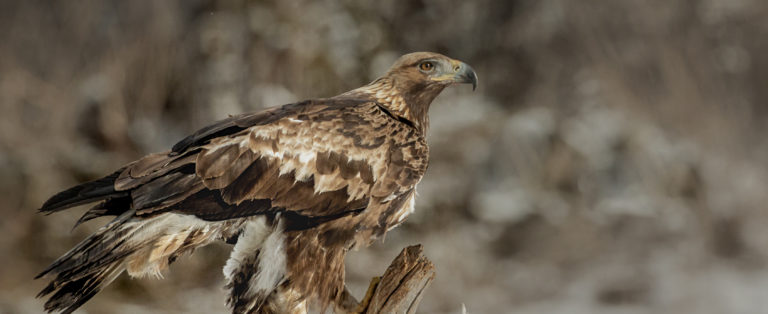
The Golden Eagle Festival
Join us for the Golden Eagle Festival in Mongolia’s Bayan-Ulgii Province! Each year, Kazakh hunters from near and far attend the festival for competitions based on the speed, agility, and accuracy o..
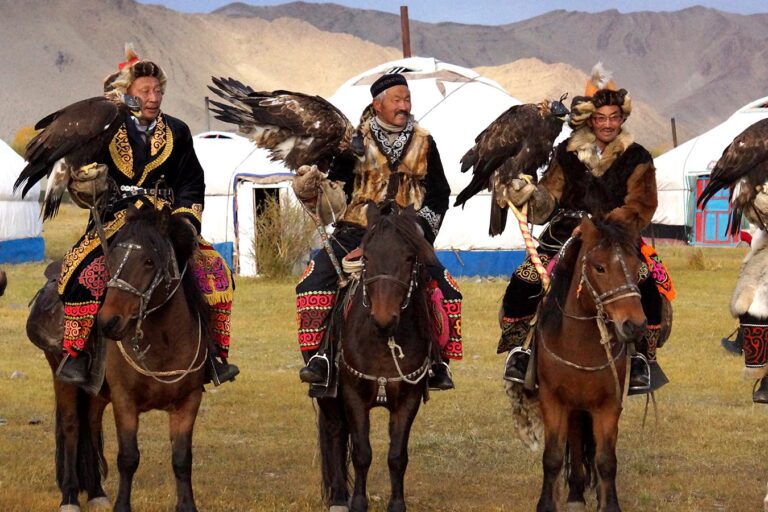
Golden Eagle Festival + Gobi
Join us in the mountains of western Mongolia for the annual Golden Eagle Festival before traveling to the legendary fossil beds of the Gobi on this unique and exciting adventure.
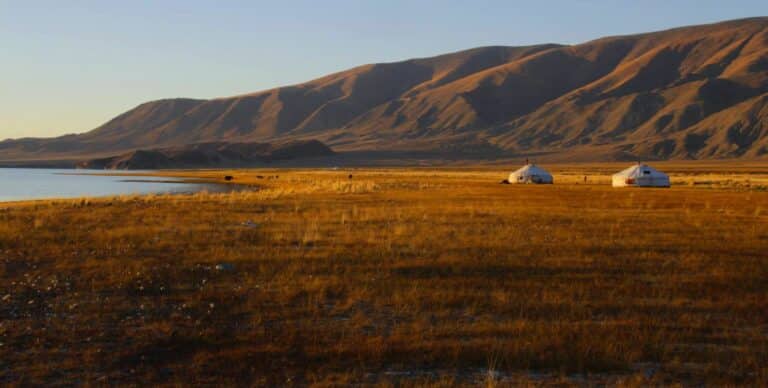
From the Altai to the Gobi
Undertake an adventure spanning two of Mongolia’s most dramatic destinations: the Altai Mountains to the West, and the Gobi Desert to the south. High in the Altai, you will meet local Kazakh familie..
Private Journeys
Our private journeys to mongolia are custom built for you. find out more..
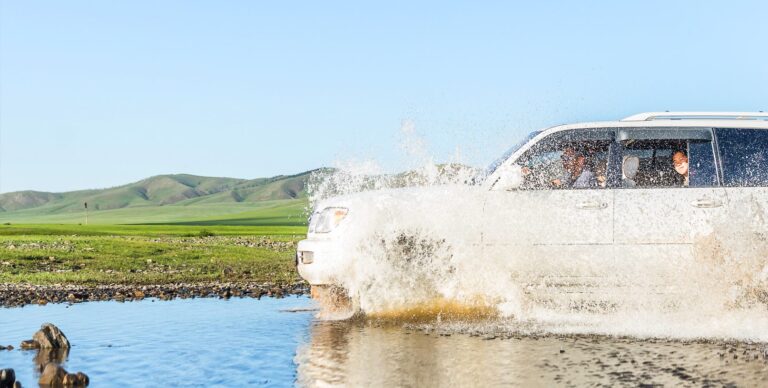
Mongolian Epic Overland Adventure
This epic off-road adventure showcases some of the most spectacular, varied, and historically important sites in Mongolia. Your journey will traverse the entire country from north to south using four-..
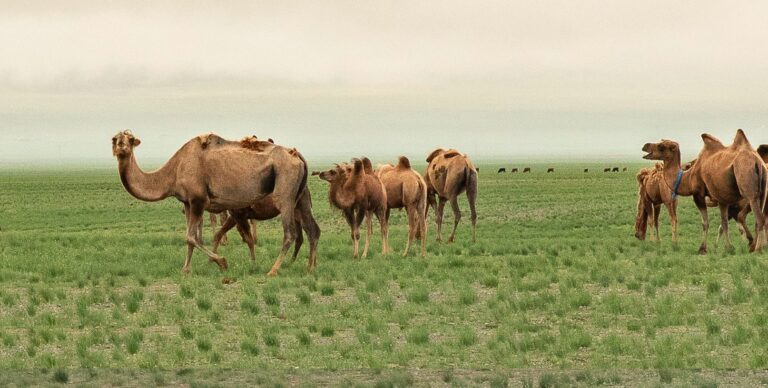
Gobi Desert – A Family Adventure
Traversing the undulating dunes on the back of a two-humped camel. Perfecting the art of the bow and arrow. Hunting for fossils in the middle of the Gobi. We know our Family Fun journey sounds as if i..
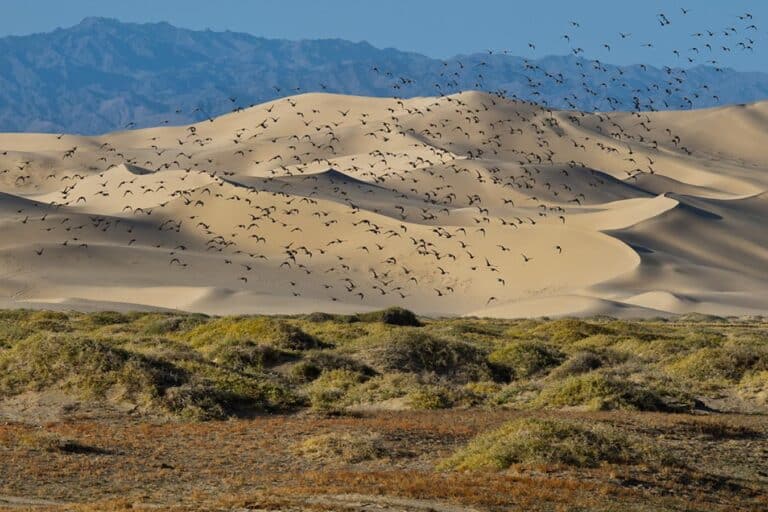
Ultimate Gobi
Journey into the heart of the Gobi Desert and discover its otherworldly beauty from every angle. Based at our luxurious award-winning Three Camel Lodge ger camp, you explore the multicolored granite r..
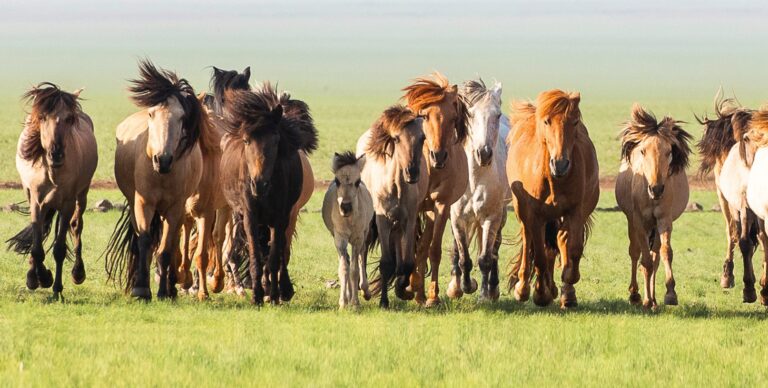
Horseback Riding in Mongolia
Designed for experienced horseback riders, this trek spans mountains, taiga forests, and idyllic meadows spending 6-8 hours daily in the saddle.
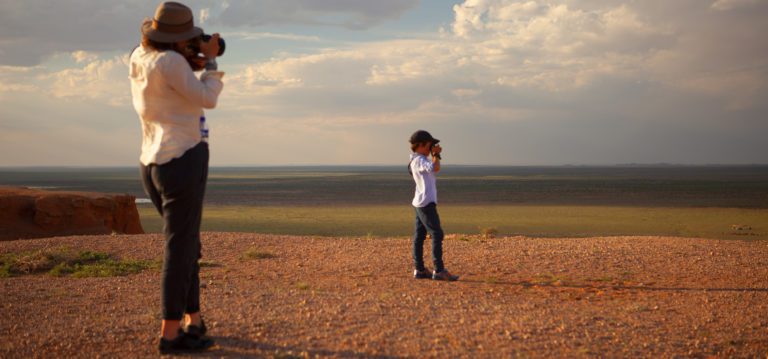
Mongolia Family Adventure
For more than a thousand years, the nomadic people of western Mongolia have hunted with golden eagles in the Altai Mountains in order to survive the harsh winters. Experience the annual festival celeb..
RELATED ARTICLES FROM
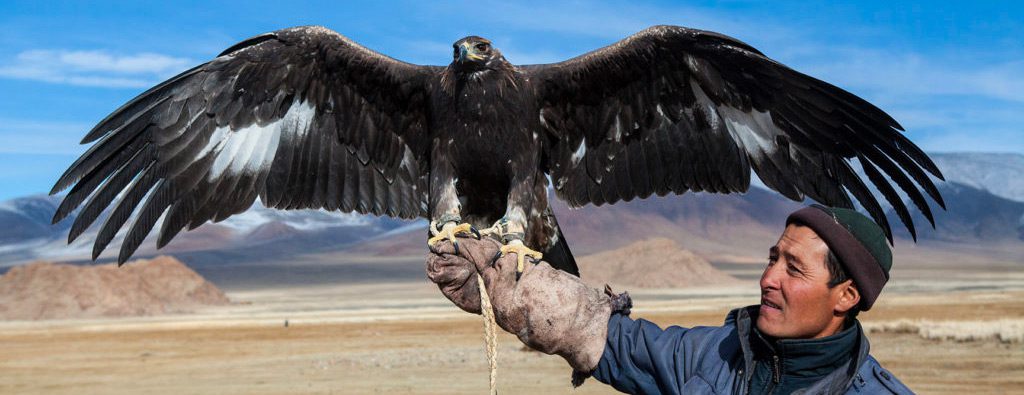
NOMADIC EXPEDITIONS LAUNCHES CONSERVATION PARTNERSHIP
Nomadic Expeditions, the award-winning eco-tourism company specialized in luxury adventure travel to Mongolia and beyond, was founded with a belief that travel makes the world a better place when it...
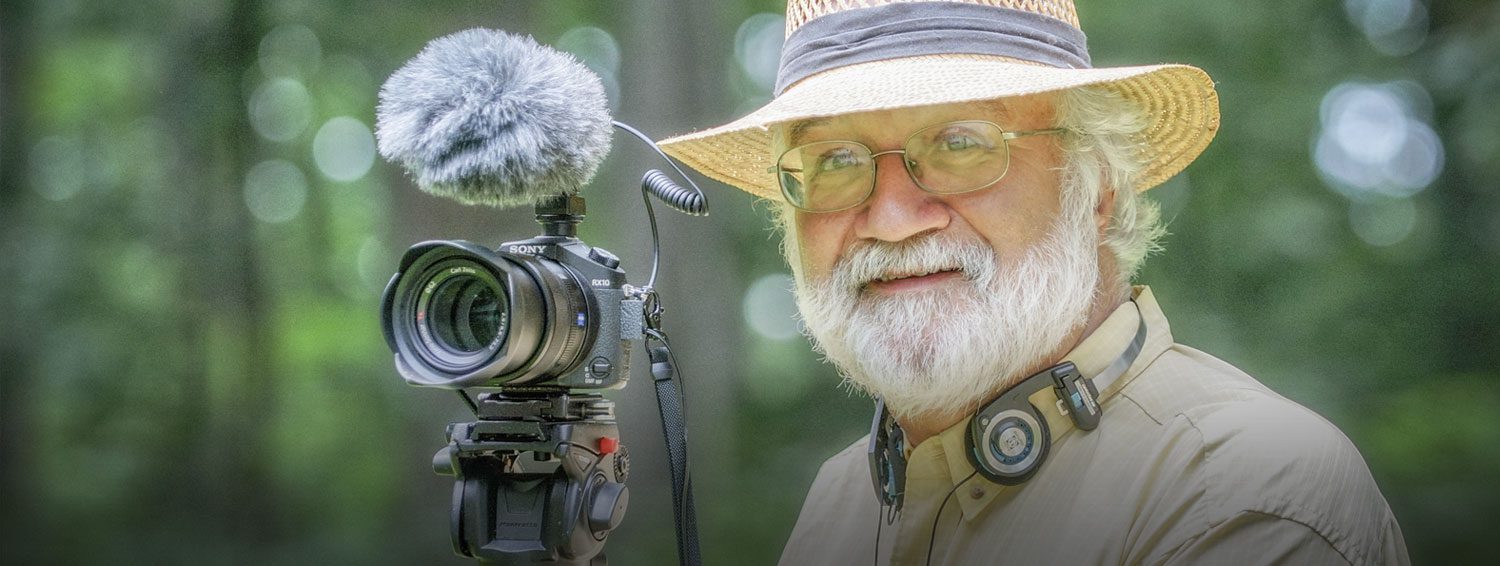
Musings on Mongolia with Bob Krist, National Geographic Photographer and World Traveler
Musings on Mongolia with Bob Krist, National Geographic Photographer and World Traveler “Who would you invite to a dinner party?” It’s a popular ice breaker, with answers often ranging from...
Find Yourself A World Away
Nestled in the heart of the Omnogobi Aimag, the Three Camel Lodge is tucked beside an outcrop bearing ancient petroglyphs. The authenticity goes well beyond the surface to create a true sense of place. From hand-carved wood furnishings created by local artisans to the well house crafted to resemble a miniature temple, there is no doubt you are firmly planted in the Mongolia’s Gobi Desert—surrounded by amenities of modern luxury.

Experience Mongolia with Nomadic Journeys
For 25 years, NOMADIC JOURNEYS has been the leading tour operator in Mongolia. We offer yak and camel treks, horseback expeditions, travel with nomads, as well as birding holidays, snow leopard expeditions, short self-guided trips and world class fly fishing tour along two of Mongolia’s rivers.
We also operate seasonal, fully collapsible yurt (ger) luxury wilderness camps along these rivers where we offer multi-day raft and kayak trips. Make your Mongolia trip memorable and join us for some sustainable travel in the slow lane, in close contact with local nomads and nature, as opposed to long, bone-breaking jeep and bus trips.
Explore our tours, treks and camps by location
Hover your mouse over any of the regions on the map to see our available travel options.
Range of tours to choose from
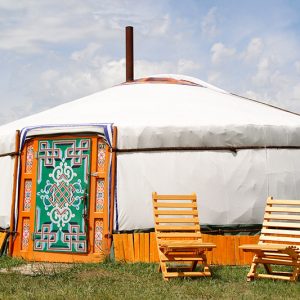
Subscribe to our mailing list
Featured tours.

Altai Mountain Ride

Mongol Horse Trails
What our customers say.
We have been back home from our recent nice trip and would like to take this opportunity to thank you for all the assistance you gave us in putting together our custom individualized trip to Western Mongolia. Everything went well and we did enjoy our trip and appreciate the expertise from you and your staffs.
Amazing and relaxing !
We stayed at Jalman Meadows for three days and wished we had arranged a longer stay. It is very remote and tranquil, all quiet, such beautiful nature, amazing views. We hiked up mountains and on flatlands, rode horses with local nomads for half a day. We also got to visit a local nomadic family in their home with the help from one of the staff who translated, and were able to ask questions about their daily life - so interesting! The gers are cozy, beds very comfortable and we slept like babies. Good food, and also available for vegetarians. Friendly staff.This was the very highight of our trip, we just loved Jalman Meadows.
This place is wonderful! They have excellent food, the location is fabulous and the activities are really awesome. We did the yak cart rafting and horse back riding. I highly recommend this place! The staff is thoughtful and very professional!
Simply the best camp we visited!
This was the best camp we stayed at, the attention to detail from mirrors in the gers to being able to get a hot drink anytime, made it exceptional. The staff could not do enough for you, from lighting the fires in the ger, to loading up the bucket in the shower ger. The food was good breakfast was very good. It's situation means that it cannot be seen from the main track. The gers were the best decorated & most comfortable of our stay in Mongolia.
Exotic experience
Delightful stay in a great camp where you live in a "luxury" Ger, eat delicious food and experience life in the desert. Camel Riding was a highlight. The toilet was clean and there was also a washbasin. The Camp has its own Ger where you can take a shower in warm water. The hosts were pleasant and helpful. I would recommend a stay here highly.
Wild Simplicity in a Glamping Environment
Leading up to my visit, I was researching places to stay where I could be away from social media and technology while soaking in the Mongolian wilderness. I came across Nomadic Journeys and Jalman Meadows Wilderness Camp seemed to fit that mold...
Gobi steppe ride was much more than I expected.
Gobi steppe ride was much more than I expected. Our horses and guides were absolutely fantastic. They made us feel welcome, well taken care of, safe and secure. The scenery, the horses and our guides were all delightful. The quality of the tents and meals were above what I expected. All of the elements were there -- people, horses, scenery.
For 25 years Nomadic Journeys has been a leading tour operator in Mongolia, focusing on low impact sustainable tourism. We work with numerous community groups and conservation initiatives around Mongolia. Our philosophy is to offer a low impact travel experience, visiting different places on horse back, yak cart, and camel cart over long difficult journeys on a vehicle. Read more

Phone: +976 11 330360
Email: [email protected]
Visit our Contact page for more details
SIGN UP TO OUR NEWSLETTER
I am a travel agent I am a regular customer
Share on Mastodon

- +976 99040894
- [email protected]

Golden Eagle Festival Mongolia 2024 -2025 Locally enjoyed festival

Horse Riding Mongolia – A journey off the beaten track

Horse Archery Mongolia 2024 Tour

Winter Reindeer Herders Mongolia – Dukha Adventure Tour
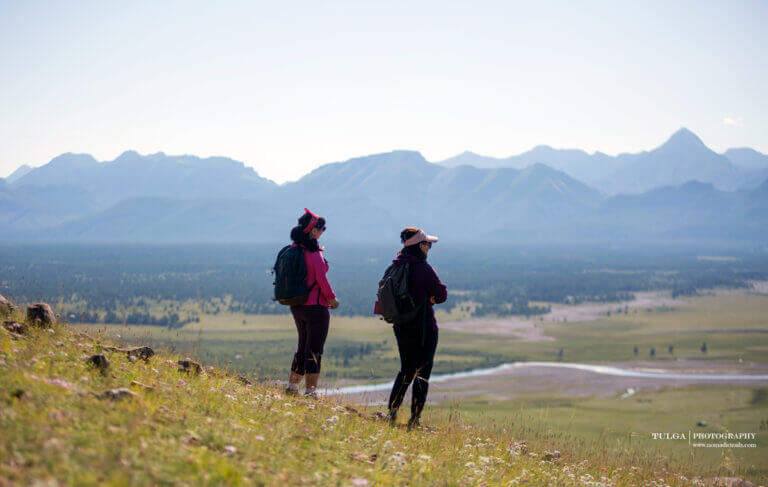
Tailor-Made Tours Mongolia
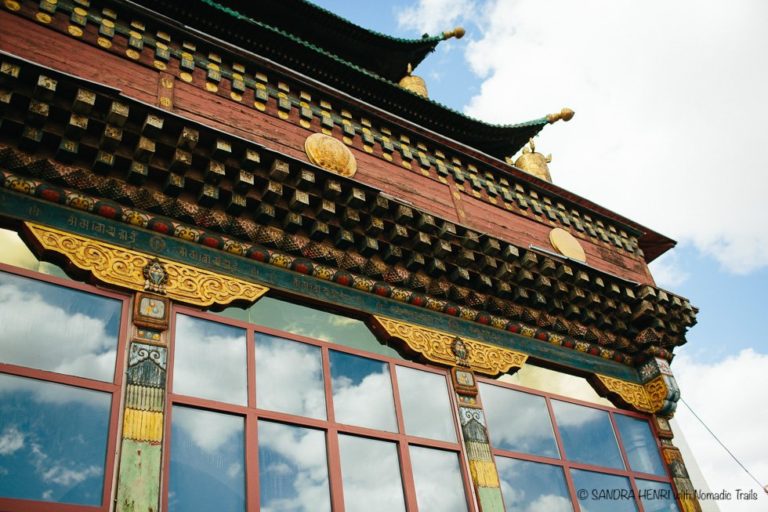
Ulaanbaatar City Tour
- Destinations
- Blogs and Articles
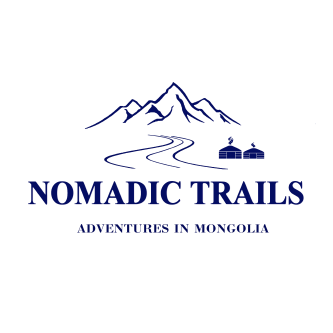
Best Selling Mongolia Tours of 20 years of our operation
Why nomadic trails, authentic experiences.
Our small group, custom and tailor made trips to Mongolia offer you an amazing adventure that ventures beneath the surface of the region.
COMMUNITY SUPPORT
We're a local Mongolian travel agency. We utilize our experience to break down barriers and provide ethical business for people from lesser-known areas with so much to offer.
VETERAN mongolian tour company
We are a well-established Mongolian adventure travel company. Nomadic Trails is successfully operating for more than 17 years as one of the ``A`` licensed best Mongolian tour companies.
FLEXIBLE AND HASSLE-FREE
We specialize in Custom tours. So tell us about your trip requirement. We'll work together to customize your adventure of a lifetime to visit Mongolia.
Middle-man free PRICING
When you book us, you get best possible prices, which is middle-man free. Get the best original Mongolia itinerary with a flexible cancellation policy.
FInd Your tour by region & Destination in Mongolia

Our Testimonials and reviews
- Continue reading...
thanks to Nomadic Trails. Tulga and everyone on his team were so accommodating to any of our requests and even helped us navigate our way through the local market and barter for souvenirs. Truly delicious food as well at every stop. Phenomenal all around. Thank y’all for everything! Unbelievable experience in Mongolia!
Tulga, our tour guide is very knowledgeable and helpful, his driving skills also worth a praise and believe me, on these roads, it is a big advantage for someone like me with a motion sickness. They provided a cook for us, who exceeded all of our expectations. If you want a truly amazing experience just go with them!
and he was able to provide a varied, personal, unique experience. I wanted to create my own personal itinerary and Tulga had the knowledge, contacts, experience and sense of adventure to make that happen. I’ll be returning in 2020 to travel with Nomadic Trails again. Can’t wait!
hopping on our horses to go to the Tsaatan reindeer tribe, then finally staying at one of the best camps in Murun. Everything was so well-organized. Noteworthy is Tulga’s relationship with the tribe, which is an important consideration when we were planning this trip as we want to be as respectful as possible to the tribe for them not to feel uneasy during our stay. Our group was delighted to have raw and authentic Mongolian experience without having to sacrifice comfort – we had delicious food, great accommodation and comfortable transportation all throughout our trip – thanks to the incredible team of Nomadic Trails!
Contact us:
- Call - Whatsapp: +976 99040894
About Nomadic Trails:
- Tour reviews
Popular blogs and articles:

Tour by category
- Adventure Tour Mongolia
- Best Selling Tour Mongolia
- Cultural Tour Mongolia
- Reindeer Festival Tour
- Reindeer tour Mongolia
- reindeer Tours mONgolia
- Short Tour Mongolia
- Tailor-Made Tour Mongolia
- Tours for EXPATS in Mongolia
- winter reindeer tour Mongolia
- Winter Tour Mongolia
- Copyright Nomadic Trails Co.,Ltd
Wild Mongolia

Member Savings
Sign in to see which companies give additional savings to Travelstride Members (it’s free)
- Enjoy the beautiful Three Camel Lodge, a celebrated ger camp in the heart of the Gobi
- Sundowners and a magical sunset at the Gobi’s Flaming Cliffs
- See the festival featured in the documentary The Eagle Huntress
- Watch Kazakh nomads compete on horseback and hunt with their trained eagles
- Meet local Kazakh families in their Gers
What's this trip about?
Compare to similar trips.

Nomadic Mongolia

Mongolia: Steppes, Deserts & Nomads

Golden eagle festival tour

Bhutan City Tours with Bumdra Trek and Homestay

2 Days - Antalya Tour From İstanbul
Travel themes.
- Family Friendly
- Festivals & Special Events
Destinations
Attractions.
- Altai Mountains
- Gobi Desert
- Ulaanbaatar
- Historic sightseeing
- Horseback riding & Equestrian
- Rock Climbing
- Ruins & Archaeology

Trip includes
- Expert leadership of a Wilderness Travel Trip Leader
- Accommodations in gers, the Three Camel Lodge, and a comfortable hotel in Ulaanbaatar
- All meals included except 2 Lunches and 2 Dinners
- Sightseeing as noted in the itinerary, including entrance fees for museums and sites
- Land transportation and airport transfers
View Similar Trips

Roaming Western Trails

9-Day Special Package: Madrid and Andalusia - English Monolingual

14 Days / 13 Nights Maasai Mara and Foster Elephants Safari Tour

Kenya, Zimbabwe, South Africa & Egypt in 28 days - Essence of Africa - Luxury

Bird Watching Safari In Kenya

Want a tailor-made trip instead?
Your trip, your way, planned by an expert:.
- You choose budget, destinations, activities, transport & lodging type
- Expert designs the itinerary for you, and once approved, takes care of logistics
Dates & Availability
Check Current Availability, prices, specials with Wilderness Travel .
The total tour cost includes the tour price (regular or promotional) and the compulsory local payment. The promotional price is subject to change. Check directly with the operator for the latest price offer. The tour operator requires you to pay only the tour price to purchase your travel. The compulsory local payment will be paid when you join the trip. All prices are based on double, twin or triple share occupancy. Solo passengers will be accommodated in a double, twin or triple room according to availability with a passenger(s) of the same gender. Single supplement only needs to be paid if the passenger does not want to share and requests their own room. Discounts can only be applied at the time of booking and cannot be added at a later date, regardless of any changes made to the original booking.
Prices may vary due to local taxes and trip seasonality. Click "Request Info" to inquire directly with the tour operator for the final trip price.

Wilderness Travel Reviews & Ratings
Other wilderness travel reviews, outstanding cultural adventure.
I have taken 13 trips with WT, most recently a marvelous adventure in Viet Nam and Cambodia. Always difficult to name a favorite since their trips offer such a great...
Some of the most memorable experiences I've had
We’ve taken nearly a dozen trips with this outfit and they are first rate. Some of the most memorable experiences I’ve had. Their guides are exceptional (except one!...
Consistently Excellent
I love traveling with Wilderness Travel! My husband and I look forward to their catalog every year to see what new adventures they have cooked up and our bucket list...
See all Other Wilderness Travel reviews
Travelers also viewed

Classic Northern Italy

7 Days Highlights of Vietnam

Sri Lanka: See & Experience it ALL in 10 Days, 1st Class Custom Tours

Discover Vietnam, Cambodia, Thailand in 22 Days
Tour operator, wilderness travel.
For more than 30 years, people have entrusted their travel dreams to us. Our adventures span every corner of the globe, and the quality of our itinerary design and leadership has earned us one of the highest rates of repeat travelers in the business. Our core philosophy is elegantly simple: it’s not just where you travel, but how you travel that sets our trips apart. The magic of the how at Wilderness Travel comes from our expert Trip Leaders —the undisputed best in the business, a meticulously planned and artfully executed itinerary, and the camaraderie and just plain fun of traveling with a small group of like-minded people. The where is up to you—read on for more about our amazing destinations!
At Wilderness Travel, we firmly believe that responsible tourism can be an extraordinary tool to connect people across borders and cultures. Our commitment to ecologically responsible, low-impact tourism goes back to the beginnings of the company, and we actively support a variety of conservation and cultural groups, and are founding members and active supporters of a number of organizations dedicated to responsible travel.
Everywhere we travel we bring our own special Wilderness Travel style along. In Europe, we stay at charming small hotels where we are welcomed as family, and enjoy elegant picnics of delightful local specialties and fine wines. In Africa, our safari camps are downright luxurious and our exclusive lodges are located with exceptional access to wildlife. Our Himalayan and Andean treks feature our celebrated full-service camping amenities: you’ll sleep comfortably at night in warm sleeping bags in cozy mountaineering tents, dine on wonderful and varied camp meals, and wake up each day to a cup of hot coffee or tea brought right to your tent!
A great trip is made up of fine hotels, glorious hikes, superb cuisine, and most importantly, a Trip Leader whose passion and knowledge brings it all together. We’re particular about who leads our trips because your experience depends so much on their skills. Our leaders come from all over the world, and from all walks of life—our roster includes naturalists, authors, teachers, archaeologists, art historians, and mountaineers. Their backgrounds are diverse, but they all share a passion for guiding, a thorough knowledge of the destinations they work in, and a real joy in introducing you to their favorite places, people, and behind-the-scenes spots you would never find on your own.
About Travelstride
Find your perfect trip, travel confidently, what's excluded.
- International airfare
- Any meals not specified after each itinerary day
- Optional gratuities to leaders or staff
- Additional hotel nights that may be necessitated by airline schedule changes or other factors
- Pre-trip expenses of medical immunizations (if any)
- Travel insurance, or passports and visas
- Other expenses of a personal nature (alcoholic beverages, laundry, etc.).
Accommodation
- Up to 91 days prior to departure: We don't charge one!
- 61-90 days prior to departure: 25% of trip cost
- 46-60 days prior to departure: 50% of trip cost
- 45 days or less: 100% of trip cost
Cancellation and transfer schedules for certain group trips, as well as cruises, private departures, extensions, and Special Events are often more strict. These exceptions are clearly indicated in the detailed itineraries for each of these trips.
Rates are based on group participation and no render refunds will be given for unused trip arrangements for any reason whatsoever. Once you have been confirmed on a trip that requires a medical certificate signed by a doctor, normal cancellation penalties apply if your doctor does not sign the certificate.
Moderate: Half- to full-day hikes (3-6 hours) over rolling countryside on most days, occasional steep trails. Many of our hotel-based walking tours are in this category, as are our snorkelling adventures.
Become a member
- Save up to $700 per person
- Access members-only specials
- Personalize trip recommendations
Tour Companies
Things to do, itineraries.
Wild Mongolia
15 days | travel to mongolia to discover a remote pocket of asia.

Travel to Mongolia and experience the raw beauty and tradition of this remote region. Hidden from the world for so long, it is hard to imagine that this secluded country once created the largest land empire ever known. Unmatched geographical diversity, pristine grasslands, crumbling ruins and roaming herdsmen riding tough Mongolian horses – see it all on this journey through a land that time forgot and travellers are now discovering.
Trip overview
- Mongolia is a far-out destination, but you'll be in excellent hands. Your experienced drivers, manning sturdy Russian vans fit to tackle the rugged environment, will take you on a ride to some of the most fascinating places in the country
- Whether by camel or on foot, experience Mongolia's incredible landscapes, from the rolling dunes just outside of Karakorum to the volcanic craters of the Great White Lake among the mountains
- Two family ger camps allow you to experience nomadic life from the inside – a rare and rewarding cultural experience to remember
- Situated in the valley of the Delger River, the Tsenkher Hot Springs offer the perfect place to relax and unwind after a long journey on the road
- Most gers at the tourist camps sleep up to 3 to 4 people, with comfortable beds and blankets. Simple western style toilets and shower facilities are shared on the camp, although water pressure can be unstable and only luke warm.
- At our family ger camps you will be living the same life as the nomads, close to the land and their animals. Beds may be matresses on the floor in a shared ger and there will be no bathroom facilities. This is a true taste of Mongolian life and may be very different from what you are used to. You will need to bring a sleeping bag with you for these stays.
- Most meals are included once we leave the nation's capital. If you have very specific dietary requirements you will need to let us know well in advance. We will do our best to cater for you, but you may need to be prepared to bring some of your own supplies from home, or stock up at the supermarkets in Ulaanbaatar. Vegetarians can be catered for, though choices may be limited. Some food will be traditional Mongolian style, but as the traditional diet consists solely of meat and dairy products, most meals made for our groups are less challenging and based more on Russian or Western cuisine, which is now also common in the Mongolian diet.
- This is a trip that includes extensive travelling in some remote terrain away from modern facilities and conveniences. As we spend a lot of time on the road each day, it is important to realise that the emphasis on this trip is on the journey, travelling through amazing landscapes and staying in some stunning locations. As we travel by private transport for the duration of the trip we spend a lot of time together with our group members. If you are looking for an active or independent trip with lots of choice for physical and cultural activities daily then you might want to consider whether this trip is the right one for you. However, if you are keen to explore a fascinating country "road trip" style, take in the scenery as you go and are willing to sit back and enjoy the ride (however long it takes to get there!) then this will definitely add to your experience of our Wild Mongolia trip.
- Driving times will vary and any times listed in the itinerary are approximate and subject to road (where there is one!) and weather conditions. As we have our own vehicles, it may be possible to make stops along the way for photos, meals or to chat with locals, but we need to aim to get to our destinations before nightfall so please understand that long breaks may sometimes not be possible.
Sainbainuu! Welcome to Mongolia. You can arrive at any time before your group meeting at 6 pm. Please have your passport, insurance and next of kin information ready to give to your leader at this meeting. Afterwards you'll have the option to join your fellow travellers for dinner at a local restaurant. If you arrive in town earlier and have time, be sure to get out and explore 'UB', a fascinating town where elderly Mongolians in traditional dress mingle with the nation's young business elite. A great place to start is Gandan Khiid, Mongolia's largest and most important monastery. The Fine Arts Museum, Winter Palace Museum of Bogd Khan and Intellectual Museum are also well worth visiting.
- Hotel (1 night)
There are no meals included on this day.
- Ulaanbaatar - Fine Arts Museum - MNT8000
- Ulaanbaatar - Gandan Monastery - MNT4000
- Ulaanbaatar - National History Museum - MNT20000
- Ulaanbaatar - Winter Palace Museum of Bogd Khan - MNT8000
- Ulaanbaatar - Intellectual Museum - MNT8000
- Ulaanbaatar - Chinggis Khan museum - MNT30000
Due to the fact that much of Ulaanbaatar's infrastructure lacks regular maintenance, you may only have sporadic access to hot water at our hotel and other accommodation throughout the trip.
Today your adventure begins as you drive out through the beautiful Mongolian countryside. Most of the drive today is on paved roads, but be prepared for some bumps after the final turnoff to the the remote Amarbayasgalant Khiid. Your leader and drivers will be glad to teach you some basic Mongolian words on the way – a great way to prepare for interactions with the locals, few of whom speak English. Your final destination today is Mongolia's second most important place of worship (after Gandan Monastery in UB), situated in the beautiful Iven Gol River valley, at the foot of Burengiin Mountain, in the Selenge province. After seeing the monastery, you will get your first taste of life in a ger at the first camp of the trip. This is the way that the majority of Mongolia's population has always lived – away from the city and in the wide open spaces of seemingly endless countryside. It's the quintessential Mongolian experience. Although such camps are set up for visitors, this type of housing is still used around the country, even in the capital where you will have seen many 'ger suburbs' surrounding the city centre. Our drivers and leader also often double as our cooks in those places where we prepare meals ourselves. You are always welcome to lend a hand too! We share our meals together in the dining quarters. Vegetarians can be catered for although choices may be limited - please let us know if you have any specific dietary requirements at time of booking. Breakfast, lunch and dinner are provided each day until our return to Ulaanbaatar. Some food will be traditional Mongolian style but as the traditional diet consists solely of meat and dairy products, most meals are less challenging and based more on Russian or Western meals which are now also common in the Mongolian diet.
- Tourist Ger Camp (1 night)
- Amarbayasgalant - Monastery
Our transport for the trip are sturdy and reliable vans, known as 'furgon'. These are definitely the best way to tackle the Mongolian roads that await us! Please note that depending on the size of the group we may be split into a number of vans. Your leader will take it in turns spending time with each van and you are welcome to swap around so that you get a chance to spend the travel time with different members of your group. There's plenty of driving on this trip across some rough terrain but the experience of our drivers will make the journey pass as smoothly as possible. Driving times will vary and any times listed here are approximate only. Actual travel time will rely heavily on weather and road conditions. As we have our own vehicle it may also be possible to make some stops along the way for photos, meals or to chat with locals however we need to aim to complete our drives before nightfall for safety reasons. Most days we drive up to 9 hours total. Mongolia is a vast and sparsely populated country so in order to see as much of the landscape and culture in the two weeks that we have we cover some large distances on this trip. The gers at the tourist camps on this trip where we stay most nights vary in standard and facilities. Most sleep up to 3 to 4 people with comfy beds and plenty of blankets. In the colder months you might want to stoke up the stove in the centre of the ger and you'll be toasty warm in no time! Some have generator or mains electricity although not all have power sockets in the gers to charge electronic equipment.
Continue to the lovely Selenge River via the copper mining town of Erdenet (approximately 7 hours including stops). There may be opportunities to spot some interesting wildlife along the way, such as marmots and many different species of birds. You will arrive at your ger camp in the settlement of Unit in the afternoon. Stretch your legs on arrival and take a walk up to the Togoo Uul (Pot Mountain) – an extinct volcano looming over the surrounding steppe. The hike to the top rewards you with views of the crater's lush interior. From this vantage, you can only imagine what this incredible landscape must have looked like millions of years ago.
- Selenge - Uran Togoo hike
Today your journey (approximately 7 hours including stops) brings you to the mountainous outskirts of Ikh Uul for your first stay with a local nomad family. This is a rare opportunity to see how modern Mongolian nomads are preserving an ancient way of life while embracing some elements of modernity. You will be welcomed into the family ger and shown traditional Mongolian hospitality, starting with a bowl of salty milk tea and perhaps some aaruul (dried curds). This evening you will help your hosts prepare dinner – maybe some buuz (steamed dumplings) or barbecue. Many nomad families keep animals, so don't be surprised if there is some interaction with goats, dogs, horses and sheep. The location is remote, with no nearby settlements or light pollution. The night sky is incredible in clear weather, so be sure to do some stargazing before retiring for the evening.
- Family Ger Camp (1 night)
As the conditions are very basic here this family stay may be a culture shock for some. There are no toilet facilities as such; your leader will point you in the right direction of the 'bathroom'. You will sleep in a mattress on the floor of one of the family's gers. It can get very chilly here in the evenings, so warm clothes are essential. There is also a one-camera policy on these homestays, which makes for a more immersive engagement with hosts and minimises intrusion. This is one way you can live the philosophy of responsible travel while in Mongolia. (Photos can be copied and shared among the group back in UB.) It's Mongolian tradition to bring some gifts when visit another family so we advise that you may wan to consider bringing some small gifts for the family ger stays on this trip. Your leader will be able to advise what's appropriate and it would usually cost about 3-5 USD.
Enjoy breakfast with our host family and bid them farewell. It's another long day of driving today, across some rough terrain, to Khovsgol Lake (approximately 7 hours including stops). Some say this is Mongolia's most beautiful destination, a pristine wilderness area that's home to many ethnic minorities. It boasts spectacular scenery with stunning fir forests, lush green grasslands and meadows peppered with wildflowers. Since it is a popular destination for both foreign tourists and local holiday makers, you will likely come across other travellers here, especially in the peak travel months of June and July. On the way, stop at Uushig Valley and check out the unique Deer Stones that are representative of Bronze Age religion, culture and society significance. Tonight, you'll stay in a tourist ger camp just near the lake. Settle in for the night and sleep well, because there are plenty of optional activities to choose from tomorrow.
- Uushig Valley - Bronze Age Deer Stone Monuments
Today you might like to hike up to one of the nearby peaks or perhaps take a boat trip out on the lake. Explore on foot and relax on one of our few days not on the road. All of these are great ways to experience this gorgeous region. Overnight in the tourist ger camp again tonight.
- Khovsgol Lake - Boat trip - MNT30000
While you're here the camp staff might offer you the option to visit a local settlement of reindeer herders. These reindeer are brought to Lake Khovsgol from other regions so that the herders can benefit from tourism. This area, however, is not ideal for these animals, as they are native to much colder climates. For this reason, Intrepid does not recommend or support this activity.
Today we will set off early to drive back through the town of Murun, and on to Shine Ider (approximately 8 hours on dirt road, including stops). Here you will enjoy the second family stay of your trip. Now that you know what to expect from a Mongolian homestay, you should feel more comfortable the second time around. Get to know your hosts as you help them prepare for an exciting Mongolian style BBQ dinner and get to know all the importance of meat in their diet and how Mongolian characters are intertwined with their food and cooking. You might even have the chance to watch as the family's livestock are milked and herded.
- Family Ger Camp - Home-cooked Mongolian BBQ Dinner
After breakfast with the family, we'll drive to the surreal Lake Terkhiin Tsagaan, aka the Great White Lake (approximately 9 hours on dirt road). This natural volcanic lake, surrounded by mountains, is a surreal and memorable sight. Depending on where you'll be for tonight, you might drive up to one of the volcanic craters and hike to the top for spectacular views. There are plenty of nice trails to walk during your two-night stay here, so make the most of this relaxing break from the road.
- Tourist Ger Camp (2 nights)
- Breakfast (2)
Travel to the Tsenkher Hot Springs (approximately 6 hours). These are situated in the valley of the Delger River. On the way, you'll stop at Tsetserleg, a provincial town with a local market and a unique little museum housed in a former temple, which you'll visit with a local guide. At this stop, there's the chance to wander around the town for a glimpse at what provincial Mongolian life is like. Perhaps stock up on some snacks and drinks for the travels ahead. From here it's about another hour to the hot springs, where you'll check into the tourist ger camp on arrival.
- Tsetserleg - Museum
Enjoy a Mongolian archery lesson today and then have the rest day free to relax, explore, or simply laze about in the thermal waters of these invigorating natural hot springs. Be sure to pack your swimwear so you can take part in this activity. Surrounded by the remote beauty of the landscape, this location is perfect for slowing down to a more meditative pace and taking it easy. There are also optional hikes and activities on offer if you'd prefer something more active.
- Tsenkher Hot Springs
- Tsenkher - Archery lesson
Continue to Karakorum (approximately 4 hours), a town built by the legendary Genghis Khan in the 13th century. Ask your leader and drivers to tell you some stories about this great man on the way – after all, he's the nation's hero. In Karakorum you will visit the first Buddhist centre of Mongolia, the immense Erdene Zuu Monastery. This impressive walled compound retains much of its former glory, and within it you can inspect the three temples, each one dedicated to a different stage of a Buddha's life – child, adolescent and adult stages. Later in the afternoon, you will drive to Khogno Khan, the location of your tourist ger camp tonight.
- Karakorum - Erdenezuu Monastery
- Karakorum - Karakorum museum - MNT15000
Just nearby Karakorum is a sudden strip of sand dunes – a striking contrast to the landscape you have just travelled through. Here you will enjoy a camel trek along the dunes – an ideal way to experience this eye-popping landscape. The follow your leader on a short hike to the ruins of an old local monastery. The afternoon is yours to spend as you please.
- Khogno Khan - Camel ride
- Khogno Khan - Hike to local monastery
Travel back across the rolling grasslands to Ulaanbaatar (approximately 8 hours). The route will take you past 'ovoos' (roadside shrines) and ger suburbs. Arriving in the metropolis, you'll check back into your hotel. Depending on the arrival time, there might be the chance to shop for some local handicrafts such as cashmere and felt products, or check out some more of the city's sights and museums. Tonight you can celebrate your journey around Mongolia by witnessing a special cultural performance featuring throat singing and traditional dancing. There will be an optional final dinner at a local restaurant recommended by your leader.
- Ulaanbaatar - Cultural Performance
Say 'bayartai' to your group as your adventure draws to a close. There are no activities planned for the day, and you're free to depart the hotel at any time before 12 noon. If you'd like to stay longer in UB, it's recommended that you book additional accommodation well in advance.
14 breakfasts, 13 lunches, 12 dinners
Private vehicle (Furgon van)
Tourist Ger Camp (10 nights), Family Ger Camp (2 nights), Hotel (2 nights)
Dates and availability
Important notes.
1. A single supplement is available if you’d prefer not to share a room on this trip. The single supplement excludes Days 4, 7, 10 &11, where you will be in shared accommodation and is subject to availability. Please speak to your booking agent for further information. 2. A sleeping bag is required for the Family Ger Camp stays. You can bring your own, or hire one in Ulaanbaatar for 20 USD for the trip. Please let your booking agent know if you would like to hire one. 3. Please provide your full passport details to your booking agent no later than 40 day prior to departure. 4. Some destinations on this trip are at up to 2500m
Want an in-depth insight into this trip? Essential Trip Information provides a detailed itinerary, visa info, how to get to your hotel, what's included - pretty much everything you need to know about this adventure and more.
Filter by rating
- 30+ Years Experience in Wilderness Guiding
If you have an interest in touring Mongolia on horseback soon or someday, please sign up for our periodic tour updates.
We promise we won't sell, lend, or otherwise share your email with anyone else.
- Search for:

No products in the cart.

- Trained Trail Horses
- Quality Saddles
- Camping in Comfort
- EcoTourism in Practice
- Conservation and Community
- The Stone Horse Logo
- Photography
- Free E-Book!
- Testimonials
- Gorkhi Terelj National Park Summer Ride – 10 Days
- Wilderness Conservation Adventure – 14 Days
- Autumn Colors of the Khentii – 12 Days
- Autumn Riding Camp – 10 Days
- Gorkhi Terelj National Park October Ride – 8 Days
- Short Treks and One Day Trail Rides
- Mongolian Gobi Camel Festival
- Winter Camel Trekking
- Gobi Winter Camping Adventure
- Gobi Desert Tour – 6 Days
- Gobi Crossing – 10 Days
- Mongolia Adventure Tour – 16 Days
- Wildlife and Landscapes of the Desert Steppe
- Hustai Nuruu National Park – Day Tour
- Reservation Information
- Important Information
- Equipment List
- Today’s Mongolia
- Travel to Mongolia
- Frequently Asked Questions FAQ
- Additional Payment
- COVID-19 Info
Our Horse Riding Expeditions in Mongolia
Destinations of our horse riding expeditions in mongolia 100 dollars loan.
Chingiis Khan roamed these mountain areas as the boy Temujiin. The Khentii Mountains are the backdrop of our horse riding expeditions in Mongolia. They hold the Gorkhi-Terelj National Park and the Khan Khentii Special Protected Area. It is a mystical place in history, this, the largest of Mongolia’s wilderness. We escape the modern world, and by horseback are greeted to breathtaking scenery with each new day. Make this your destination to nature, your destination to rediscover yourself.
Gorkhi Terelj National Park Expeditions
Ride in Scenic Landscapes shaped by Nomadic Traditions
Gorkhi Terelj National Park is great country for horseback riding and exploring – wide open valleys and rolling hills, trails along rivers, over forested passes, down through high grasses to discover another valley. Explore the hills and grasslands, rest below rock formations arising from the steppe. Experience true hospitality and the ambiance of a Mongolian Ger (more known as Yurt in the West). Live the local culture, and be at ease with your horse – be at ease with nature.
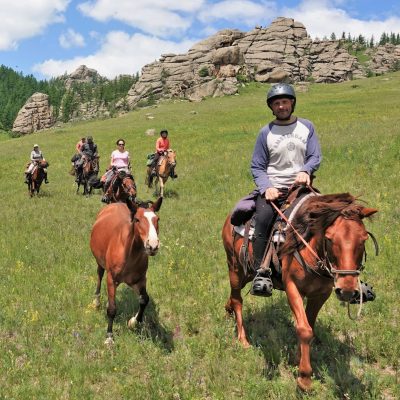
Summer horse trek
Gorkhi Terelj National Park Horse Riding – 10 Days
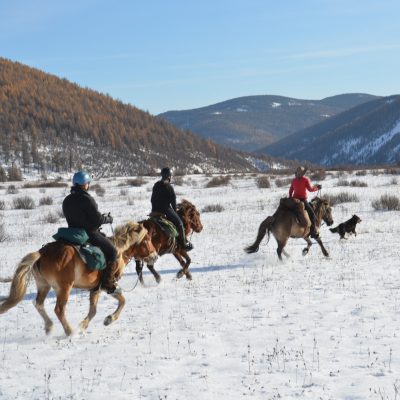
Autumn Riding
Gorkhi Terelj National Park Expedition – 8 Days
Khentii Mountains Expeditions
Journey into the Heart of the Taiga Forest
Challenge your spirit of adventure. Enter the Khan Khentii, steeped in the spiritual history of Mongolia. Its wildness will reward you with magnificent scenery, and the solitude of the Northern forest. Follow ancient horse trails to the sources of the rivers. Encounter wildlife. Make a high mountain passage with our pack horses. Stop at alpine lakes. Enjoy camping comforts in the wild. Bond with your horse – and listen to the silence.
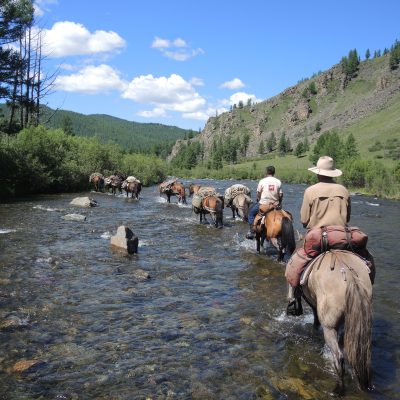
Khentii Mountains Horseback Expedition
Mongolia Wilderness Conservation Adventure
Your Riding Experience with Stone Horse Expeditions
Your riding experience begins with a good horse, your trusted travel companion as we move across the landscape. Our expert staff and trip leaders guide you through magical scenery, across rivers, mountain passes and down flower filled valley’s, where our comfortable camp awaits at days end. Tomorrow, another day of discovery as you fall asleep under a star filled sky.
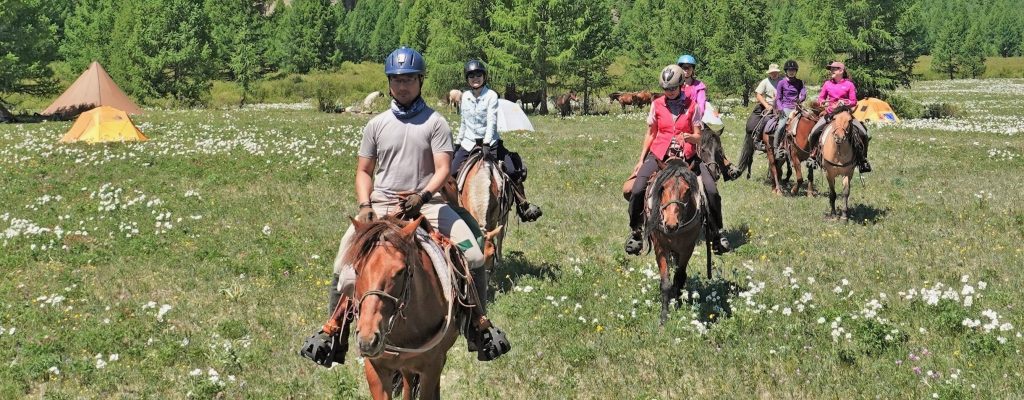
Experienced Trail Horses
Our horses are experienced expedition saddle and pack horses, all from our own herd. We pay attention and ensure you will ride in confidence and comfort.
- We match your trail horse to your riding level
- The horse you ride is cared for year-round , with veterinary checks and winter feeding
Comfortable Saddles
Our saddles are high quality, purpose build saddles from our own saddlery, designed for comfort and safety of horse and rider
- Western trail riding saddles, lightweight and durable
- Fitted with safety features
Small Groups
On your riding adventure with Stone Horse, you travel in small groups. Ride in an atmosphere of mutual support and fun. Enjoy good company and conversation at the dinner table. Leave with lasting friendships forged.
- Small group travel, maximum 6 guests
- All riding levels
Leave only Hoof Prints
We have worked for many years with the park authorities and communities adjacent to the parks we visit, and we adhere to a high standard of eco-friendly back country travel.
- Low impact travel, ecologically sound wilderness camping
- No vehicles – pack horses only. Short distance vehicle travel to base camp
Camping, Food and Drink
Attention to detail is foremost on our minds when we prepare meals, plan and set-up camp, provide your camping gear and ensure safety of drinking water.
- Scenic camp sites, quality equipment
- Camp cuisine, international and local, to your individual needs. Safe drinking water.
Expedition Leaders on Stone Horse Riding Expeditions in Mongolia
We have worked in conservation and wilderness travel throughout our careers. We lead our own expeditions – because we love doing it.
- 35+ years experience in wilderness travel. Committed to conservation and community
- Member “Travelers against Plastic”. Winner “Global Energy Award, Mongolia, 2017”
“ An Adventure of a Life Time – “I loved every minute, the horses were lovely and very responsive, the countryside was wild and beautiful, the saddles comfortable and the food that was produced out of a tiny tent was indeed amazing (including freshly ground coffee every morning and wine at night). Everything was well organized but at the same time very relaxed.” Trish Durlacher, Sydney, Australia.
Learn more about the Stone Horse Standard .
Check out the schedule of our horse riding expeditions in Mongolia for 2024.
Other adventures in mongolia, our gobi desert tours.

Gobi Tour 6 Days
Gobi Desert Tour
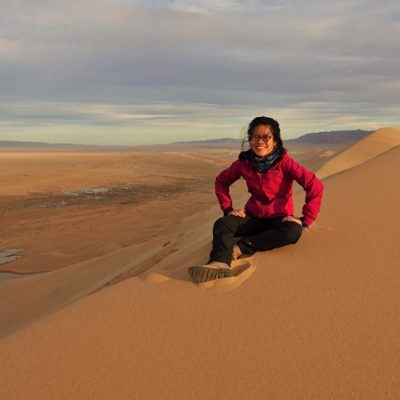
Gobi Tour 10 Days
Gobi Crossing 10 Days
See the 2024 schedule of Gobi Tours
- Newsletter Signup
Username or email address *
Password *
Remember me Log in
Lost your password?

Borders Of Adventure
Leading Culture and Adventure Travel Blog by Becki Enright. Looking at the world with a different angle to change perceptions of misunderstood places, for the best in travel.
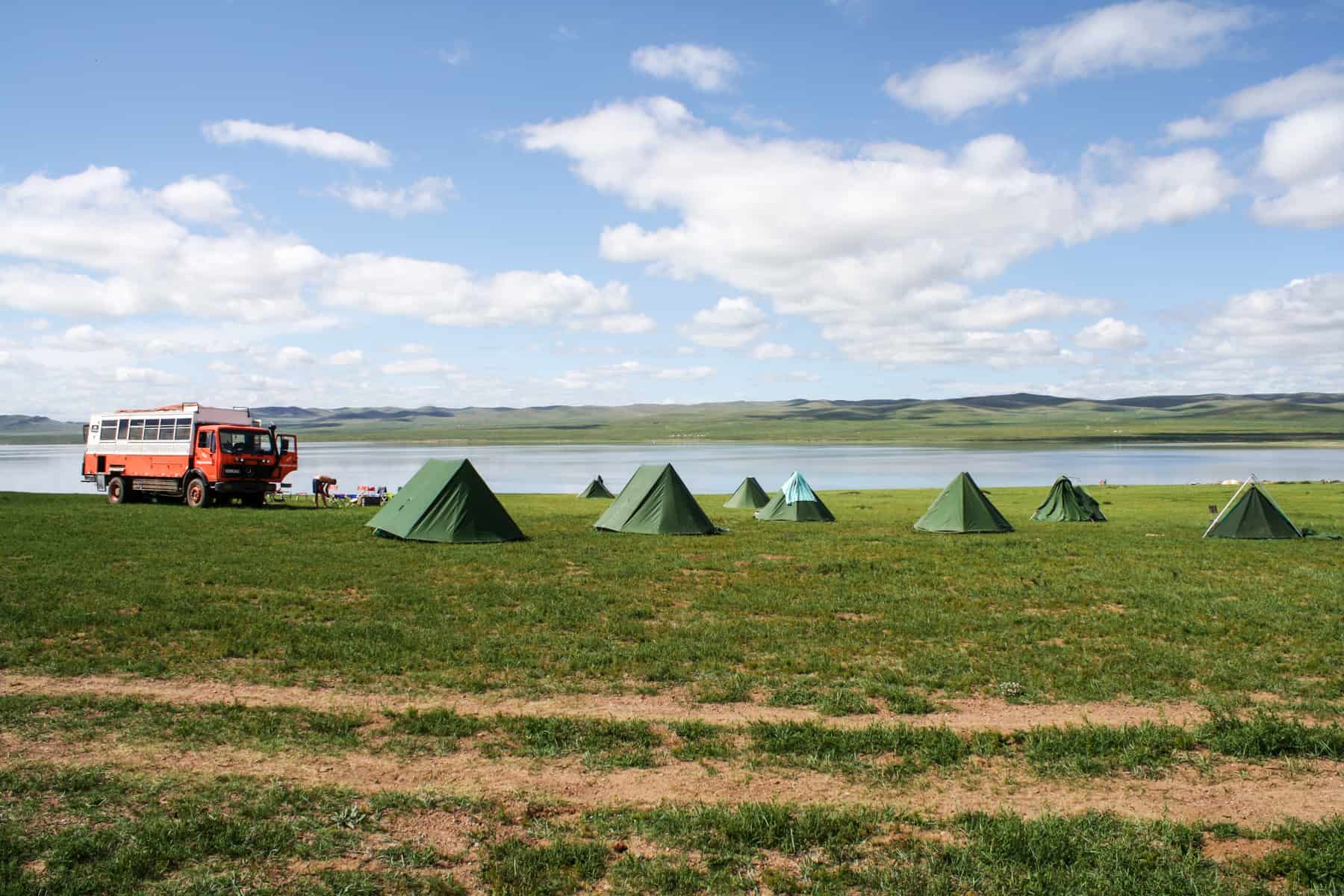
Adventure Travel , Mongolia
This is How to Travel to Mongolia – Overlanding the Least Densely Populated Country in the World
Disclaimer: This post contains affiliate links to handpicked partners, including tours, gear and booking sites. If you click through or buy something via one of them, I may receive a small commission. This is at no extra cost to you and allows this site to keep running.
Want to get to somewhere lesser-known and travel differently? This Mongolia travel guide shows how to go overlanding in the world’s least densely populated country.
Travel to Mongolia means tackling a land of extremes. Both in the landscape, from its vast desert lands and towering dunes to its lush green mountainous national parks, and in its lack of infrastructure, where you become just as frustrated as you are in awe by the country’s areas of extreme isolation.
Visiting Mongolia is to find a canvas of rugged beauty capped by a sky so blue that pollution isn’t even a word that exists here. Passing only wild horses, herds of cattle, an isolated ger in the distance, and the odd truck also on its way to the city, life here is at its purest and most beautiful.
Outside of its unkempt capital, Ulaanbaatar, Mongolia exists with limited facilities, but that’s what makes it attractive. On the road, it can take hours of driving before you pass a small ger community, a Mongolian on horseback or another vehicle, and in between blessed with the most stunning views of a country so desolate that you know you’ve reached the real heart of it.
Overlanding through Mongolia, rather than flying or taking the train, is one of the best decisions I have ever made. This guide will show you how to travel Mongolia from China by land, in a vast loop that takes in some of the country’s most treasured hotspots and wilderness hideaways.
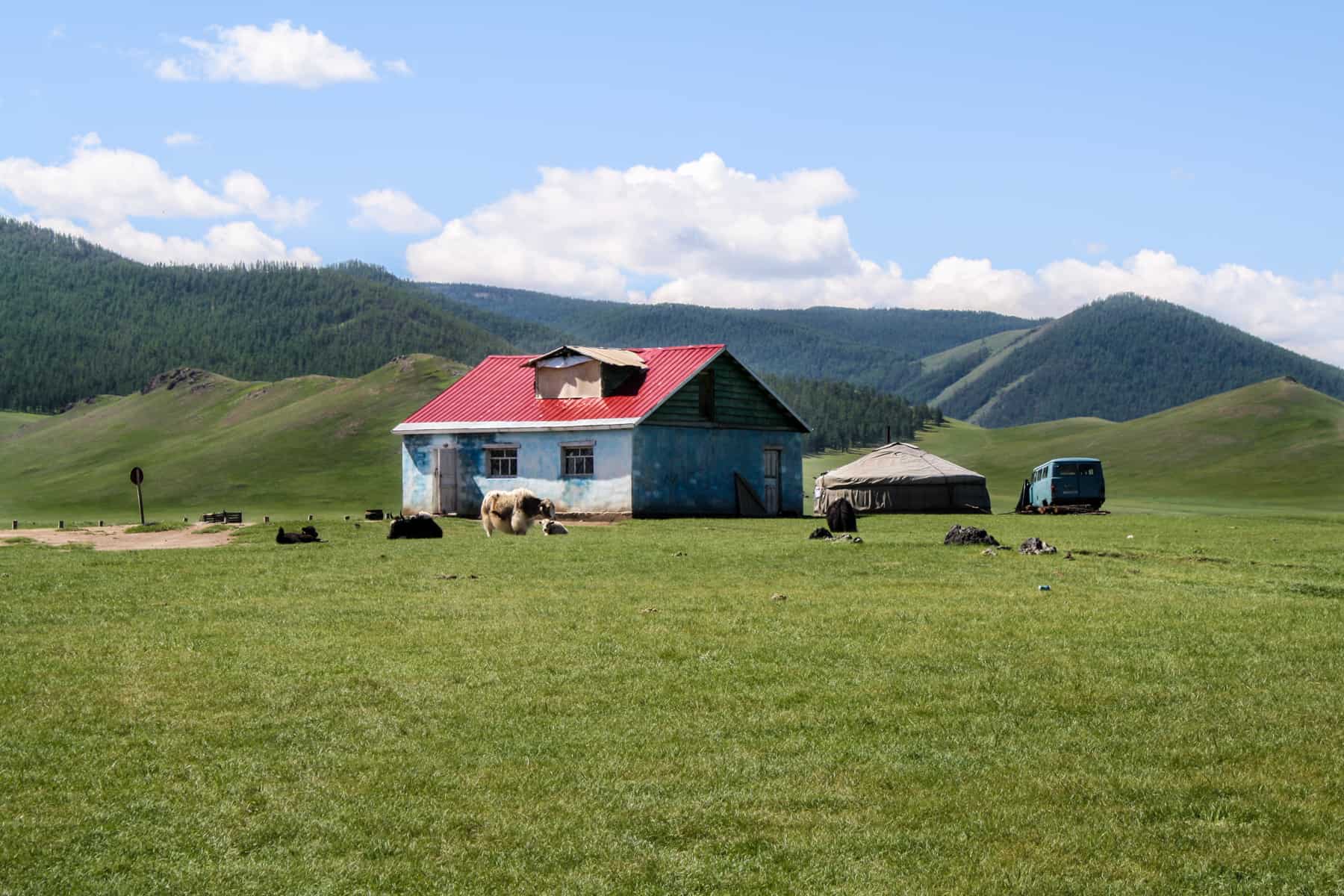
Visit the Least Densely Populated Country in the World
Off the beaten track adventure, when is the best time to go to mongolia, it pays to know a local, classic nomadic mongolia, local living mongolia, discover mongolia – national geographic journeys, experience the naadam festival in mongolia, is mongolia expensive to travel, mongolia visa on arrival, visa-free access to mongolia, day 1: visiting ulaanbaatar, day 2: getting from ulaanbaatar to the gobi desert, day 3: visit the baga gazryn chuluu rock formations, day 4: sleep at a ger camp in the gobi desert, day 5: dalanzagad to gobi discovery ger camp, day 6: hiking in yolin am – mongolia’s ice valley, day 7: a trip to the gobi desert khongoryn els sand dunes, day 8: visiting the bayanzag flaming cliffs, day 9: seeing ongii monastery and driving to arvaikhee, day 10: stuck in mongolia, day 11: hiking in orkhon valley, day 12: seeing the orkhon valley waterfalls, day 13: visiting a mongolian family in a ger, day 14: erdene zuu monastery in kharkhorin, day 15: camping at ugii lake, day 16: visiting hustain national park and seeing przewalski’s horses, day 17: driving to ulaanbaatar and visiting terelj national park, day 18: hiking terelj national park and seeing turtle rock, day 19: a trip to the ghengis khan statue on the tuul river, day 20: back to ulaanbaatar, how to overland in mongolia, building a road in mongolia, getting stuck in the mud, the unexpected river crossing, what to pack for mongolia, planning mongolia travel pin it, why travel to mongolia .
Mongolia travel changes you and makes you appreciate the beautiful patches on the earth’s surface not ruined by extreme modernisation, pollution and overpopulation.
My time in Mongolia meant experiencing everything from bush camping to ger camps, being at one with nature (and not care who sees you squatting in the process) and realising that animals like to roam and Mongolians love to chat – right outside your Ger from 5 am.
I saw a night sky so clear that I didn’t think you could ever see so many stars. I traversed a land so serene in isolation and culture so welcoming that I hope it never, ever becomes ruined by tourist traps or the tight grips of mass capitalism (currently contained to Ulaanbaatar).
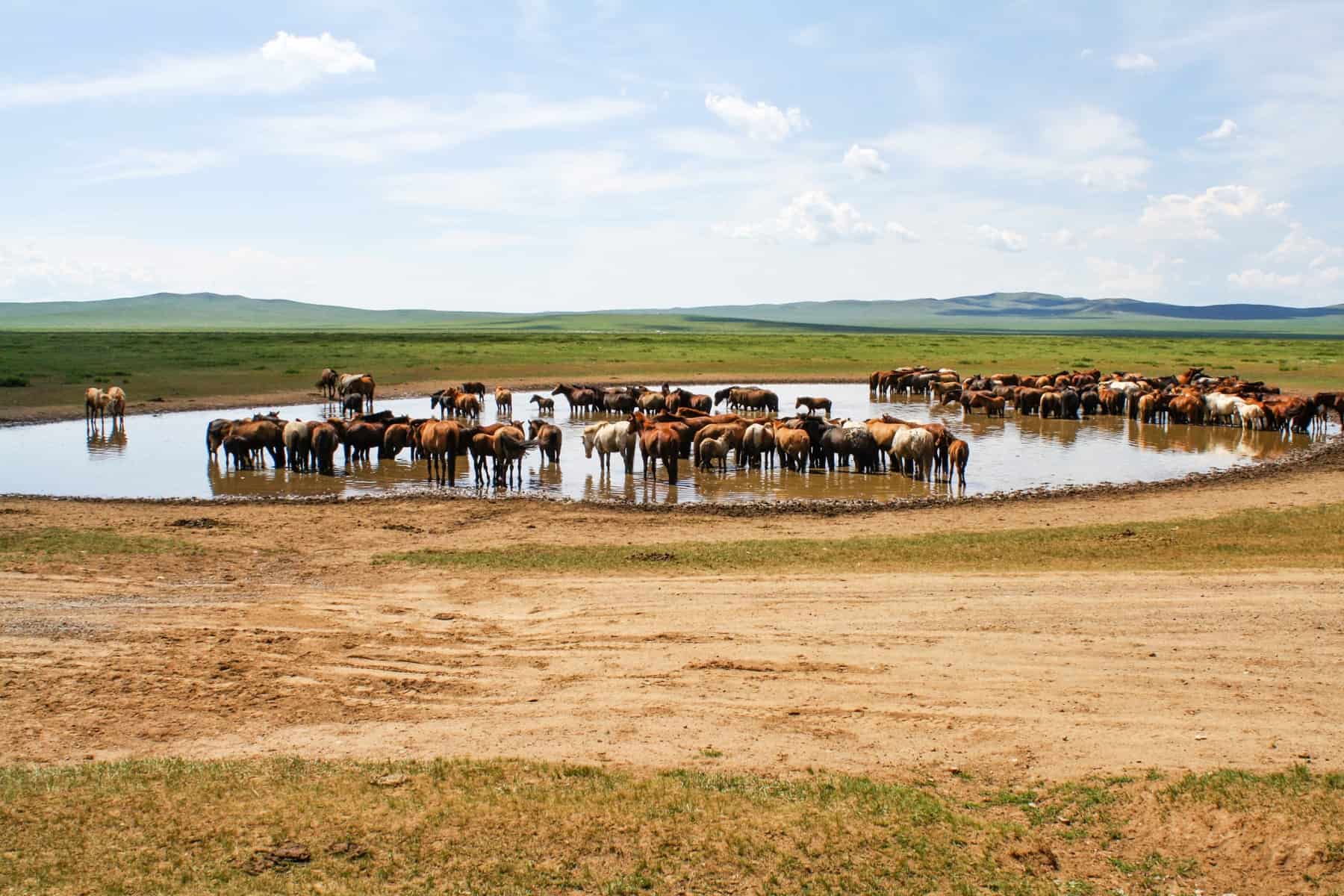
Wild horses in the vast Mongolian landscape
If you want to get off the beaten track, not be on any set grid and take each day as it comes, you will love Mongolia. But this also comes with its frustrations where you need droves of patience and a good chunk of travel time to spare.
There are hardly any roads. Roads are dirt tracks or pre-made grooves in the land pointing the way, and paved highroads are very few and far between.
Mongolia is prone to unpredictable weather conditions. That means random onslaughts of rain and the likelihood that you are likely to get bogged at some point. There were countless numbers of times where we had to dig out and push the truck or find locals to come to the rescue – tractors are a saving grace here.
It’s a vast country that you could get lost in for weeks on end, and when you accept the setbacks, you start to see them as part of the big adventure – travel at its most raw. Back to basics, getting dirty and struggling with the lack of modern amenities we too often take for granted is part of what travelling in Mongolia is all about.
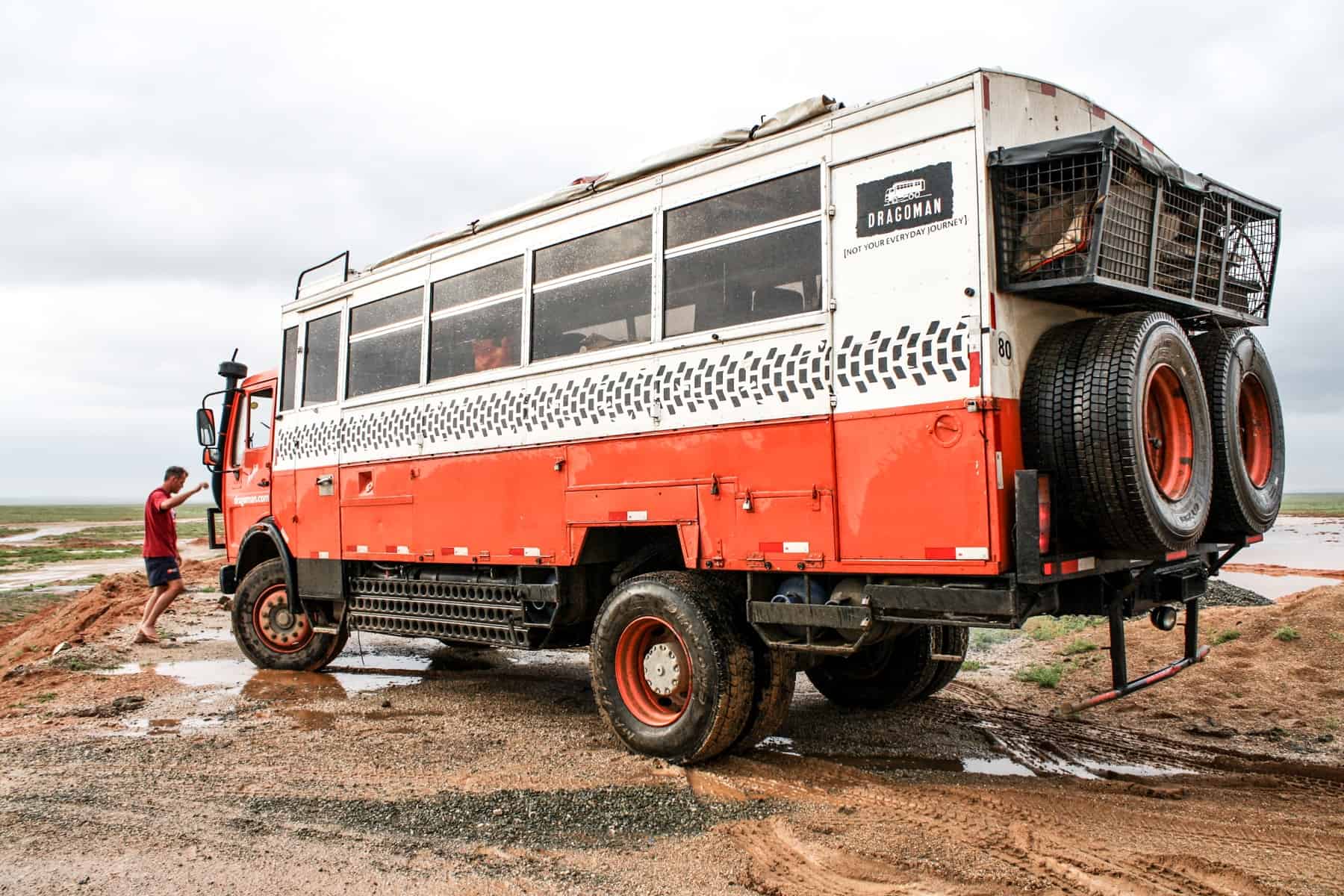
The Overlanding vehicle used to travel to Mongolia and around.
The summer season between May to September is said to be the best time to go to Mongolia. July and August are the hottest months, with temperatures in the Gobi Desert reaching 40°C. Rainfall is at its highest between June and September, balancing out the heat while keeping the forest and valley lands, in particular, lush and fertile. I travelled to Mongolia in July and experienced a lot of rainfall alongside high temperatures.
Mongolia’s winter season is from November to February. While some people like to experience the landscape in this snowy season, temperatures can drop to below minus 20°C – a harsh and challenging environment to travel in. You’ll find that not many companies run tours during this time.
Is it Safe to Travel to Mongolia Safe?
While petty crime and pickpocketing are common in the capital, Ulaanbataar, Mongolia is a relatively safe place to travel, and I never encountered any significant problems. It pays to be more streetwise and alert in the city, as you would in any other. As the landing and departure point for tourists, opportunism poses a higher risk.
Despite the lack of infrastructure and the relative isolation when travelling through the country, the only minor issue we encountered was related to the high levels of alcoholism in the country. We saw drunk drivers on our long drives and an occasion or two when inebriated locals came to our makeshift camp out of curiosity. Even then, it never felt threatening, and we were always within the safety of our group.
On the whole, we rarely saw other people, and when we did, we were met with kindness, invited into homes and welcomed into common spaces such as markets and small-town social spaces.
I also travelled alongside a Mongolian guide – someone who could speak the language when we got stuck, who could walk to a nearby home and explain the need for assistance and who understood the land’s general navigation. Therefore, in Mongolia, it pays to get yourself a local guide, join a small group tour, formulate a small group of your own in Ulaanbataar or be equipped with general wilderness survival skills if going out there entirely on your own.
Mongolia Tours
When I was planning my trip to Mongolia, Dragoman was the only company offering Mongolia tours that lasted from ten days to two weeks. The 21-day overland journey was the first trip itinerary of its kind they were running here, which included Inner Mongolia. Today the 21-day trip, called Nomads & Wilds of Mongolia, is on a loop from Ulaanbaatar and includes Khovsgol Lake in the north. Although Dragoman suspended operations during the pandemic, they are back in 2024.
Adventure travel experts G Adventures, offer Mongolia tours that all start and end in Ulaanbaatar.
A 14-day trip, including all the highlights at an affordable price (from €1999), this Mongolia trip includes a Gobi Desert and Mongolian Grasslands stay, alongside packing in the major historical must-sees and cultural experiences that make Mongolia an unforgettable adventure.
This 10-day local living trip includes staying with three different families in Gers to experience life as a nomad. Mix historical monuments with cultural moments, exploring pastures, forests, lakes and national parks by foot and horseback while helping your host families prepare traditional dinners and learn the skills of their nomadic trades.
G Adventures, in partnership with National Geographic Journeys, offers a two-week comfort adventure through Mongolia . You get to visit Khustai National Park, Karakorum (the ancient capital of Mongolia), Tsenkher Hot Springs, the Orkhon Valley and more. You will also see a nomadic camel-herding family and dive deeper into Mongolia’s culture, as well as support the local community where tourists pass through.
Want to experience the Naadam Festival’s horseracing, archery and wrestling tournaments? This mini adventure takes you to it and throws you right into the buzz of traditional Mongolian festivities.
Mongolia is expensive to travel in and around due to the very nature that it is not overly touristic. Due to the lack of infrastructure, a tour with a local guide and appropriate transport can often be necessary to cover more ground.
- You will need to budget between $2400-$3600 for an extensive trip around the country.
- An average meal (if not making your own on the trip) costs around $5.
- Entrance fees to historic sites and museums average around $2 per ticket.
For those on a budget, day trips can be taken from Ulaanbaatar, or you can try and plan some shorter 3-5 day trips from the city. However, this can often depend on having a minimum amount of people signed up for the trip to run and isn’t always guaranteed.
Do you need a Visa for Mongolia?
If you are not a national of one of the visa-exempt countries listed below, you will need a Mongolia visa.
- A single-entry visa (valid for three months from the date of issue) for up to 30 days – £40/$50
- A double-entry visa (valid for three months from the date of issue) for up to 30 days – £55/$65
It is cheaper to apply directly at a Mongolian Embassy (either at home before you leave or in the country you are travelling in prior). You will need a valid passport, passport photos and supporting trip documents alongside a completed application.
Allow one working week for processing. Some Embassies provide a one-day service for an extra charge.
A 30-day tourist visa on arrival is available for tourists coming from European and other countries where there are no Mongolian Embassies present, obtained at Ulanbataar Airport or the Mongolian land borders. I got my visa in London months before my trip.
The following countries are granted visa-free entry to Mongolia.
Visa-free entry for 90 days: Argentina, Belarus, Brazil, Chile, Kazakhstan, Kyrgyzstan, Serbia, United States (US). Those from Ukraine require a form of invitation.
Visa-free entry for 30 days: Canada, Cuba, Germany, Israel, Japan, Laos, Malaysia, Russia, Singapore, Turkey, Thailand, Uruguay.
Visa-free entry for 21 days: Philippines.
Visa-free entry for 14 days: Hong Kong.
You can find further information on the Embassy of Mongolia website .
Where to Go in Mongolia – Itinerary
I spent 20 days Overlanding in and across the central and western Mongolian plains. We travelled in a big clockwise circle from Ulaanbaatar, through the scorching Gobi Desert to beautiful lakes, forests, canyons and waterfalls, all the while passing vast herds of wild horses, camels, goats, yaks and cows.
Overlanding in Mongolia for Three Weeks:
Kilometres travelled: 2492
Number of significant times the truck got stuck: 2
Number of minor times the truck got stuck: 12
Number of incredible driving days: 15
We spent a full day in Ulaanbaatar exploring outside of the stark Soviet communist-style architecture and moving past the city’s general dodgy feeling. There’s plenty to see and do here, including a walk through the modern Sukhbaatar (Parliament) Square, the Gandan Monastery, the National History Museum and the shopping paradise of the Black Market . In the evening, check out the singing, dancing and contortion talent at the Cultural Show before hitting a few bars and pubs. There’s so many you won’t know where to start.
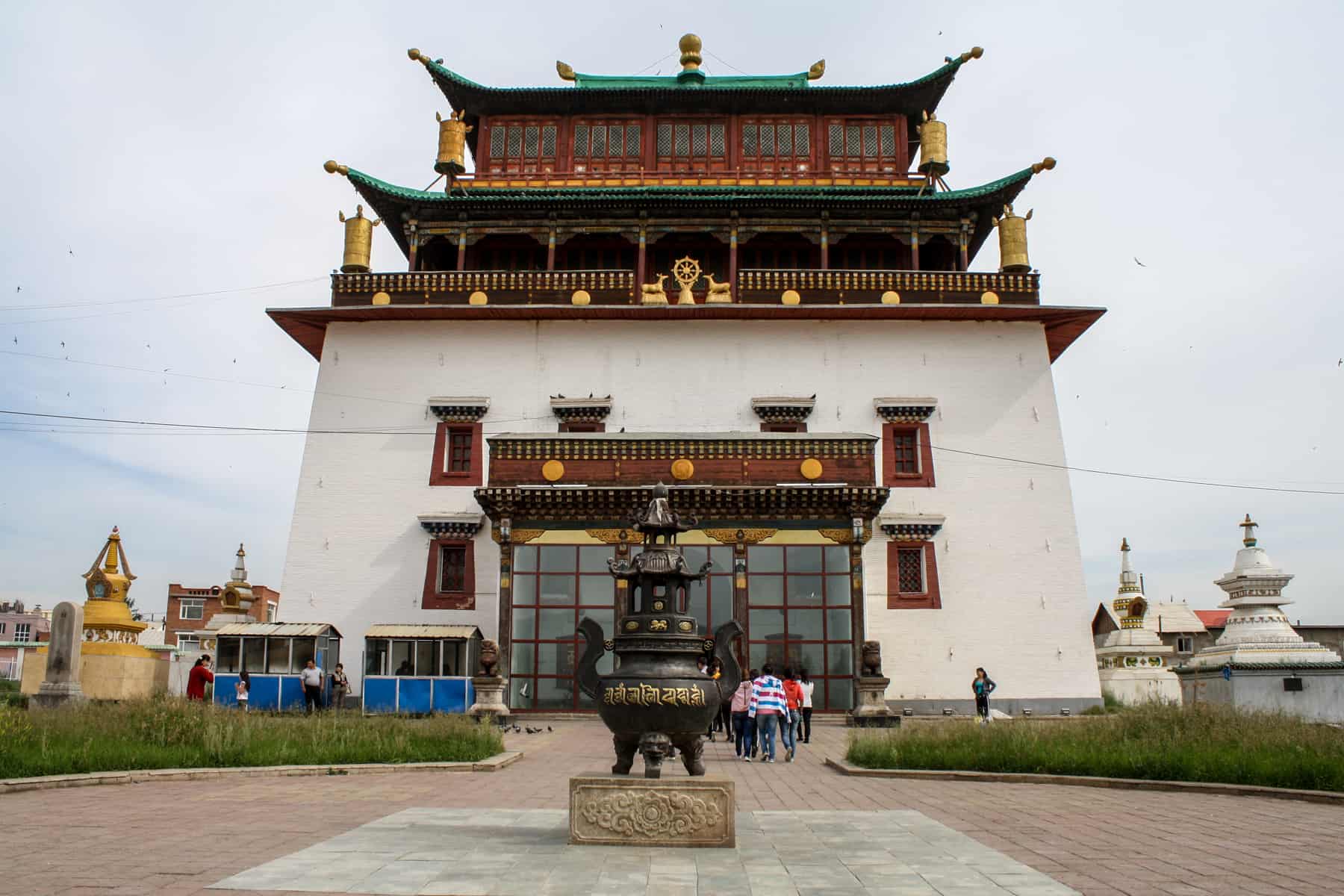
Gandan Monastery in Ulaanbaatar, Mongolia
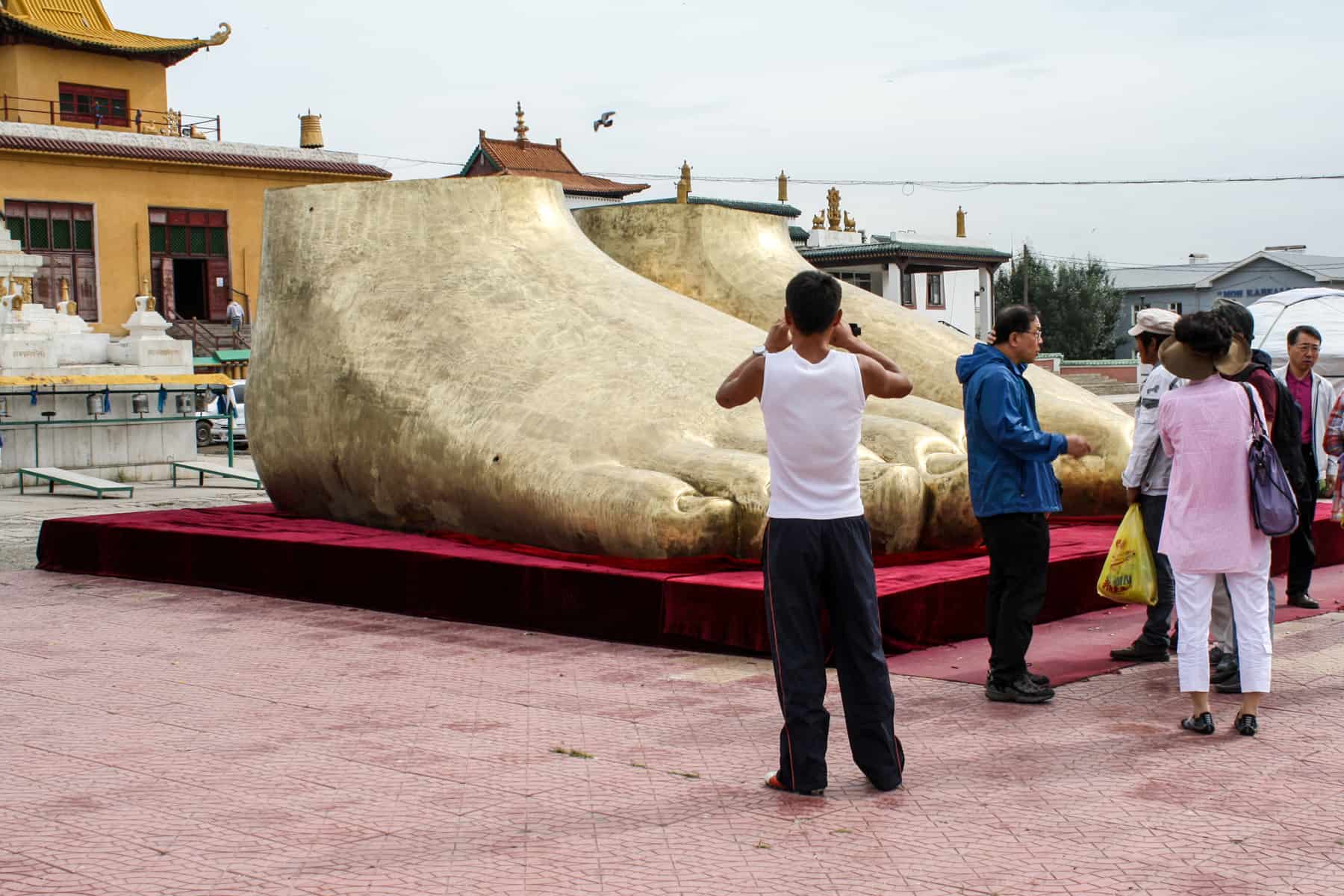
The golden feet outside the Gandan Monastery Ulaanbaatar
We set off in the truck from Ulaanbaatar to drive to the Baga Gazryn Chuluu rock formations in the Gobi desert. Due to heavy traffic when getting out of the city and general road conditions we got delayed and so decided to set up bush camp for the evening. Be prepared for delays in Mongolia but delight in being the only people in the area. All the space is yours.
We got to Baga Gazryn Chuluu – rock formations worshipped by locals who make pilgrimages here partly because legend states that Ghengis Khan camped here – before journeying to the Gobi Desert.
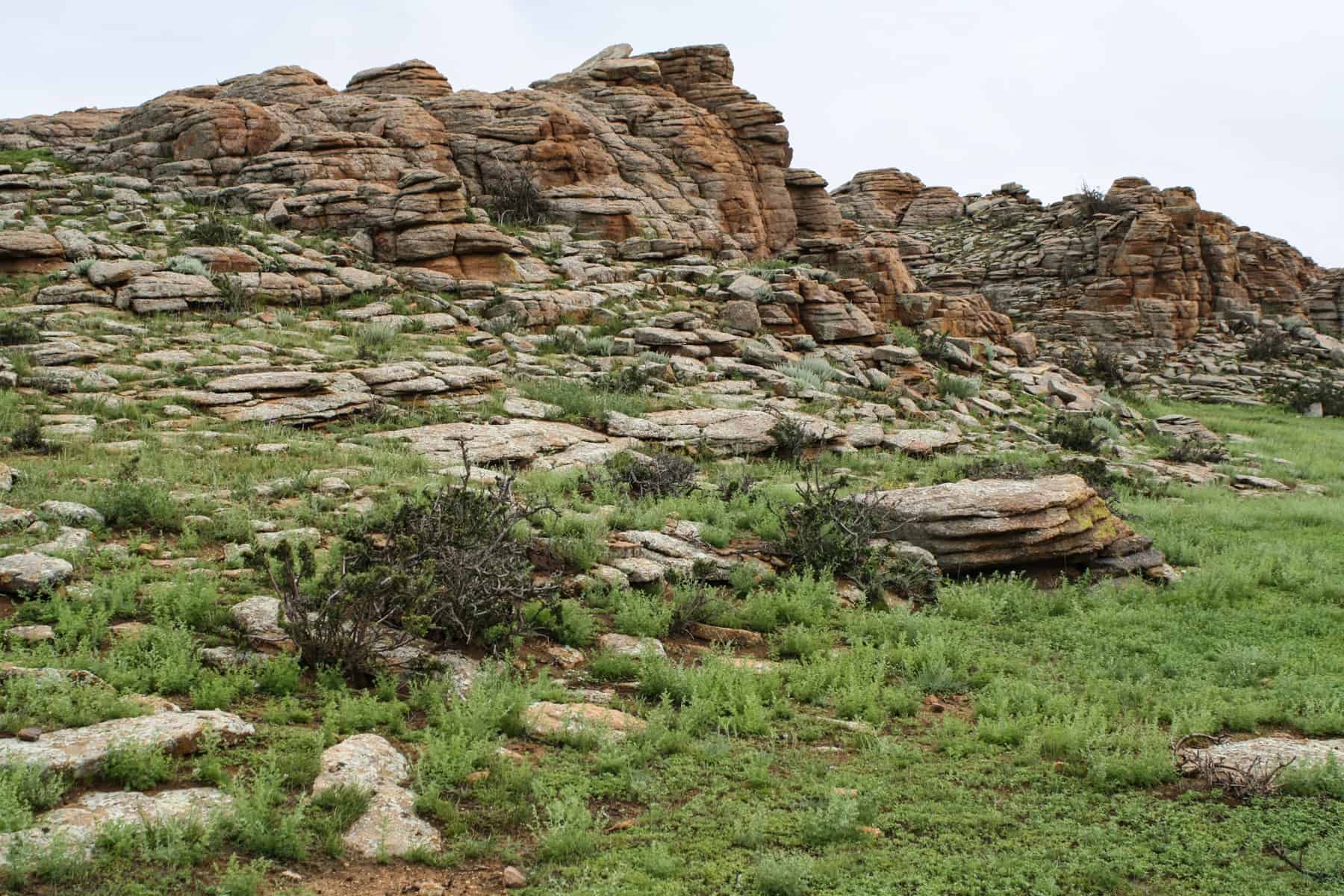
Layers of Baga Gazryn Chuluu rock formations in Mongolia
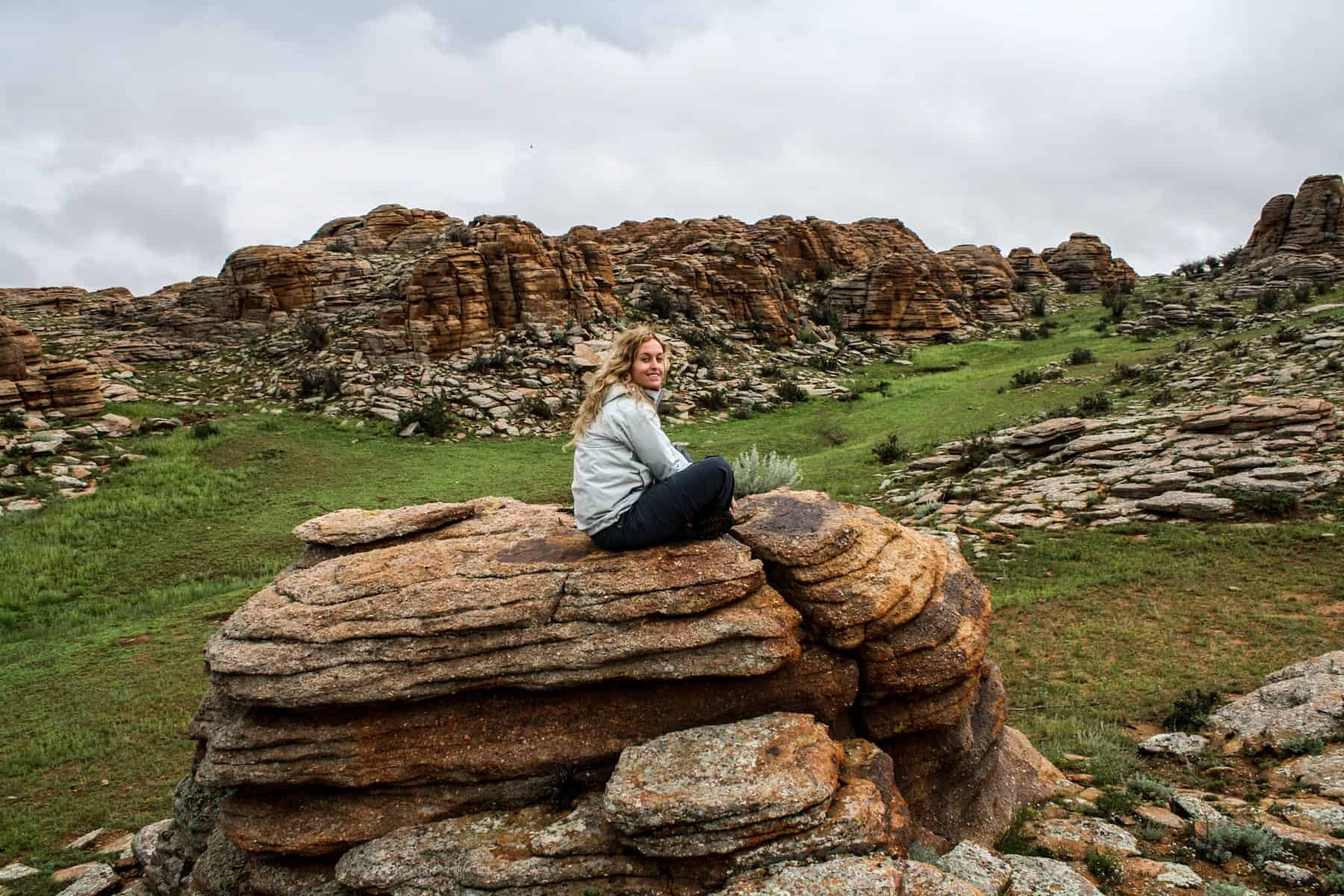
A hike to Baga Gazryn Chuluu as part of a Mongolia travel itinerary
On the way, we got to experience the famous Nadaam Festival when we passed through the local town of Mandal Govi . It was full of wrestling, horse racing, archery and fairground style fun. Nadaam means ‘games’, and the buzz was all around us as the only Westerners there. It was great to be a part of a traditional Mongolian community celebration, even if the afternoon was marred by a bogging, which resulted in the truck not being released from the soft mud until midnight.
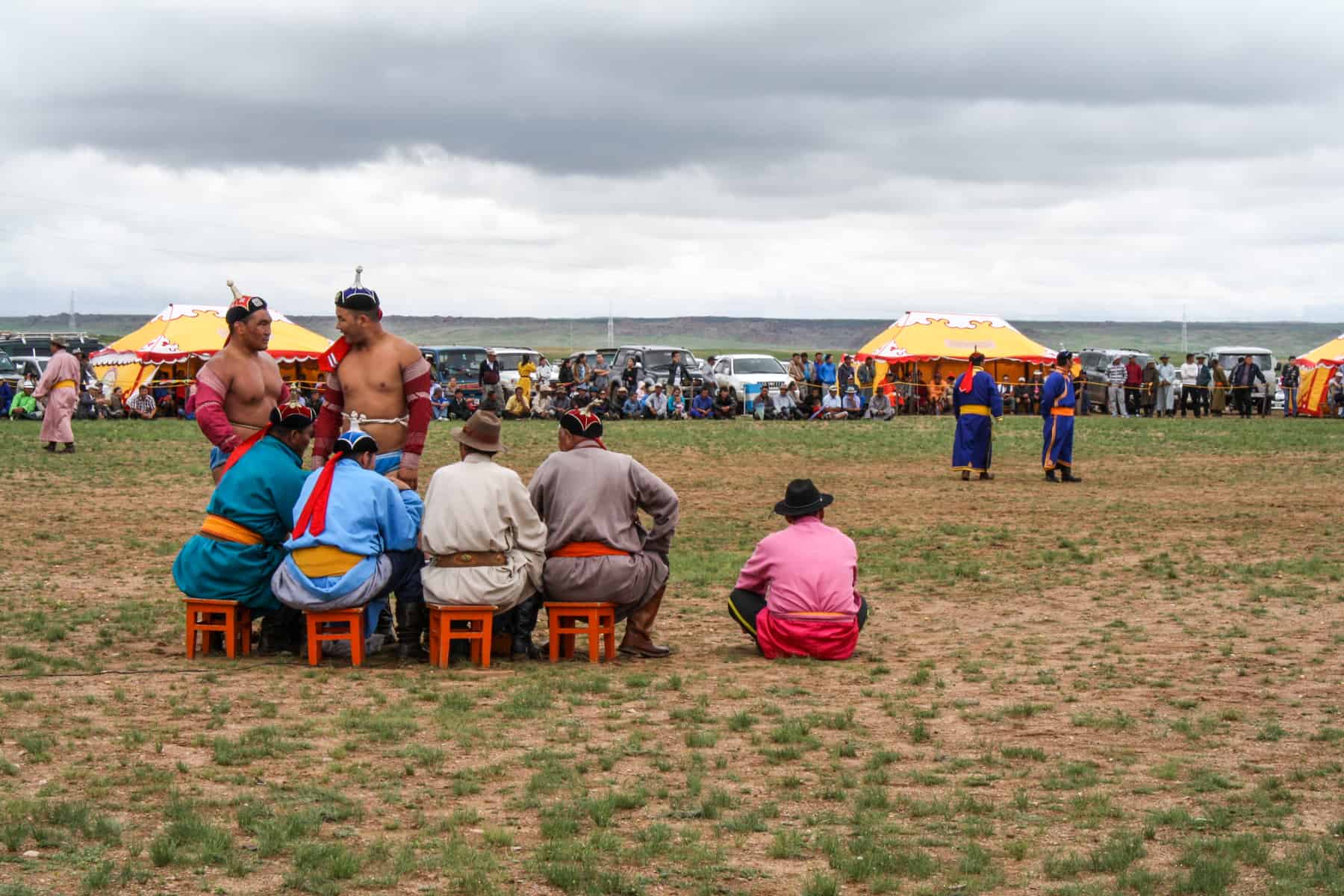
Watching the wrestling at the Nadaam Festival in Mongolia
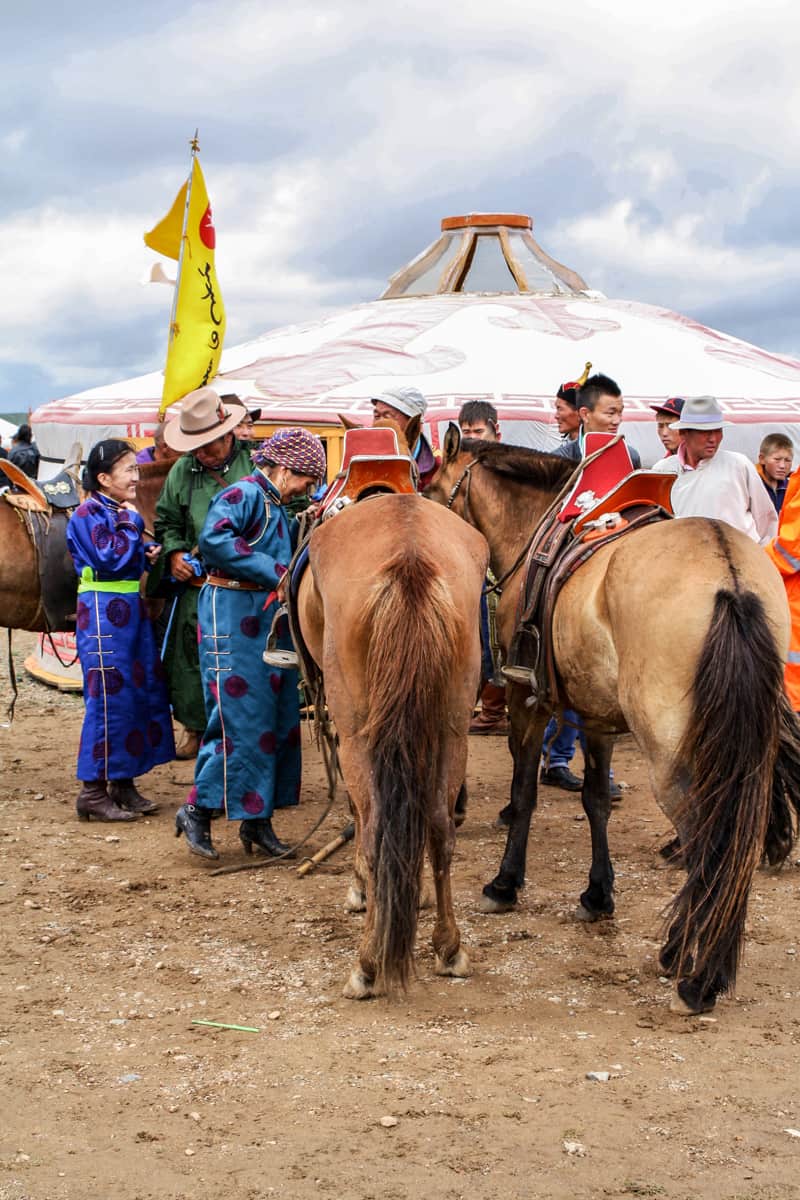
Mongolian locals enjoy the Nadaam Festival.
The plan was to get to our first ger camp, but after approximately 30 kilometres, we encountered a large ditch of water on the road. It resulted in us having to drain the water by hand and build a road and a dam for most of the afternoon to help us get across. Although this sounds horrendous, it created a great sense of camaraderie and, ultimately, an immense sense of achievement. We got to camp on a high point of the Gobi Desert instead near the town of Tsogoovi .
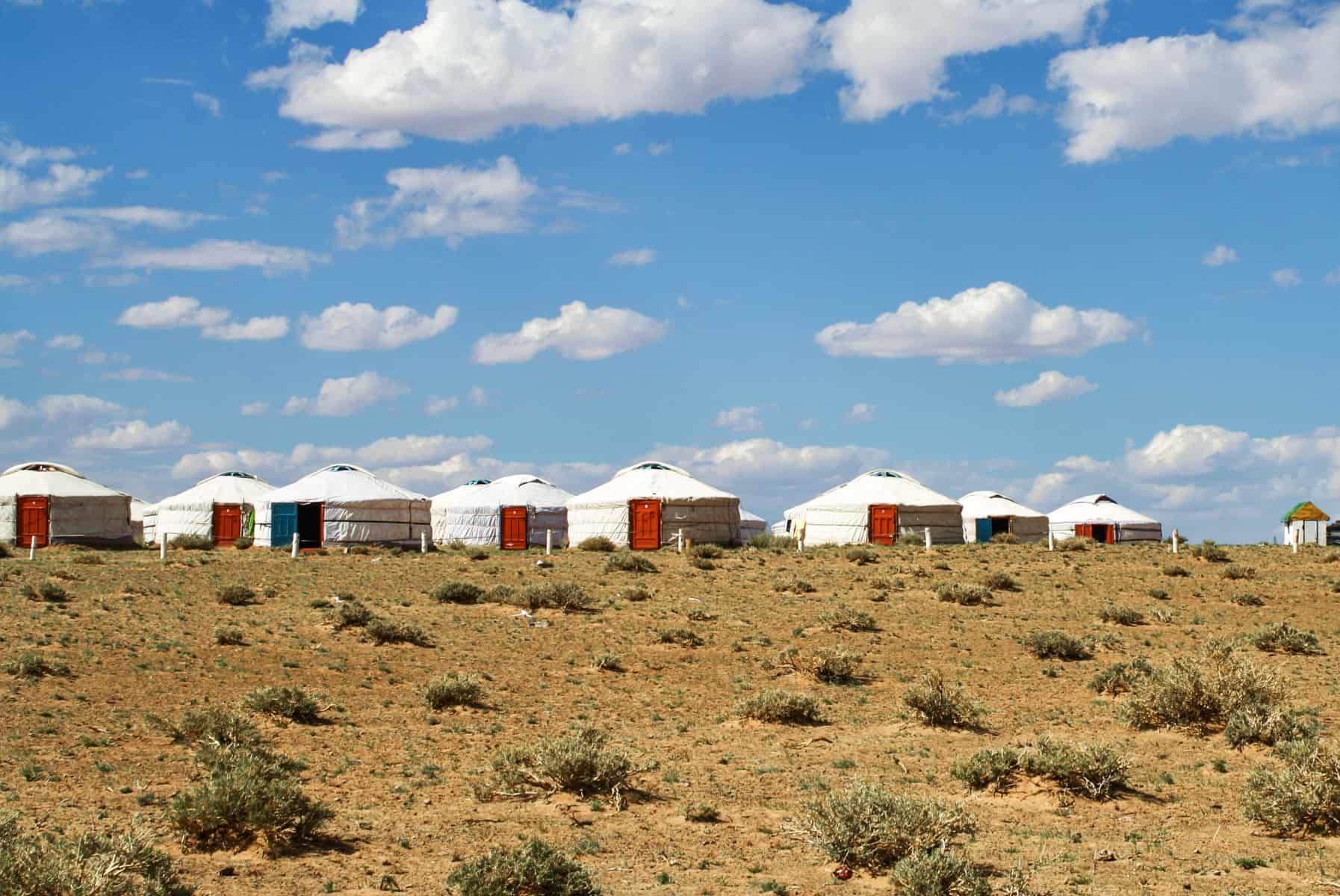
A Ger Camp on a hilltop in the Gobi Desert, Mongolia
We began our journey without a hitch to the ger Camp called Gobi Discovery, stopping at the town of Dalanzagad on the way. Mongolian towns are typically tiny and compact settlements that are reasonably large but without the ruin of a city like Ulaanbaatar.
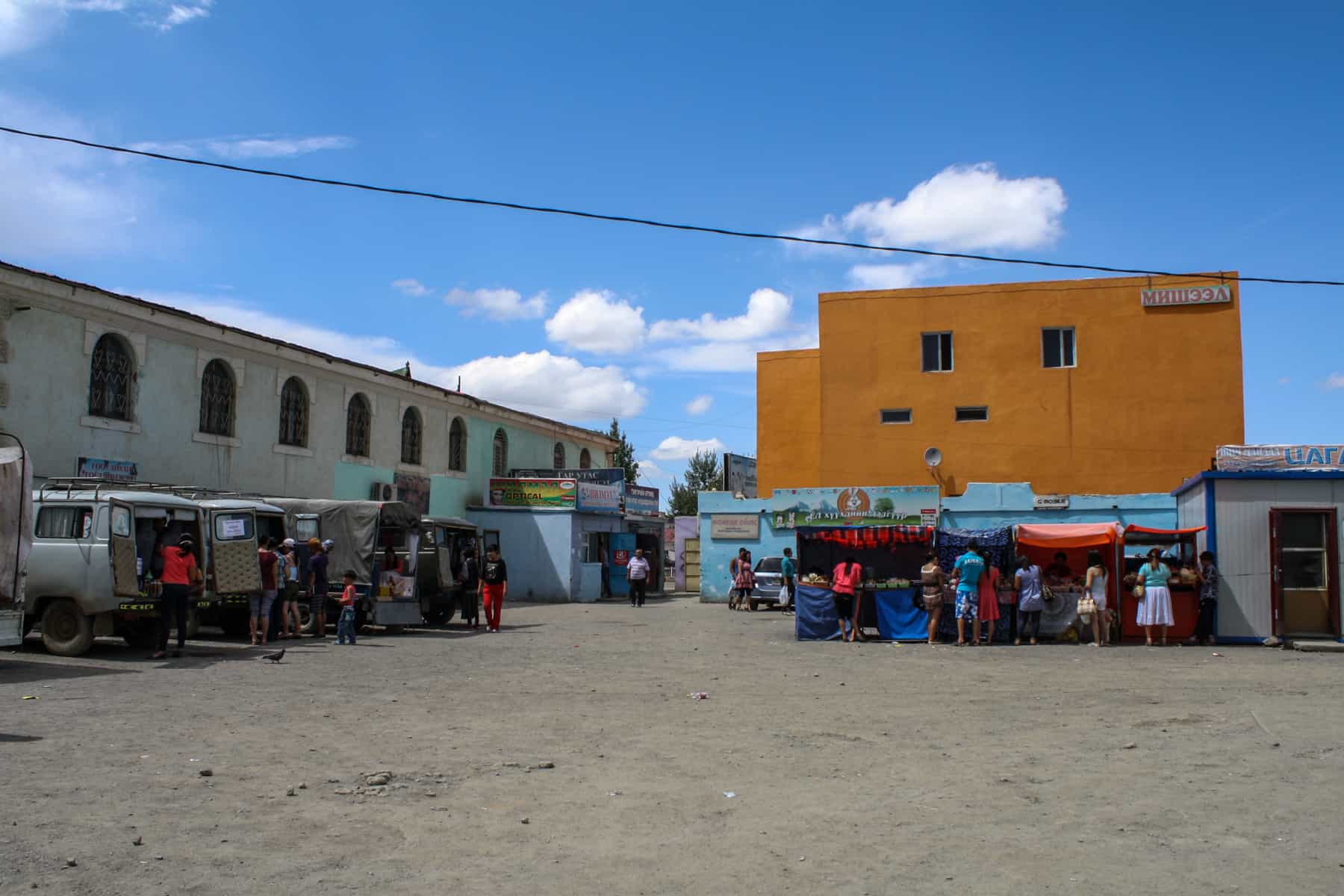
Market time in the town of Dalanzagad, Mongolia
We hiked in Yolin Am , a beautiful canyon in the Gobi, an ice valley, which hosts a colossal glacier all year round. The hike was spectacular, but, unfortunately for us, little of the iceberg remained, although we had lots of fun playing with what little ice there was regardless.
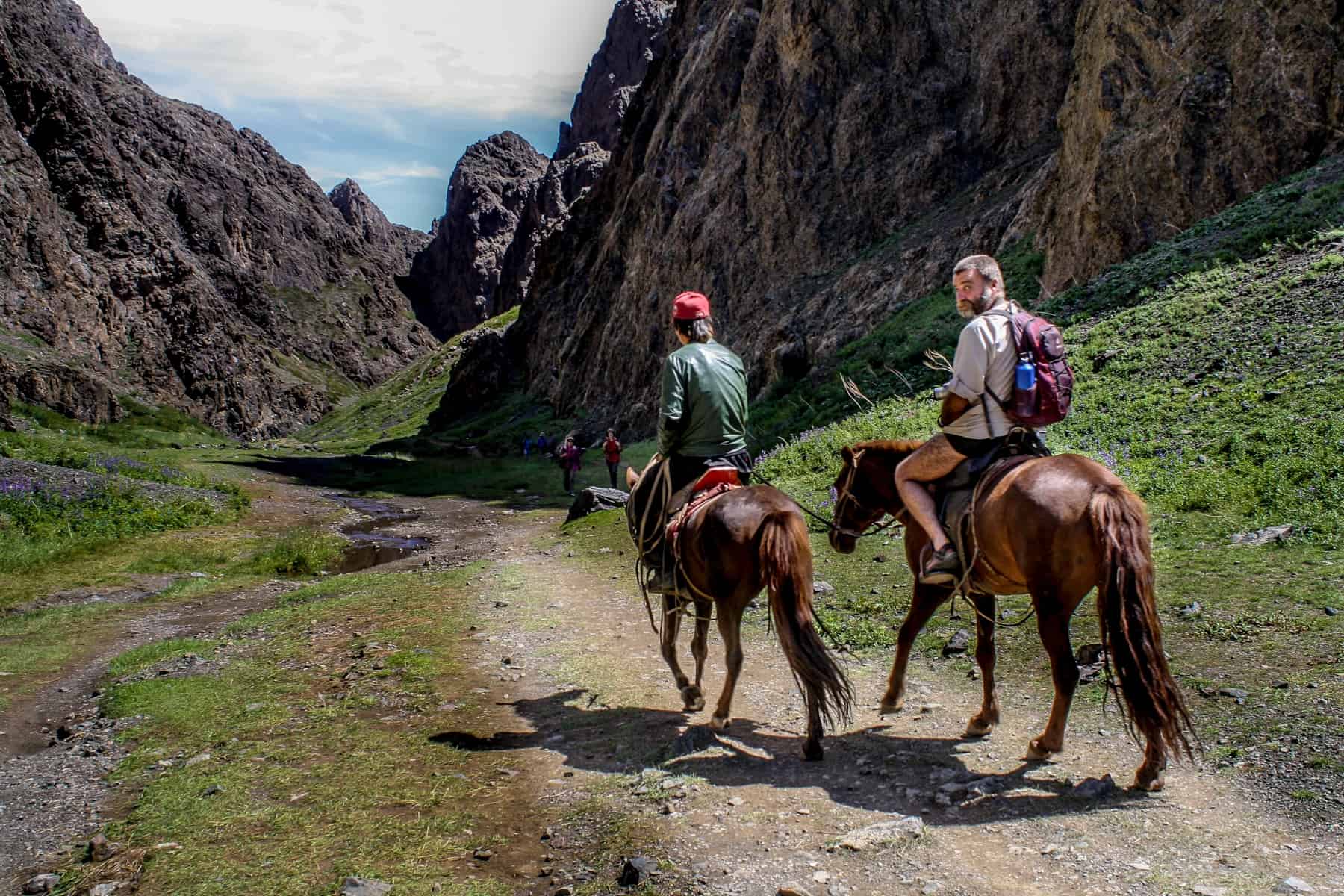
Hike or horseback in the Yolin Am Valley in Mongolia
Many sandy riverbed crossings eventually led us to our second Ger camp, Khongoryn Els Ger Camp. Here, you only have to open your ger door to be greeted with a breathtaking view of the Gobi and the Khongoryn Els Sand Dunes , which I later climbed, drank beer on and ran down. That was after a camel ride, of course.
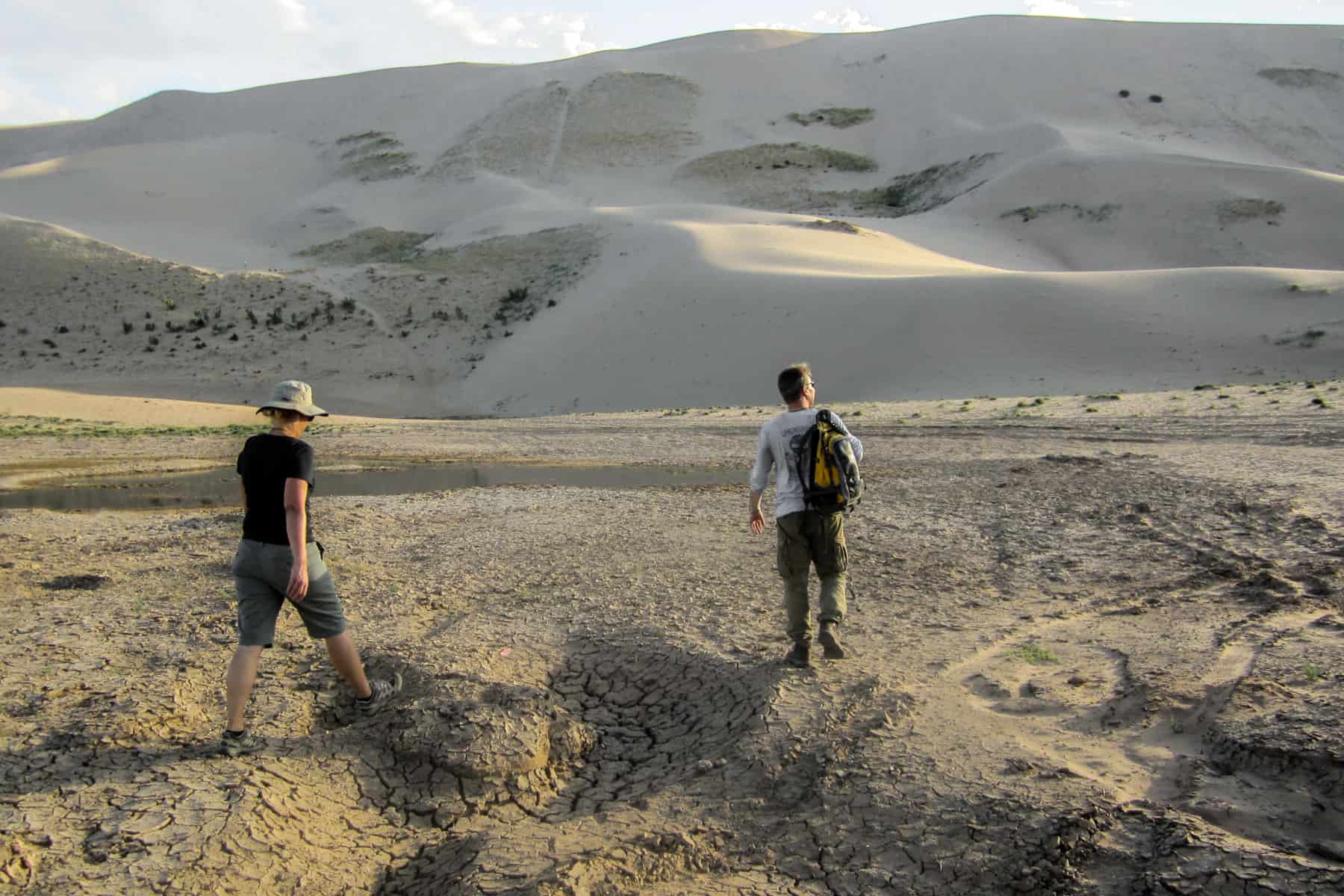
The glorious Gobi Desert Khongoryn Els Sand Dunes
Bumpy mountain roads took us to the spectacular Bayanzag Flaming Cliffs , which are a Mongolian version of the Grand Canyon, but smaller. It’s a significant site that unearthed many dinosaur fossils and eggs, and it is also a stunning backdrop for bush camping.
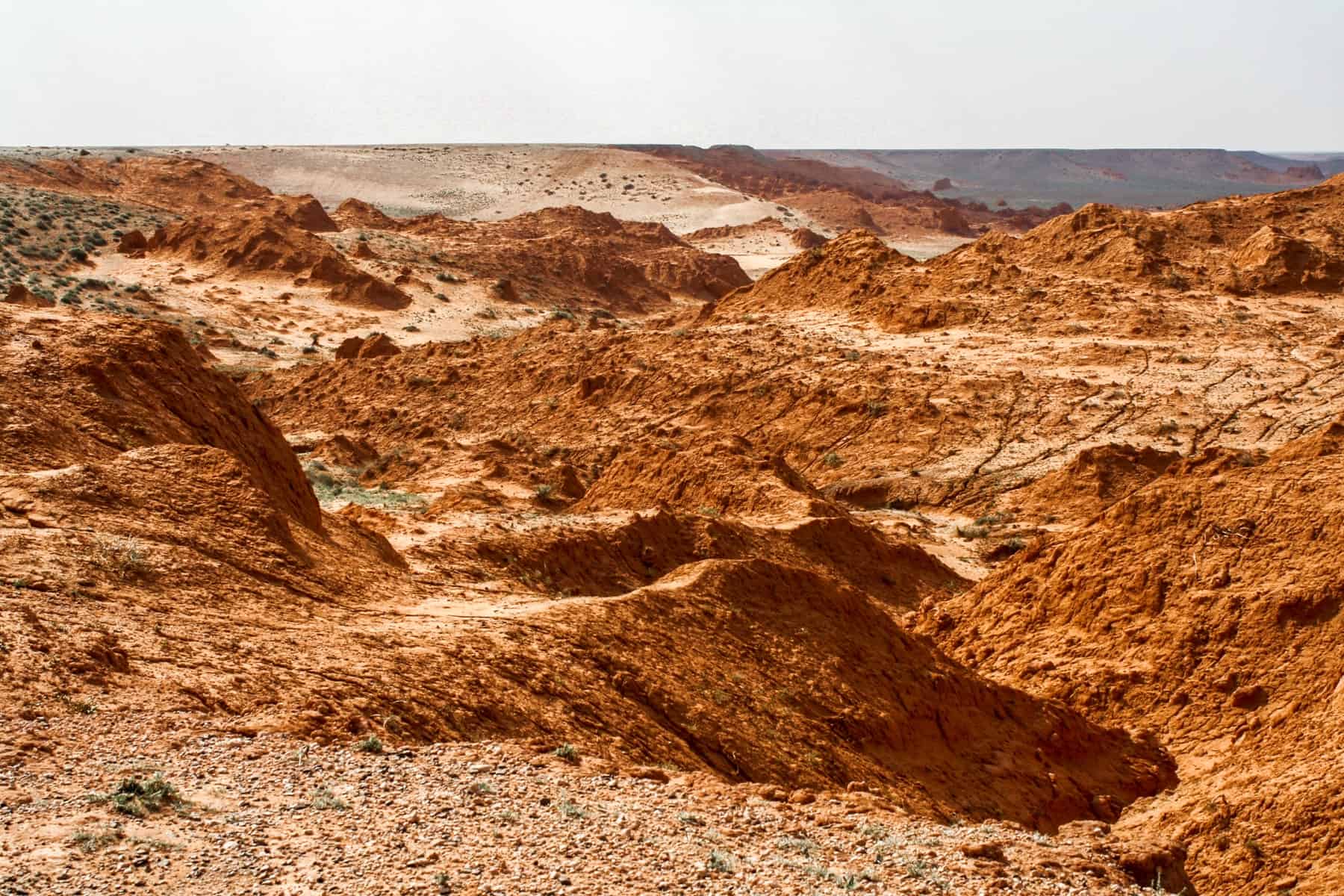
The blazing ochre colours of Mongolia’s Bayanzag Flaming Cliffs
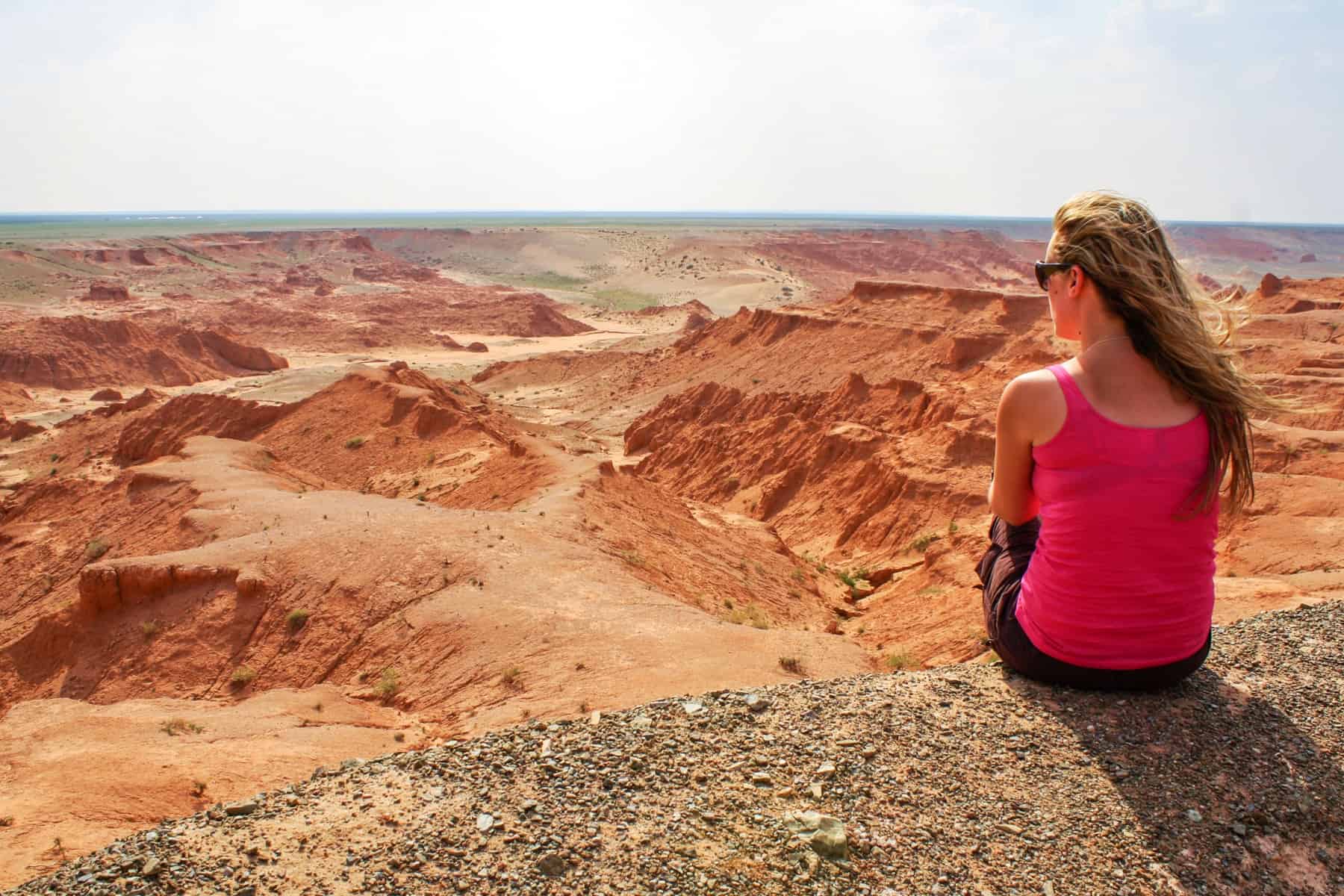
Marvel the mars-like landscape of Bayanzag Flaming Cliffs when you travel to Mongolia
When the communists invaded Mongolia in the 1930s (known as the Purges), nearly all Monasteries were destroyed. Ongii Monastery was one of them, and we visited the ruins here before driving to Arvaikheer, where heavy rain forced us into a hotel for the night. At times, random bad weather makes bush camping in Mongolia impossible, so it is essential to prepare for a budget recount at any given time.
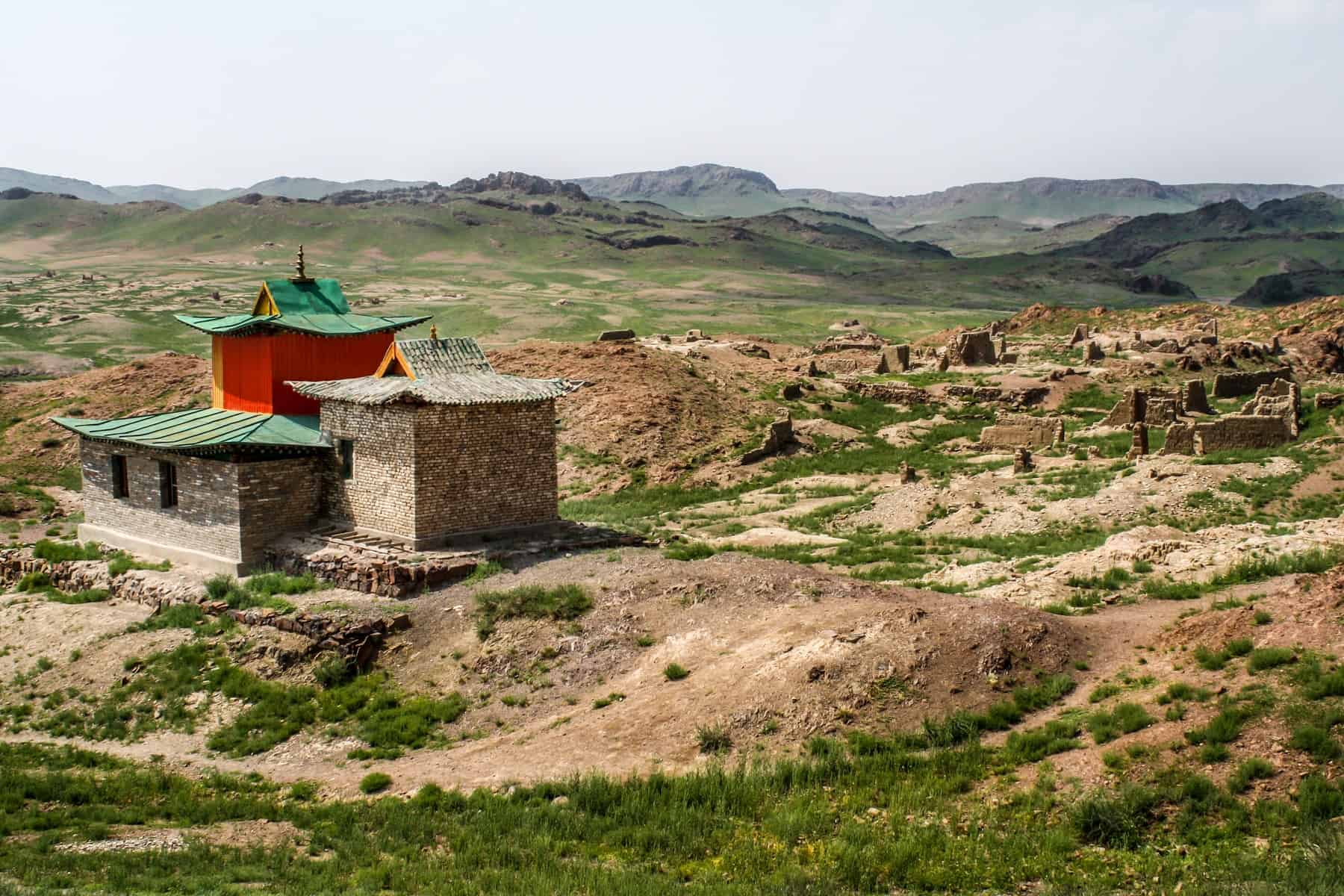
The site of the Ongii Monastery in Mongolia
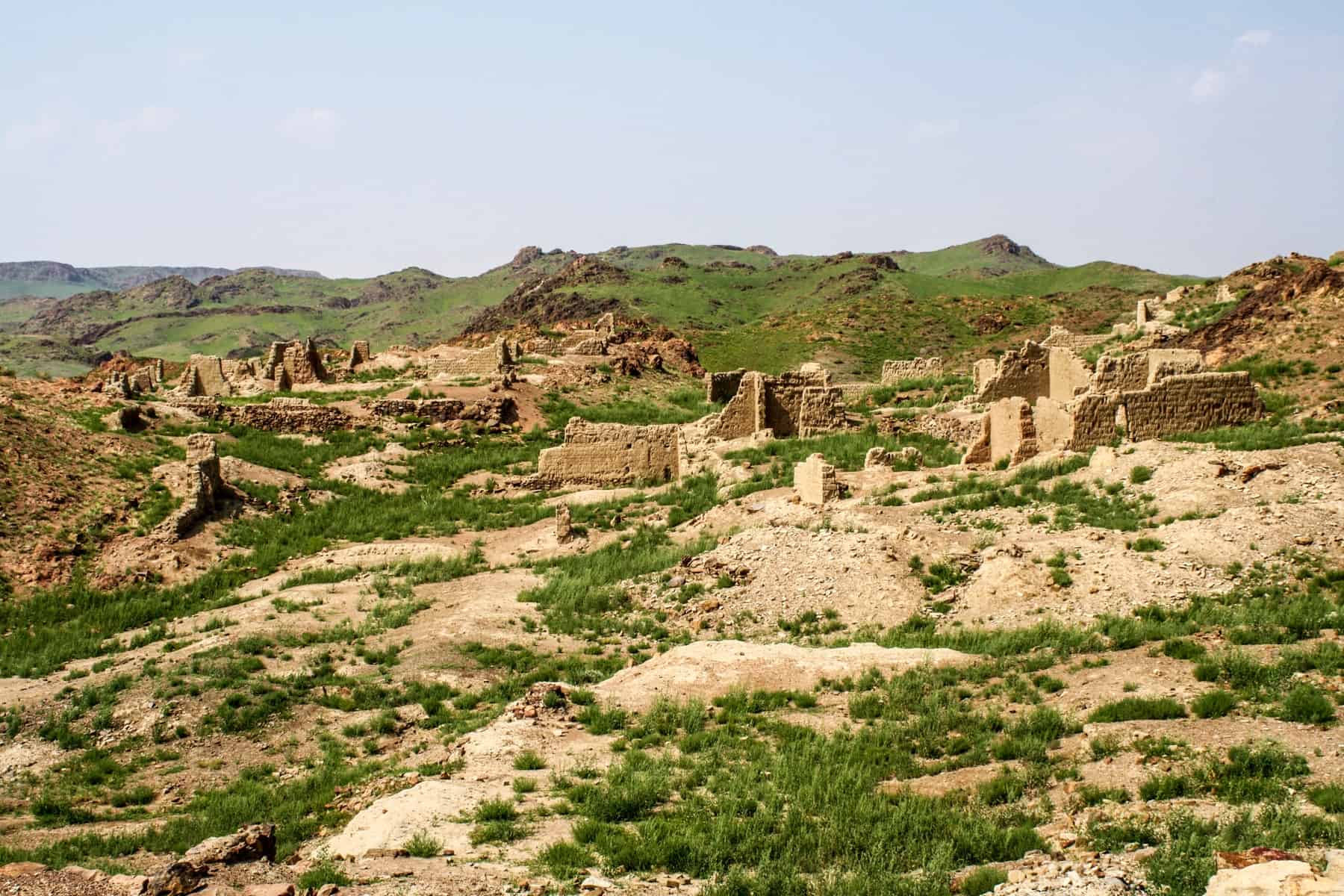
The scattered stone ruins of Ongii Monastery in Mongolia
We began our journey to the third ger camp but got badly bogged around midday after the truck had to swerve slightly, of course, to miss a drunk driver who came in our path (sadly, a lot of people drink and drive here). It took over five hours to get out, with the help of a small local tractor, and during that time, a few of us who remained to help with the truck (local jeeps rescued a few) lost our minds. It was a hilarious few hours that would have made an excellent documentary, probably how a Lord of the Flies scenario starts.
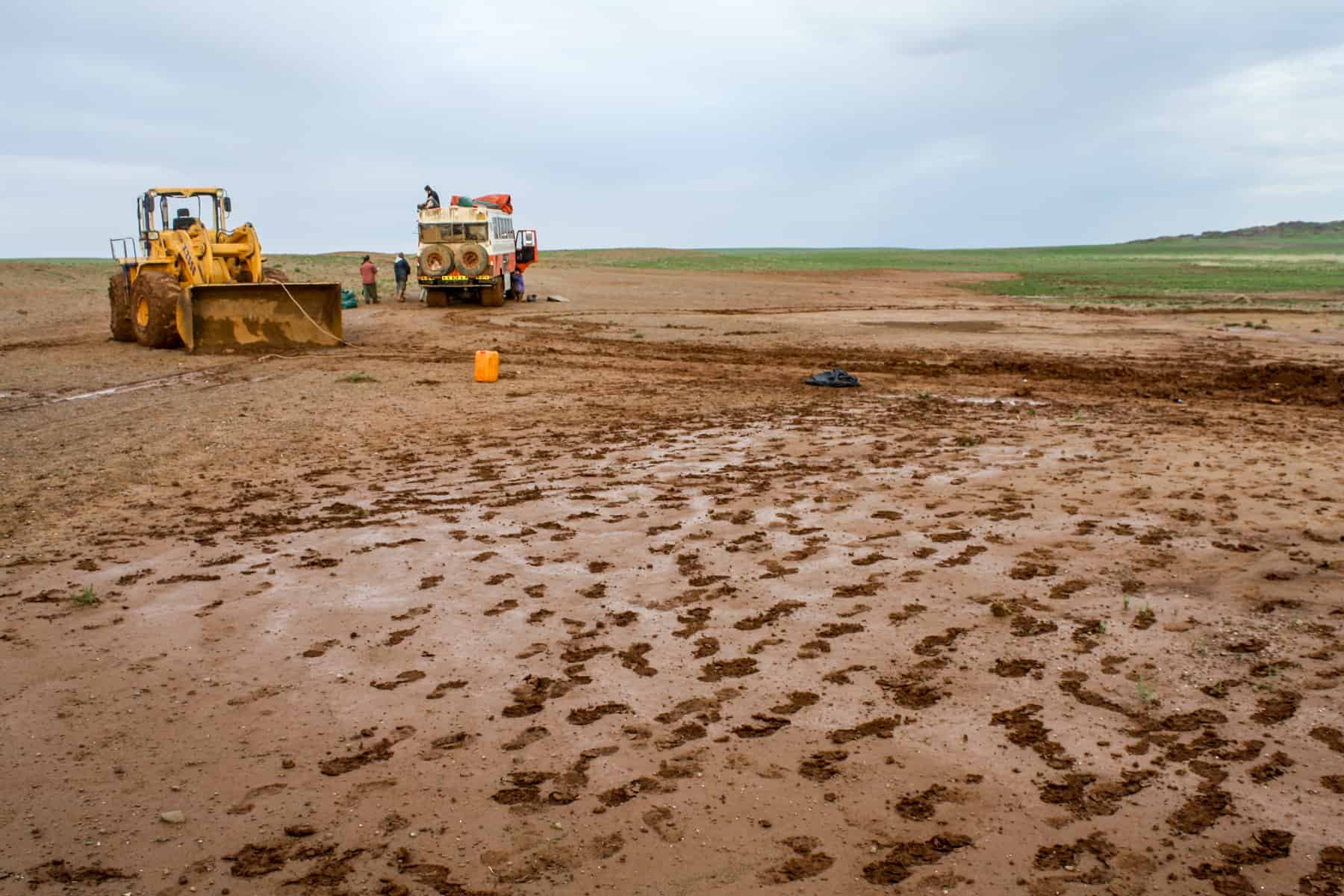
Tractors help pull the Overlanding truck out of the sticky mud in Mongolia’s rural landscape.
The roads were not rigid and stable enough for the truck to continue, especially with all the hills. After setting up tents and cooking dinner, two small vans came to the rescue to take us on our two-hour journey to the Ger Camp. It was a scary ride in the dark, where we stopped at the driver’s backyard and where a small boy jumped into the hold of the van for the rest of the journey.
I highly recommend staying in a ger camp in the beautiful Orkhon Valley . There’s nothing like a pleasant hike through the beautiful forest to reach the Tuvkhon Monastery and see the surrounding area. Pure bliss.
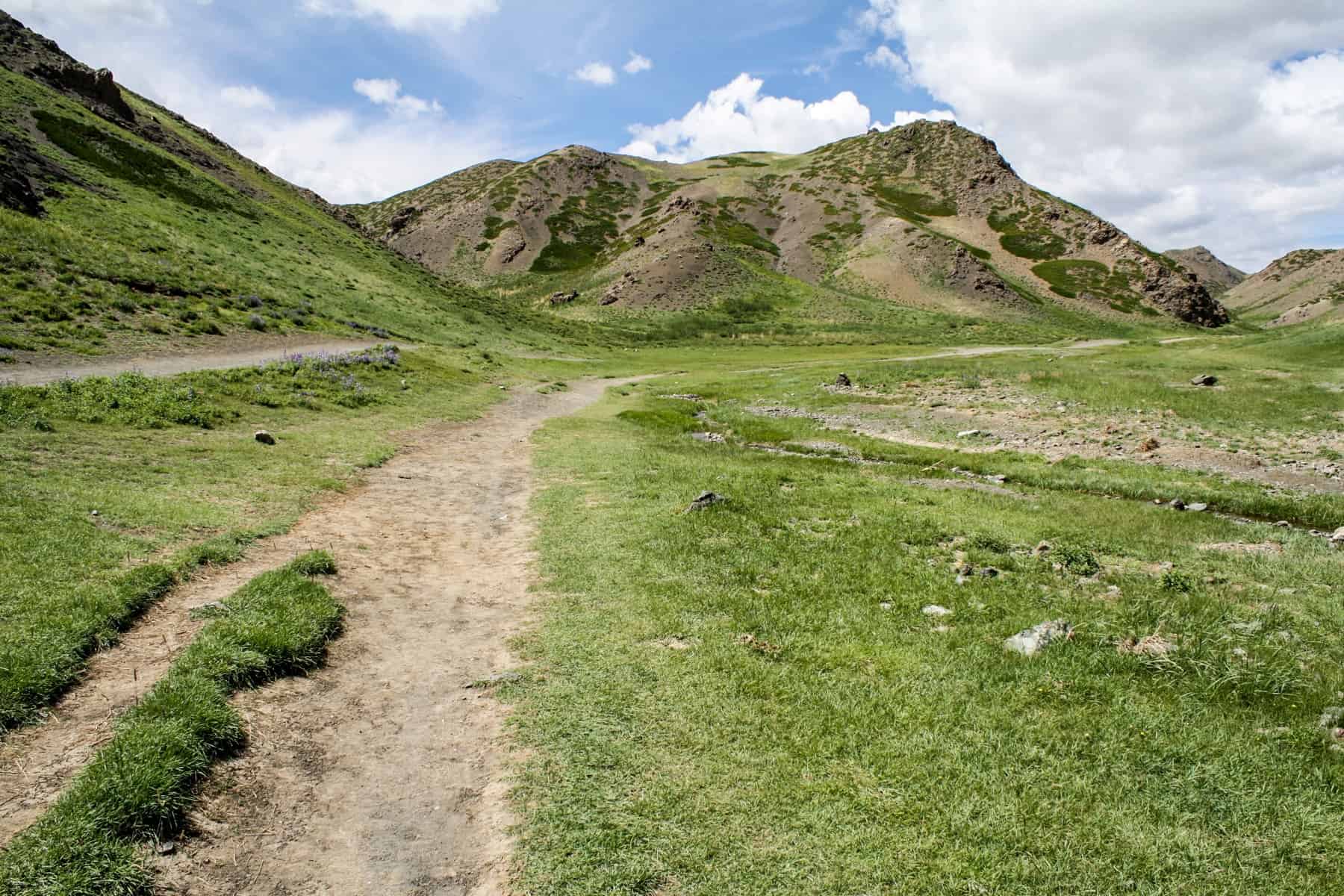
The lush green leading to the soft peaks in the Orkhon Valley Mongolia
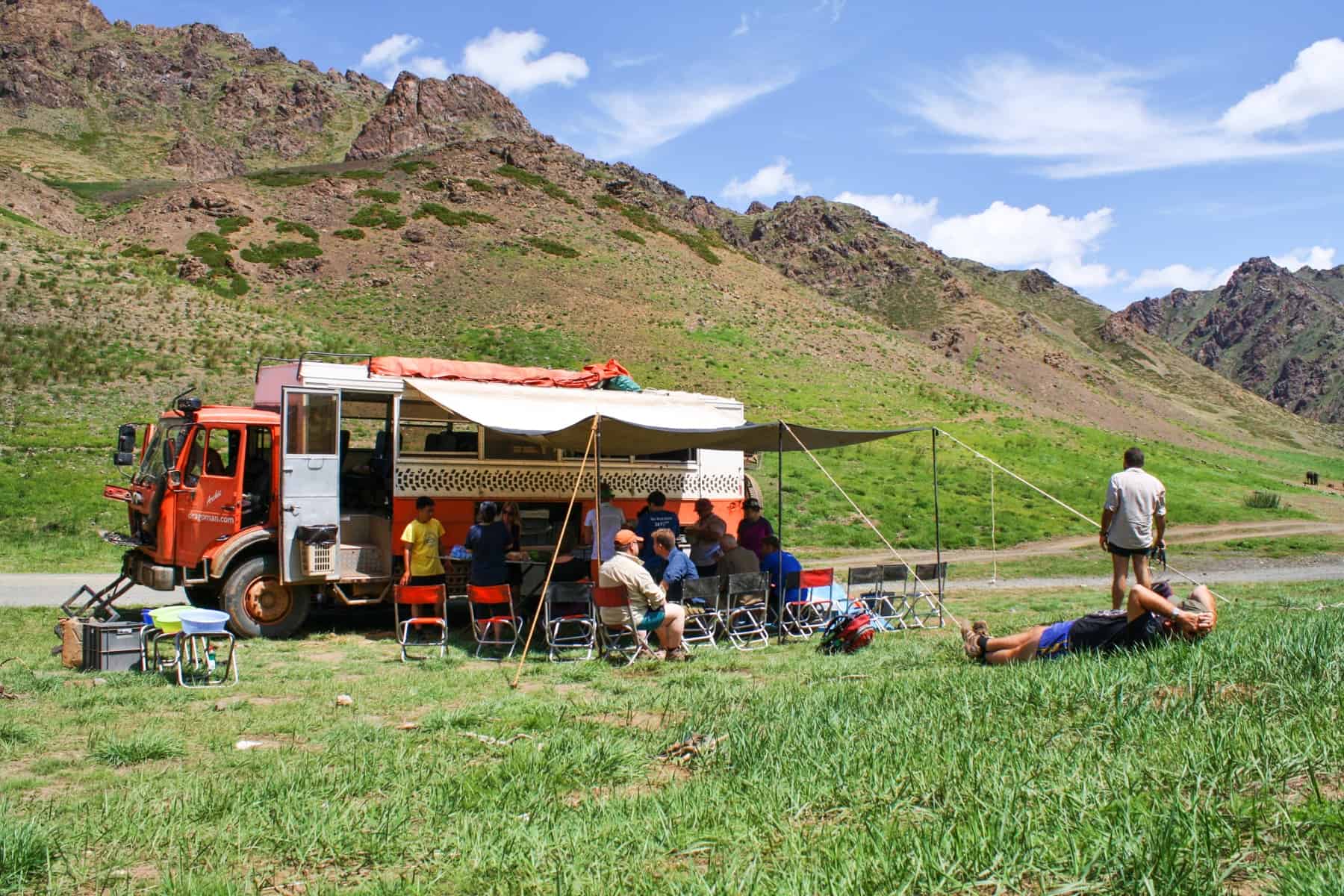
A rest stop in the scenic Orkhon Valley landscape
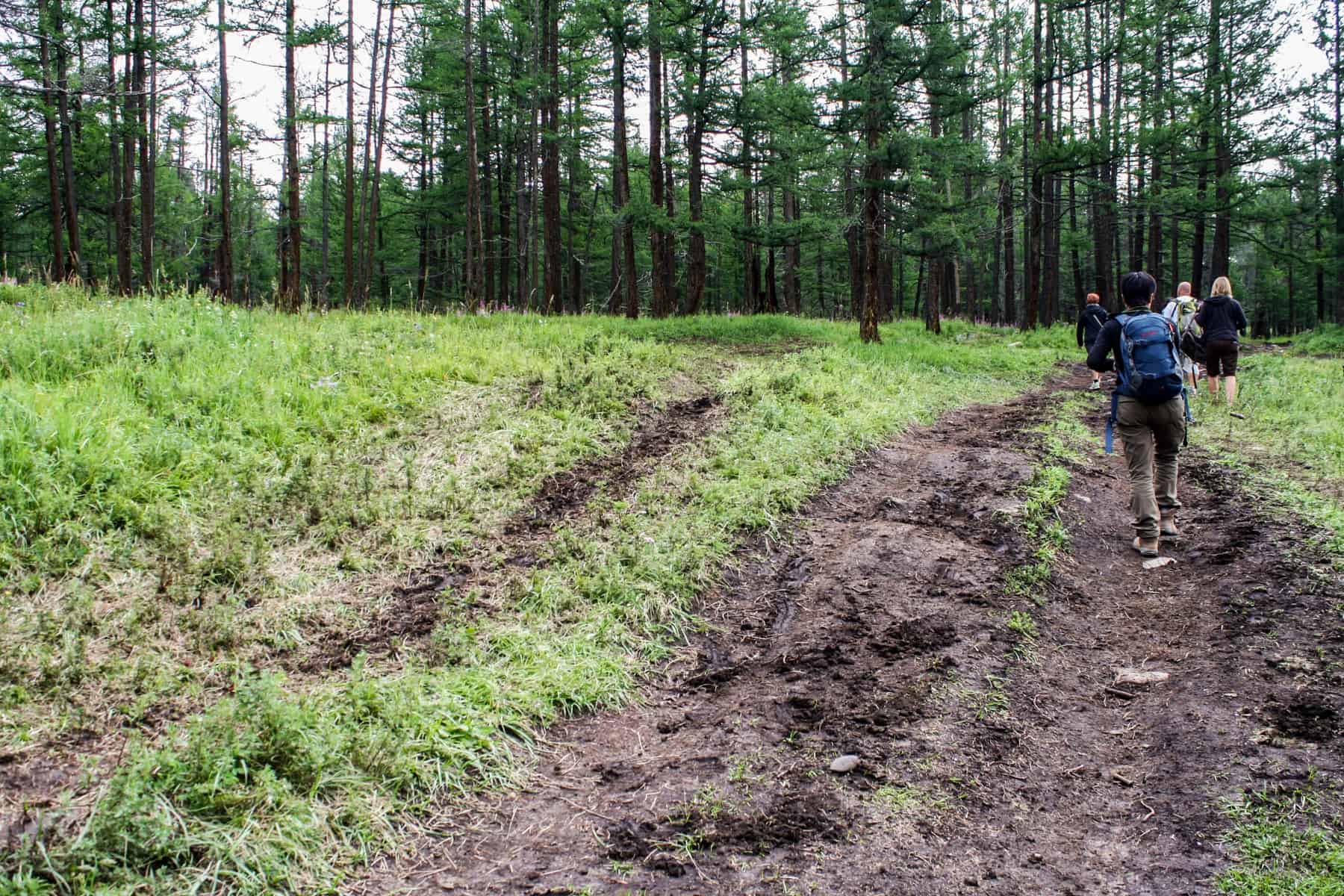
Hiking the forest trails of Mongolia’s Orkhon Valley

The rocky plateau that surrounds the Tövkhön Monastery in Mongolia

The colourful entrance to the Tövkhön Monastery
The Orkhon Valley waterfall was the next stop on our five-hour drive to the next ger camp. This camp plays host to the famous hot springs in the region, where we went skinny dipping and enjoyed a few refreshing beers.
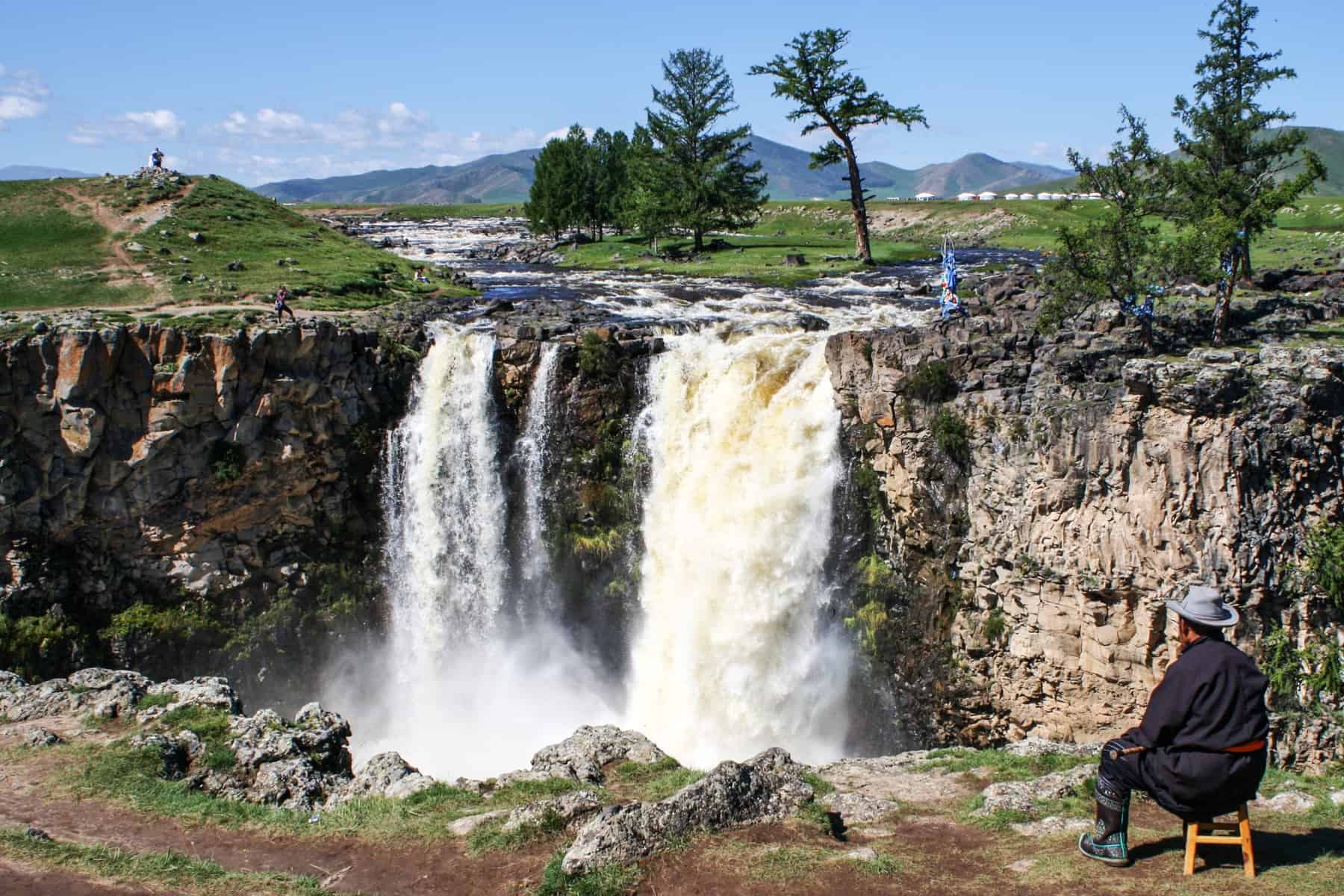
A Mongolian man sits in a chair peacefully enjoying the backdrop of the Orkhon Valley Waterfalls in Mongolia.
Fully clothed, of course, we took a short hike through the lush green forest to visit the source of the hot springs. When you come across your first sighting of trees after two weeks of barren land, you begin to appreciate such incredible surroundings.
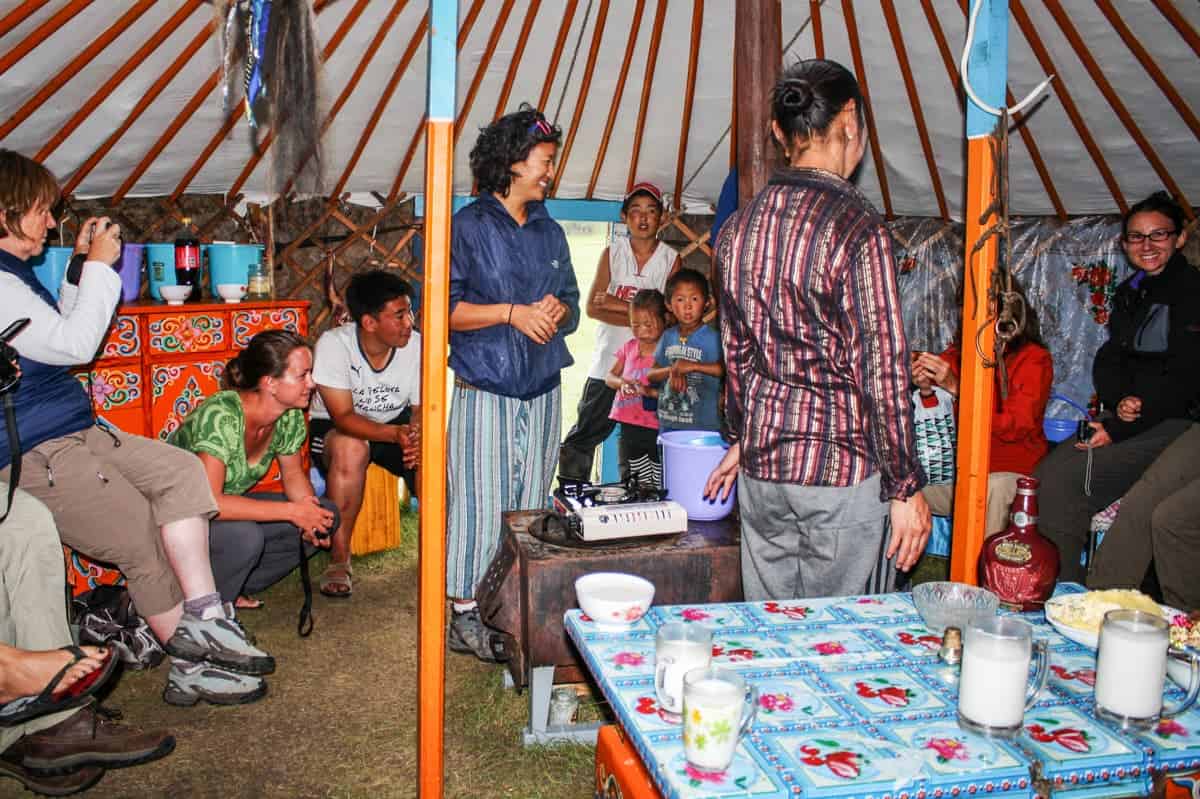
Visiting a local nomadic family in their ger in Mongolia
As we had two Mongolian guides with us (invaluable support in a country where very little or no English is spoken or understood), we could visit a Mongolian ger and a local family to learn about nomadic life.
It wasn’t a tourist set up, but a traditional, local family who lived on an isolated patch of land in the valley. We tried their dairy products (their source of income), including fermented mare’s milk, curd and butter, before learning about ger rules and traditions and asking each other many questions!
READ MORE: Visiting a Mongolian Ger – Understanding the Nomadic Culture of Mongolia
We needed a quick stop in the nearby town of Tsetserleg to stock up on food supplies. It was a market day with an electric atmosphere. I get a high from moments when you don’t know where you are and what to do, and where you have to work hard to communicate and negotiate.
We later visited the most important Monastery in the country, Erdene Zuu Monastery in Kharkhorin – the first Buddhist monastery in Mongolia that had up to 100 temples and 1,000 monks before the purges in 1937. Only three temples remained, alongside several statues and other items.
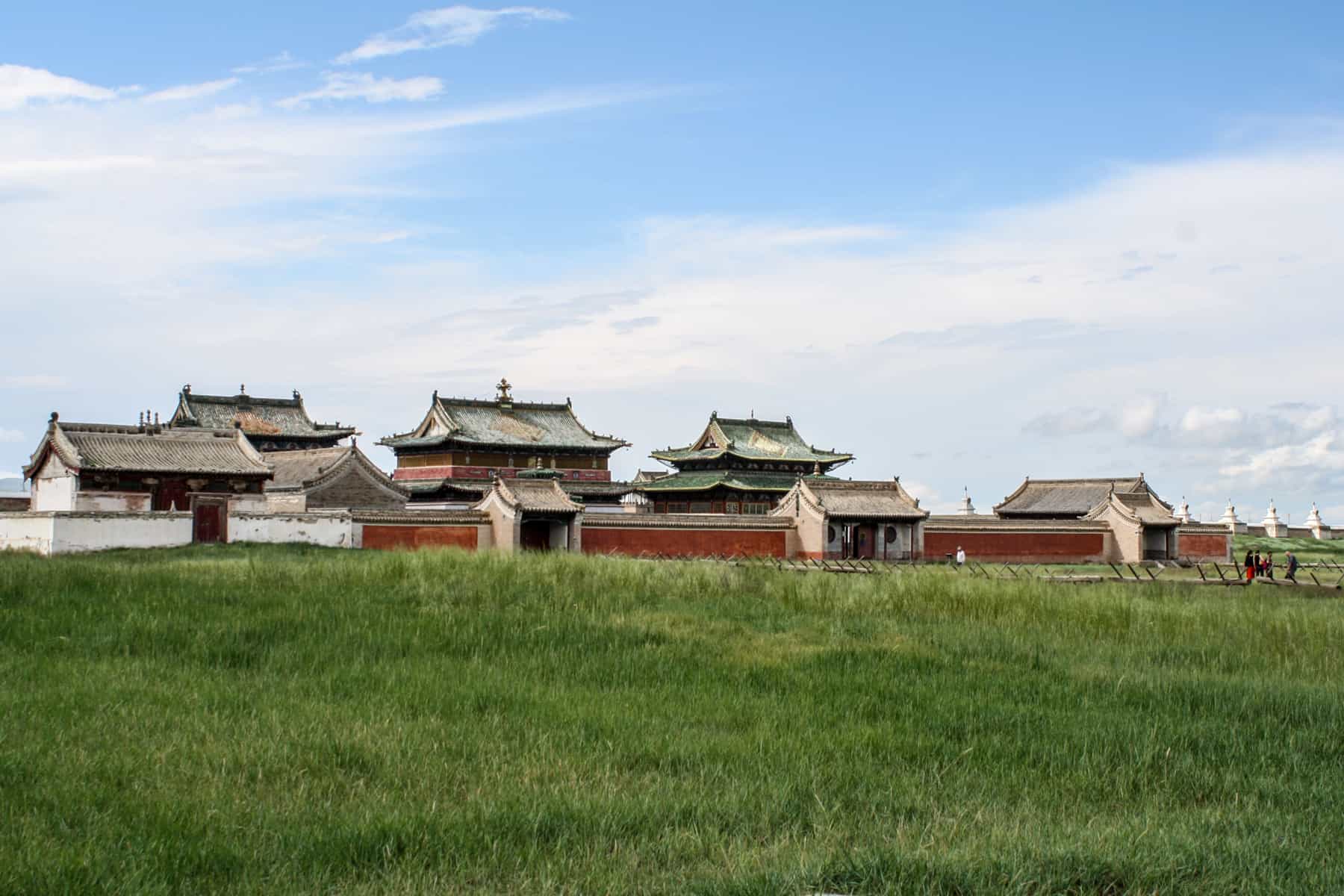
The exterior walls of the Erdene Zuu Monastery, Mongolia
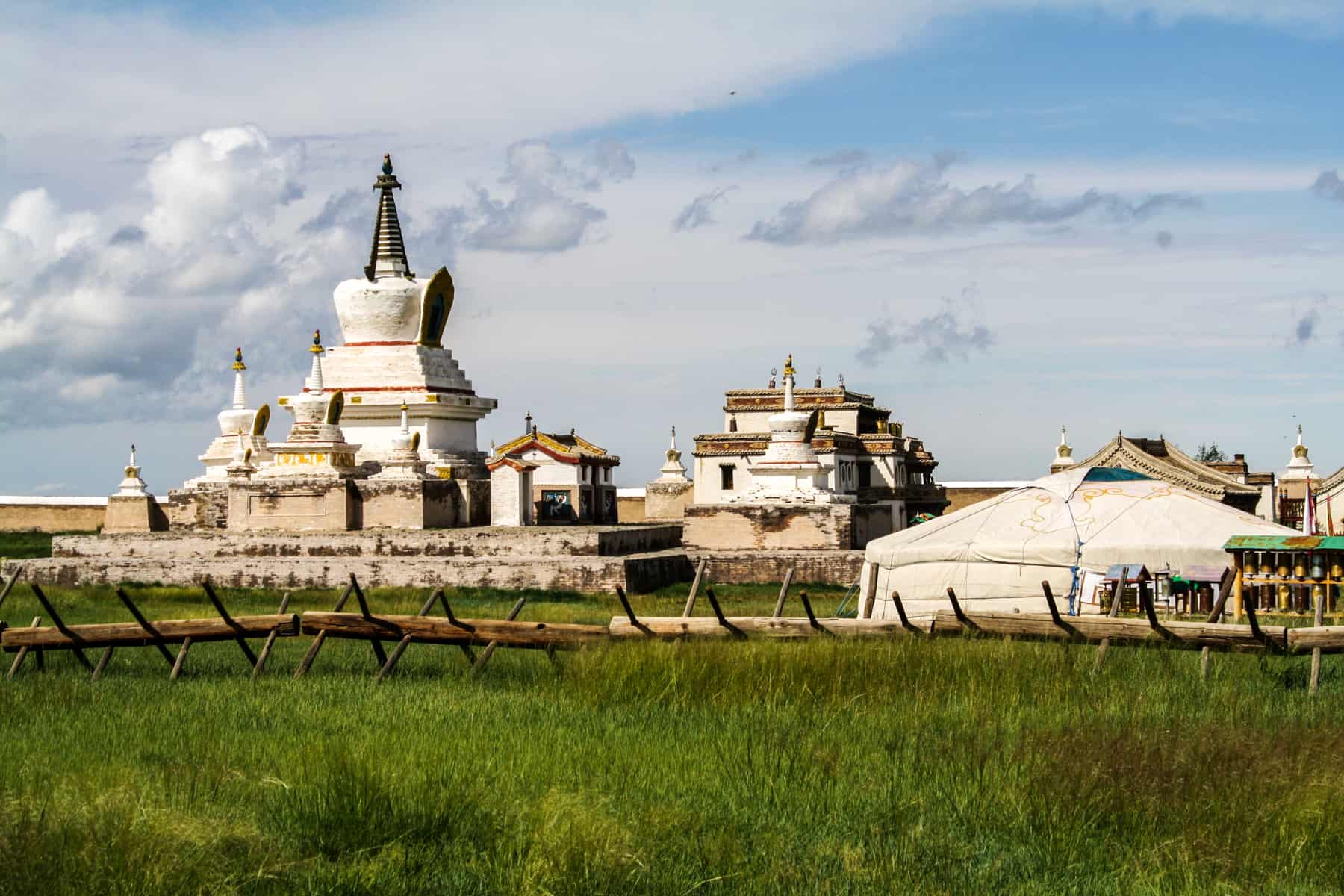
Part of the temple complex inside Mongolia’s Erdene Zuu Monastery
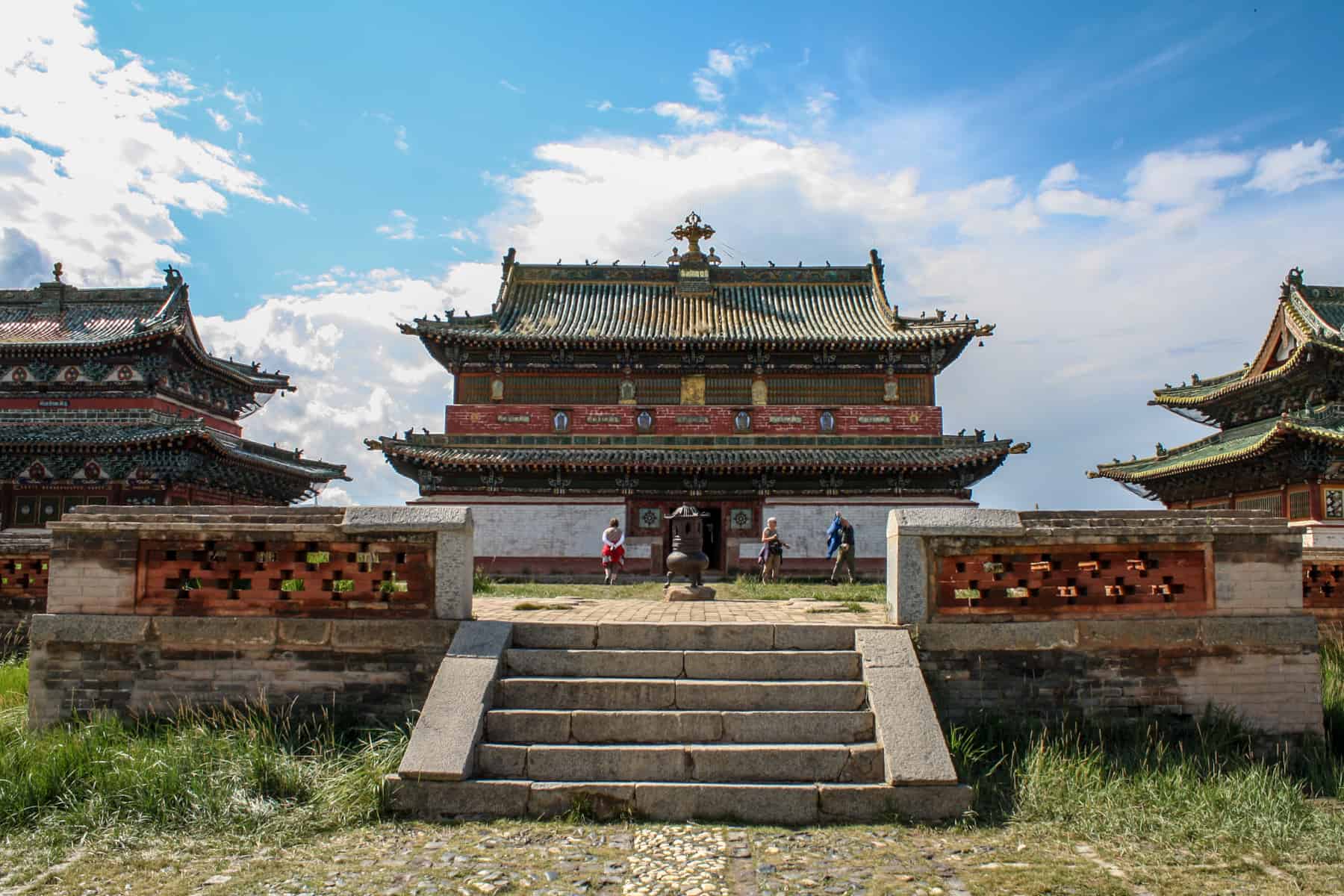
The red, gold and green temple structures at Erdene Zuu Monastery
A visit to the museum we camped next to – the Kultigen Monument, housing artefacts from the Turkish empire – set us on the way to the nearby Ugii Lake, where we would relax all day and camp for one night.
Ugii lake emits a calming atmosphere and invites you to traverse it slowly. While it would take almost a day to walk around, it’s a great place to unwind and reflect. I count this as one of my most favourite spots in all of Mongolia.
Our camping set-up beside Ugii Lake in Mongolia
We arrived at Hustain National Park in the afternoon to settle into a ger camp. This National Park is known for the rare Przewalski’s horse, unique to Mongolia. When you finally track down a small group, it’s still hard to see their beauty up close as you can’t get that close to them.
Still, we got to meet the ‘Best Mongolian Folk Band in Mongolia’ called Domog in the evening after a fantastic show where they performed rock-style tunes via the famed throat singing. I guess it is the equivalent of meeting Westlife in Ireland. Seriously.
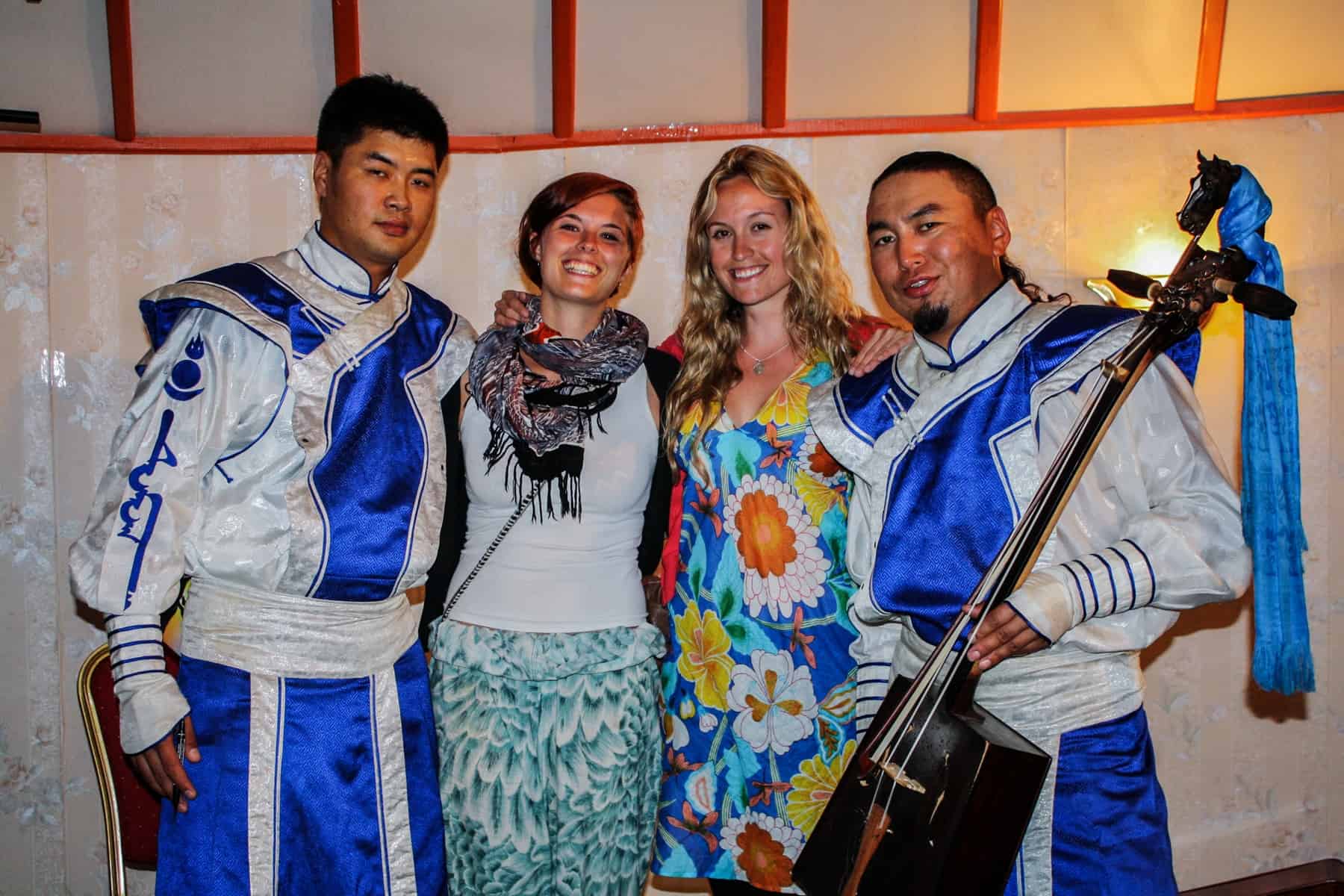
Meeting Damog, the Best Mongolian Folk Band in Mongolia
We had to journey back through the crazy, construction-overloaded, traffic-ridden Ulaanbaatar to get to Terelj National Park and the last ger camp of the trip (we were due to bush camp the weather put a stop to that).
It’s incredible how a few hours down the road from the capital brings you to some of the country’s most spectacular landscapes.
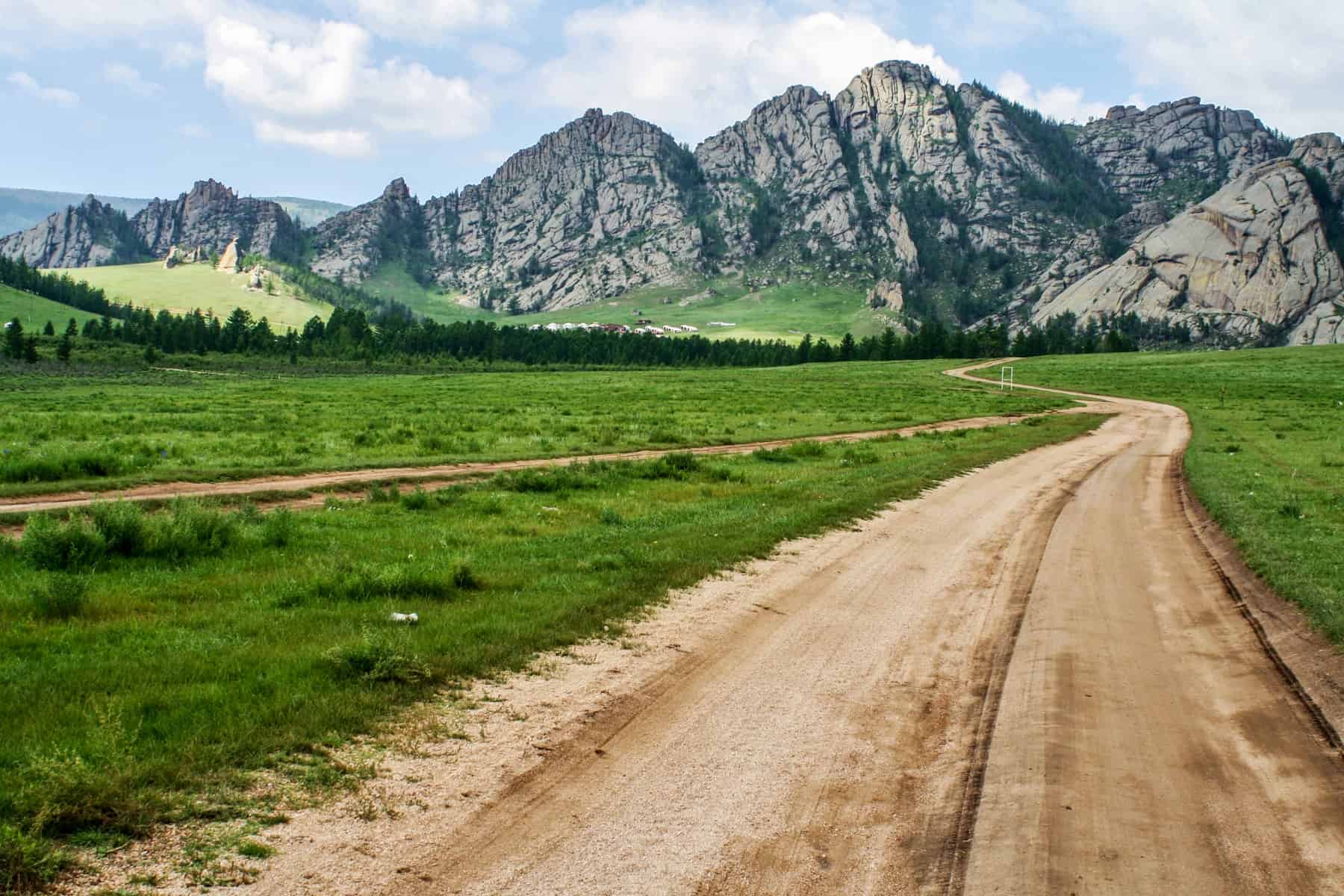
The road that leads to the heart of Terelj National Park, Mongolia
If you love walking and hiking, you will love Terelj National Park. Here you can wander for hours, hike to a Monastery and horse ride through the forests and rocky hilltops. Make sure you check out ‘Turtle Rock’ too. You may think it looks like something else from a certain angle!
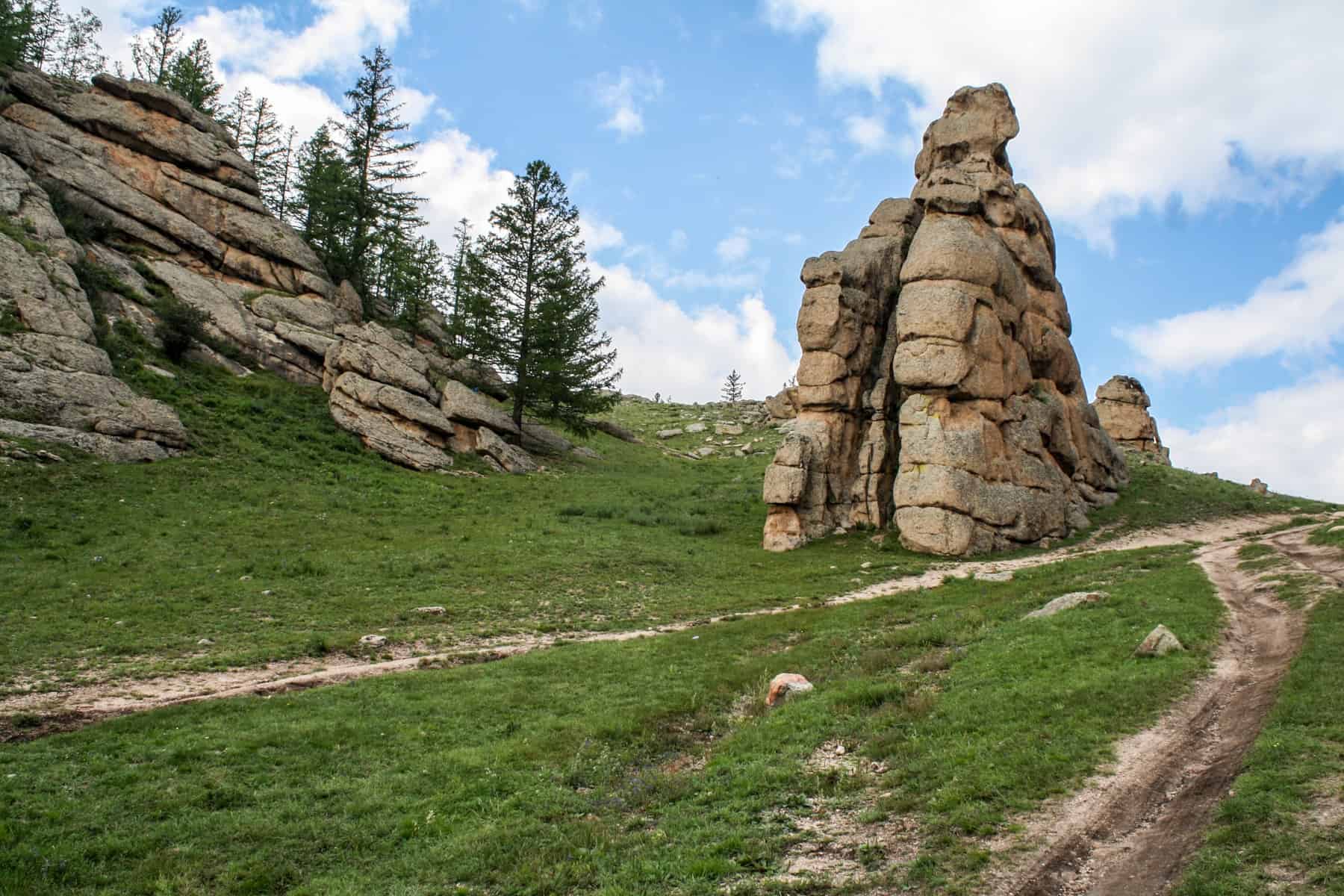
One of the layered rock formations in Terelj National Park in Mongolia
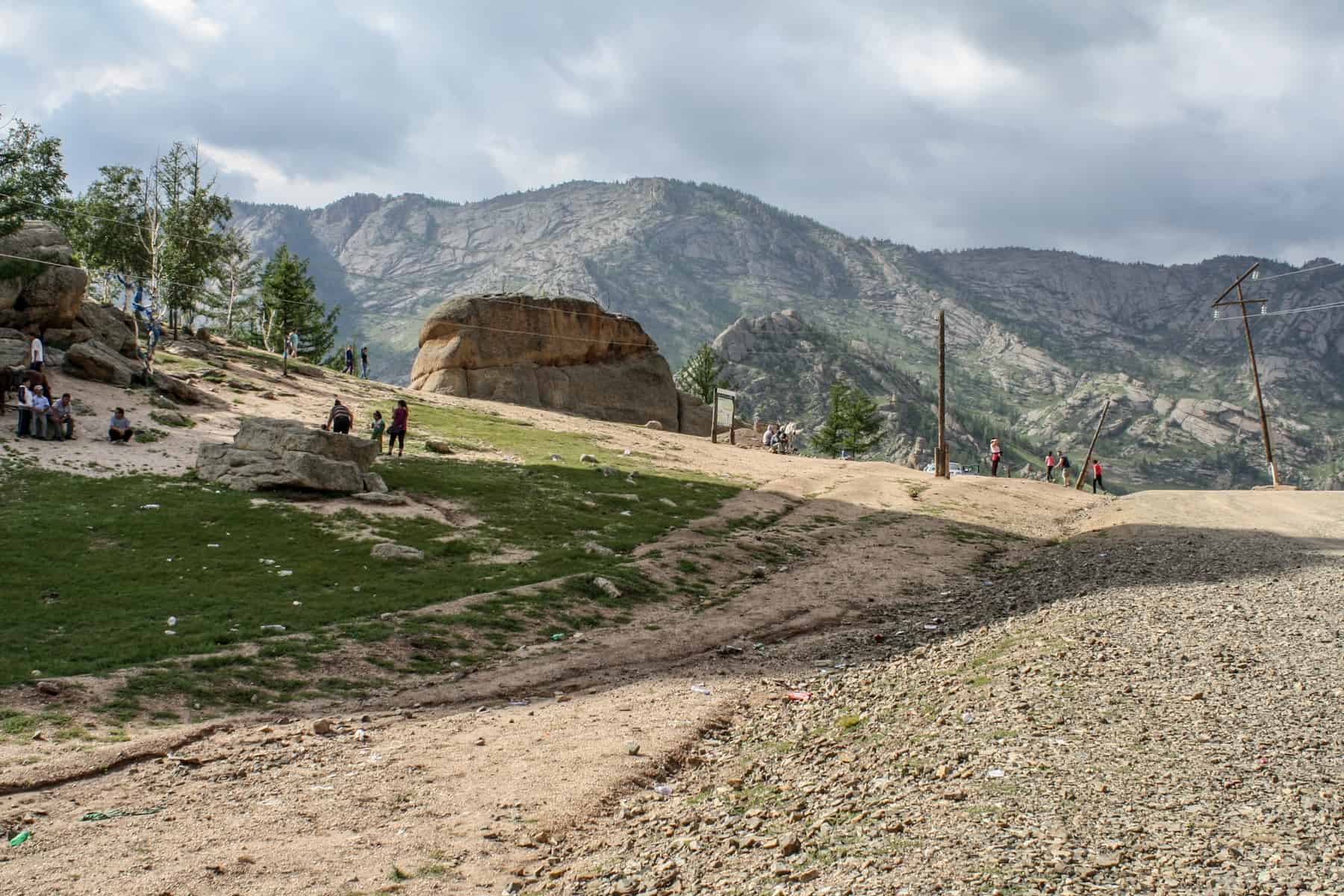
Visiting Turtle Rock in Terelj National Park Mongolia, named for its shape similar to the animal
Nothing beats the end of the wilderness journey than a visit to the giant 40-metre tall silver Ghengis Khan statue just outside of Ulaanbaatar on the banks of the Tuul River. Legend has it that it was at this spot that Ghengis Khan found his golden whip. Anyhow, a bit of a pilgrimage spot for locals, it was fascinating (if not a bit odd and imposing in the same way a colossal silver statue of Hitler in Germany would probably evoke the same feeling).
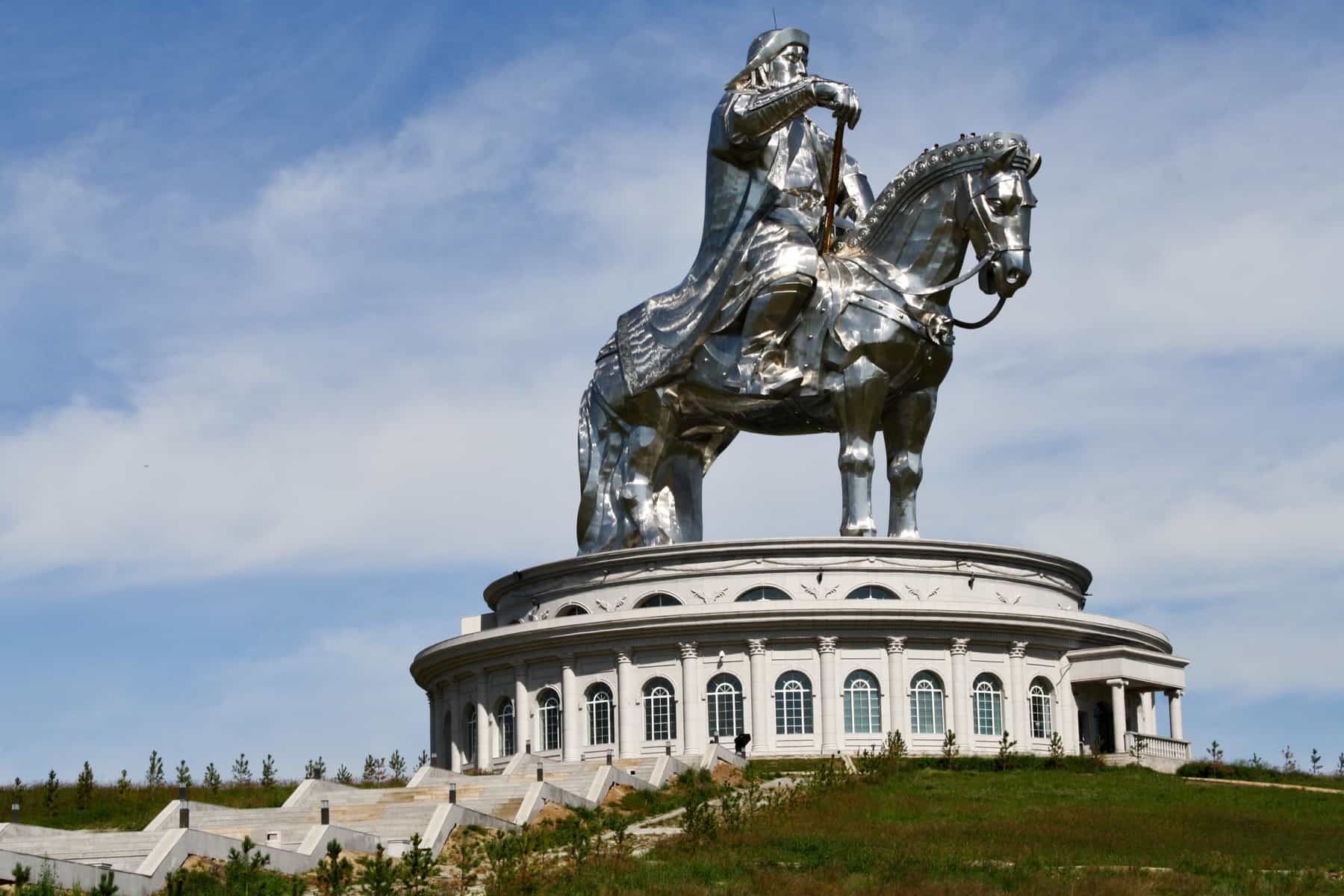
40-metre tall silver Ghengis Khan statue just outside of Ulaanbaatar, Mongolia
Back in Ulaanbaatar, I turned my hostel room into an office and distracted myself with a pizza slice, cake and coffee at Wendy’s Bakery – worth a visit alongside the State Department Store, which is right next to the hostel area. It’s an excellent chance to rest up after adventure through the vast landscapes of Mongolia.
The Dragoman overland truck is what we called home, except we didn’t sleep on it overnight. Instead, we went wild camping and every night, checking into a hotel once when the rains were too much to settle a tent comfortably.
The Outside
The truck’s exterior has lots of compartments – storage for luggage and tents and a clean water supply, mealtime equipment and food supplies. It’s a travelling transformer, and everyone has to lend a hand setting up and packing down for breakfast, lunch and dinner.
If you have no sense of camaraderie or hate getting dirty, then this isn’t the kind of adventure trip for you. I embraced it and loved every minute of ‘roughing it’.
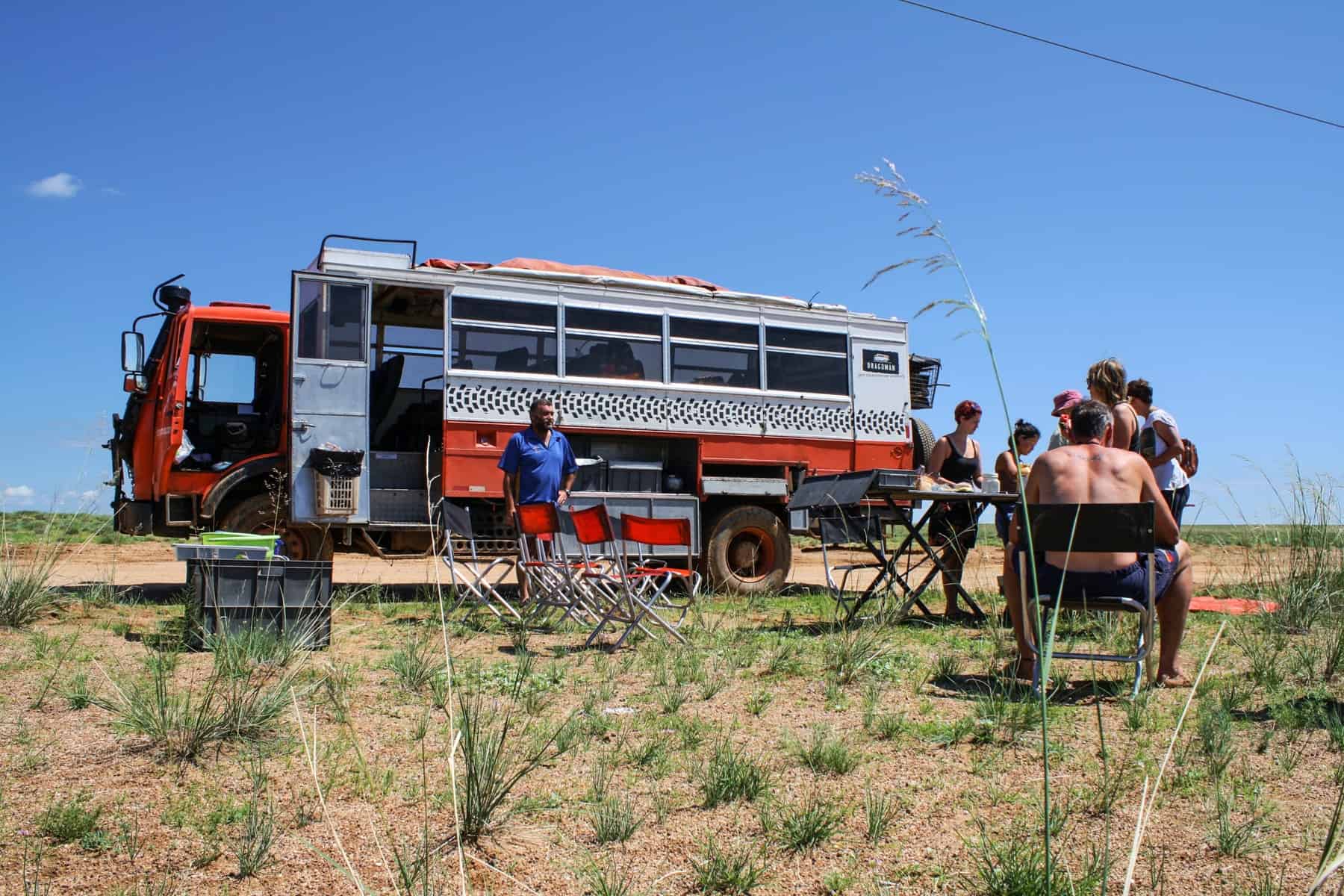
Travel in Mongolia was mostly about camping.
Twenty-three seats, a fridge, a safe, a bookshelf, prominent speakers and a place to recharge equipment, this is where we spend hours at a time, or what could end up being an entire day, traversing the landscape. We filled it with our belongings like a messy bedroom and made it cosy.
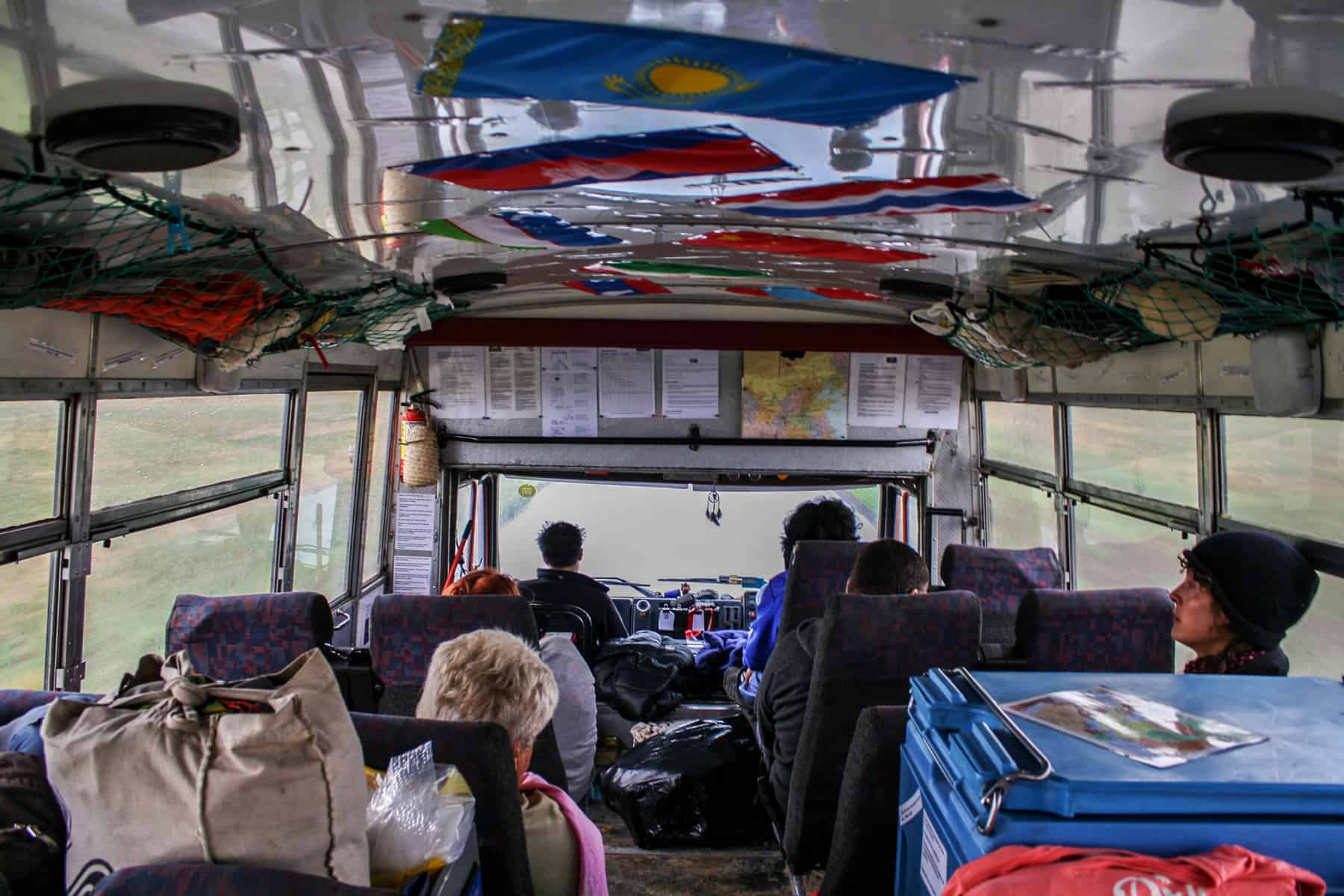
Inside the Overlanding truck on the journey travelling Mongolia
Along the Way
The two drivers are the mechanics, the navigators and the troubleshooters. Everything about the truck, from where it goes and how it gets there, hangs on their decision making, alongside our Mongolian guide who knew the land better than anyone else and could speak the language when we needed to call upon locals for help.
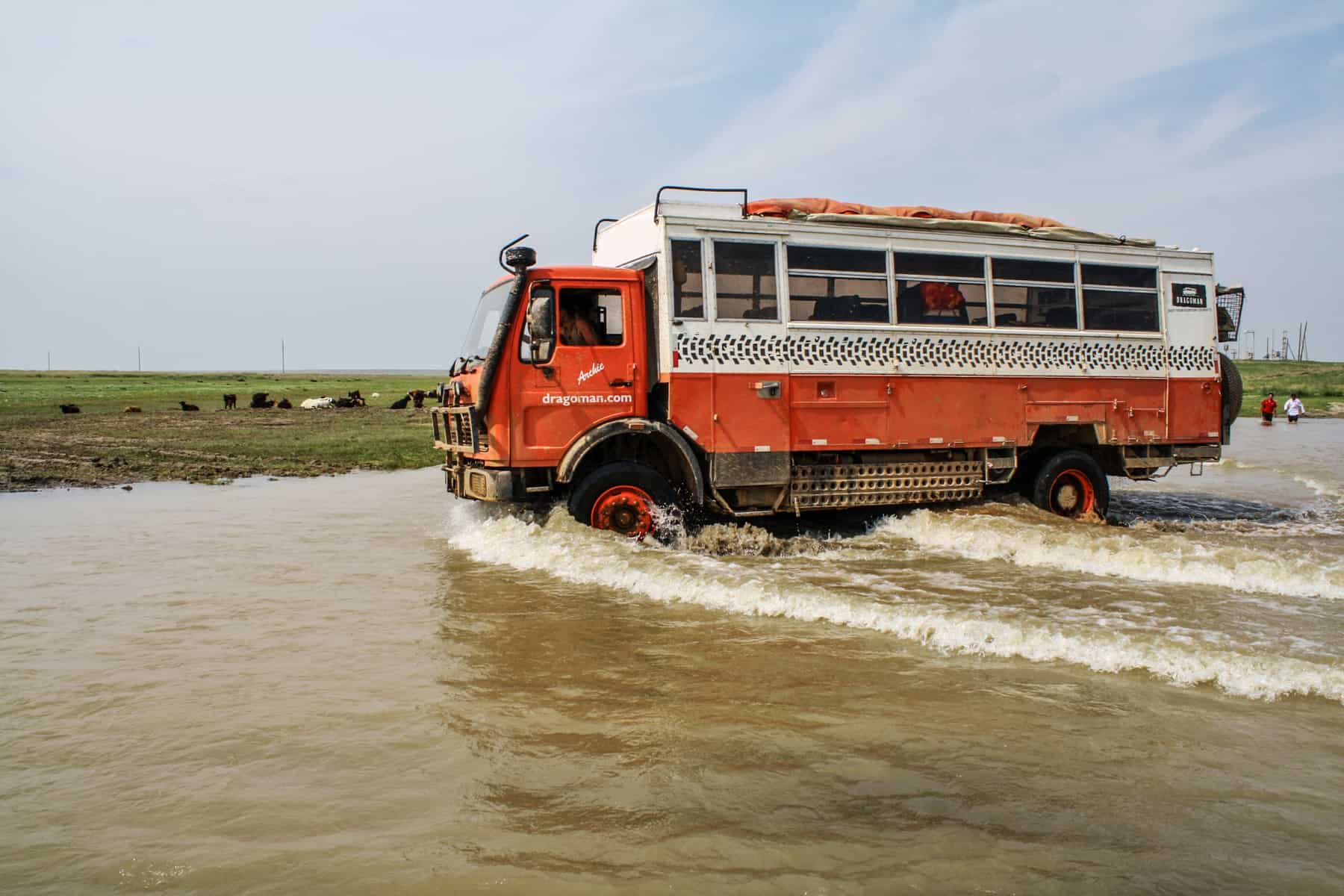
Overlanding in Mongolia was a real adventure.
Although the drivers would jump out to check the road, walking far ahead to determine the best track to take or check waterlogged areas (often by getting in the water) to limit the truck’s chances of getting bogged. We often stopped to help locals whose cars were stuck, knowing that karma would need to be returned one day.
The Realities of Rural Travel in Mongolia
“Ok, guys, you have to get off. It’s not looking good.” This phrase, accompanied by the engine’s low hum and strain as it finally gave up, became a regular occurrence during the three weeks I spent in Mongolia. Getting dirty in Mongolia is a given, but I never thought on my travels that I would push a truck out of thick, stodgy mud, build a road complete with a dam or wade knee-deep through a river to get to the other side.
In Mongolia, aside from the small handful of roads available, you will take the path less travelled, one that hasn’t been used for days or worn in by other vehicles for an easy pass. You could call it bad luck, or you could call it a reality, but travel comes with its challenges and getting stuck in Mongolia is by far the most common. While I wasn’t expecting substantial bogging incidents on this trip, I began to embrace them when they did happen. After all, the locals have to face these situations regularly. It became a part of what Mongolia is and what it means to cross her lands.
The drivers of the truck were responsible for assessing each situation when it arose. They were the first to get dirty, walk through the water and determine the outcome. At times it put you on edge, wondering how long you would be stuck somewhere with no one passing by for hours. At other times it merely meant us having to walk a short distance to lighten the truck.
Either way, the result was a massive whoop and roar for our truck, Archie, when he made it through. It felt good, and we then knew the next stage of the journey could begin. These are the times I’ll always remember.
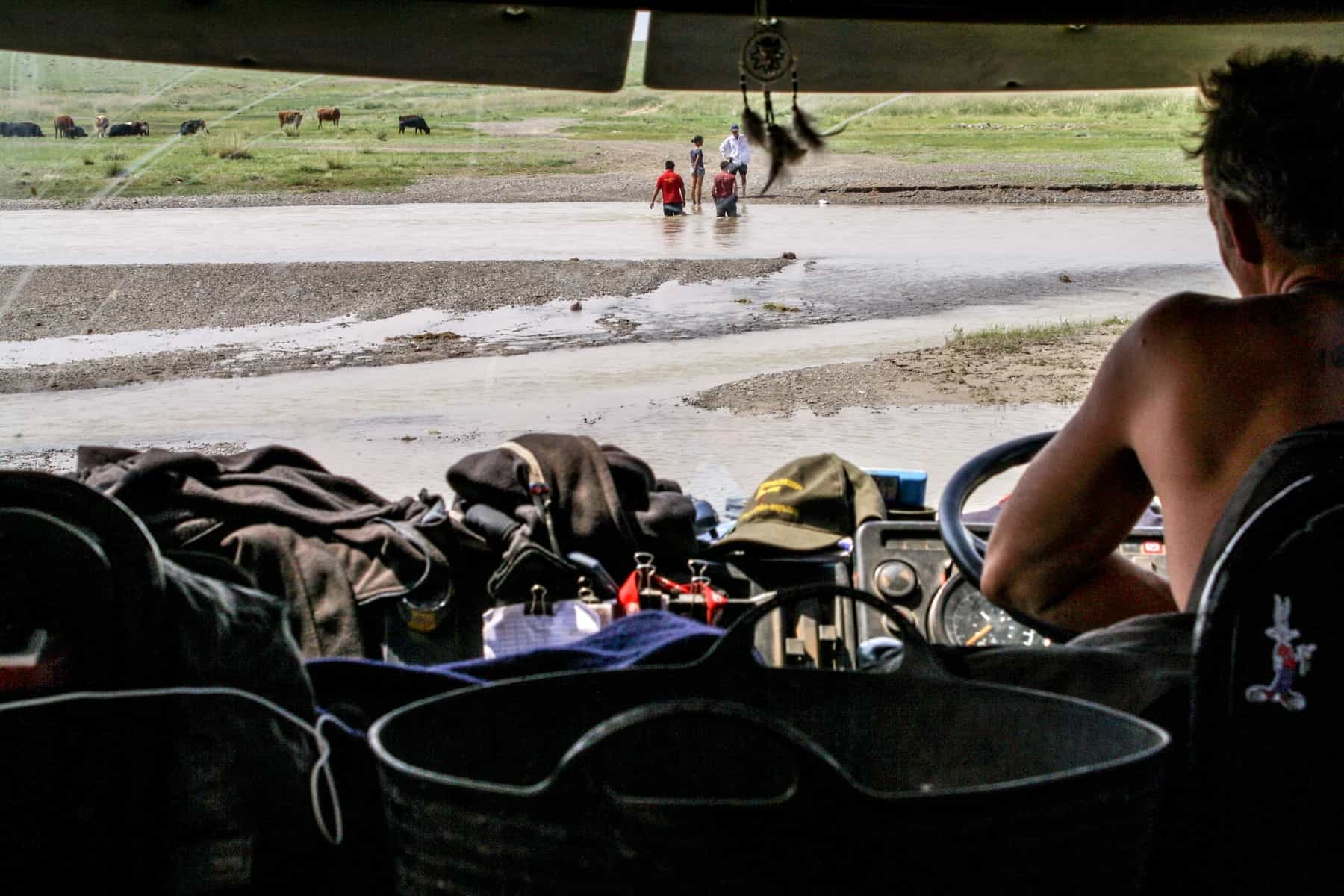
Our group helps find a track in the water for the truck to pass in Mongolia.
It had been raining on and off for a few days, mainly in short spurts in the evenings, and we were bumping along the wet dirt tracks just fine. When the truck stopped, and we saw that two pools of water had filled two road tracks, we knew a bogging incident was imminent. The drivers walked, pondered and walked through the water. Could we drive through it without getting stuck?
The usual scenario rested on two possibilities – drive through it or find hard enough ground around it. Except that this time it was different. We were told: “We need to empty this road of water and then let the ground dry out so we can cross over it.”
Cue the mad dash to empty our camping gear to find our plastic washing-up bowls and any other form of a plastic container to begin the removal process. The ladies rolled up their shorts to get right in there and scoop out the water as the men started digging to create a road. Everyone built a dam by hand on each side of the tyre track grooves so that the emptied water wouldn’t flow back in.
It was hard work, but we became a team, a great team. The sun was shining that day which meant we only had to wait a couple of hours while the heat dried out our creation. We ate, we played, we sang, and we marvelled at what resourceful people we were. It was a scary moment when Archie made his move to cross our road (our beautifully crafted highway that could be crushed in seconds and need rebuilding), but he made it in one unbeaten run, and our handmade route was left to the land and in nature’s control.
Happening upon grassy, muddy areas is sporadic. You can never tell exactly how hard the ground is beneath it. After bouts of rain, the ground softens, and even though there were times when the truck had to work a little harder, it made it through.
We had just had a fantastic afternoon checking out a local Nadaam festival and were in high spirits, which we needed knowing that we would be driving for the rest of the day. Except we didn’t – we were soon stuck in thick, sticky mud, and no amount of pushing and revving was going to change it.
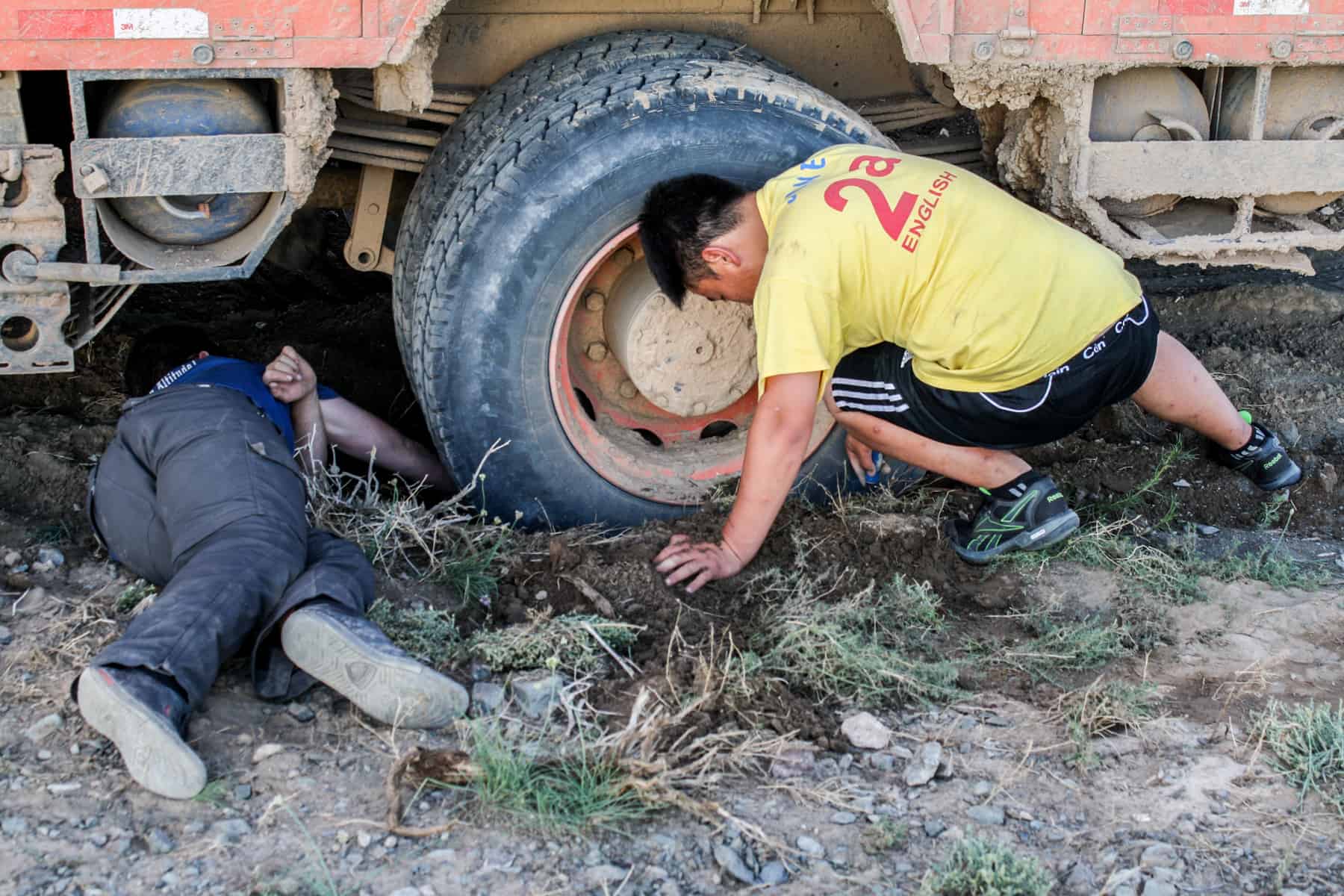
Digging out the truck wheels from the deep, wet mud in Mongolia
Our Mongolian guide walked to the nearest ger to get help, and the locals later returned on a motorbike to check out the situation. The whole family came out – we regularly became a source of fascination or amusement en route through the country. However, they kindly decided to use their big, industrial tractor to help pull the truck out of the mud – that too got stuck.
With two vehicles out of action and night starting to fall, we decided to set up camp on a drier patch of land nearby, and the drivers worked relentlessly with the locals throughout the evening. We got bogged at 5 pm, and it took until midnight for the truck to be pulled from sludge. It was a day wasted, but another example of how unpredictable travelling here can be.
When the truck stops dead at a deep area of water, you know the situation isn’t going to be resolved quickly. Can a truck this size pass through a river without sinking or getting stuck? Although we enjoyed paddling in the freshwater, we didn’t know whether we could have to completely re-route to get around it and lose more time.
The conclusion was that there was a distinct lack of knowledge about alternative roads around the river, and somehow we would have to find a way to get through it. With a small truck already stuck right in the middle, it was a scary prospect.
The drivers identified the most shallow and hard ground area in the water to pass, although we couldn’t be on the truck, unfortunately. You can imagine the chaos – a group of locals trying to rescue their vehicle and 20 non-locals trying to navigate through the water, knee-deep and screeching, scared of falling in.
My heart skipped a beat watching our truck splash through the water and wondering whether it would stop dead in its tracks and slowly swim in a sea of mud, taking all our belongings with it. But Archie made it, and this time, he got the biggest cheer. And a giant sigh of relief.
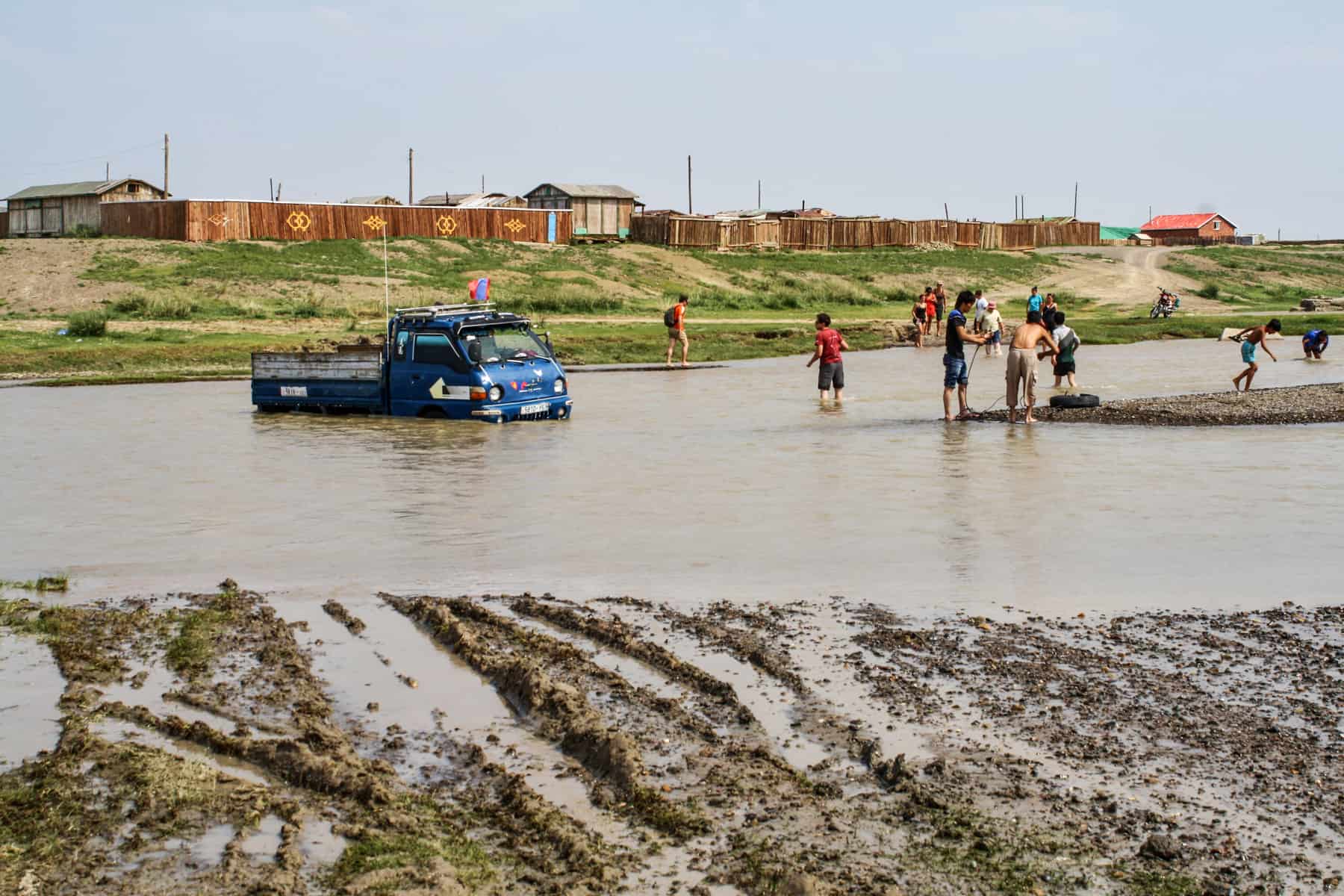
Typical river crossings in Mongolia and helping out locals who were also stuck
With unpredictable weather conditions, a challenging landscape to navigate and a trip mostly comprised of wild camping, packing for Mongolia requires some planning. In short, you need to factor in the following:
- Items of clothing that you don’t mind getting dirty and wholly ruined.
- Clothing layers for the constant switch of hot and cold climates – thermals to moisture-wicking and waterproof items.
- Sun protection and bug spray for mosquitos and sandflies.
- All medications you need as you’ll often be far from any significant stores or aid.
- Snacks from home as the food variation can get very repetitive.
For a more extensive overview, read my full Mongolia Packing List .
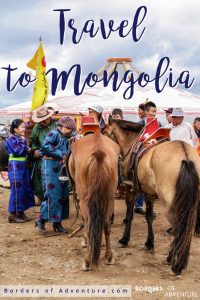
About Becki
Becki Enright is a British Travel Press Award-winning writer whose work focuses on changing perceptions about misunderstood aspects of destinations. Her writing combines storytelling with insight into the social, historical, political and economic factors that shape the country or place in relation to tourism. Becki has appeared live on Sky News and CNN and has contributed to high profile media including National Geographic, Time.com, Guardian online, New York Times, Grazia and Buzzfeed.
- Article Archives
- Work with me
- Privacy Policy


This remote eco-lodge offers travelers a rare opportunity to experience Mongolia’s Gobi
E ditor’s Note: This CNN Travel series is, or was, sponsored by the country it highlights. CNN retains full editorial control over subject matter, reporting and frequency of the articles and videos within the sponsorship, in compliance with our policy .
It’s early morning and an orange glow has filled the sky as the sun slowly rises over a seemingly endless desert landscape.
Every few hours, herders walk into view, hundreds of sheep and goats in tow as they make their way to the nearby water well.
The only sounds to be heard are the wind, the brays and barks of native animals and the occasional rumbles of 4x4 vehicles bringing new arrivals.
It’s all part of the isolated wilderness experience on offer at the Three Camel Lodge , an eco-resort in Bulgan in Mongolia’s Gobi (which means desert), one of the most remote places on Earth.
Far from civilization, the lodge aims to give visitors an up-close look at Mongolia’s traditional nomadic lifestyle – a community of people who survive on the Central Asia plateau by relying on domesticated livestock.
While there aren’t many nomadic cultures left in the world, it’s still very much an integral part of Mongolian life. Today, nomads make up around a quarter of the country’s population of more than 3 million people.
The lodge has 40 gers. These round, tent-like dwellings are made of wood, felt and rope – materials flexible enough to be carried around, easily assembled and strong enough to withstand the desert’s strong winds.
Inside, the set-up is simple – there are wooden pieces of furniture and other bits of decor. But each one features luxuries not usually found in a nomad’s home – like a private bathroom with running water and electricity powered by solar energy.
The Three Camel Lodge also has an on-site restaurant, a bar (with a very extensive whiskey selection) and even a spa – surprisingly extravagant, especially in this part of the world.
How the Three Camel Lodge was born
The Three Camel Lodge was the brainchild of 68-year-old Mongolian-American businessman Jalsa Urubshurow.
As a child growing up in the US in the 1960s, he could only dream of the dramatic landscapes of Mongolia. But the country’s culture was always in his heart, thanks to his father’s colorful stories.
“Mongolians have a pretty accurate genetic tracing system … you can pretty much determine what geographical region within several 100-mile radiuses where your tribe, your ancestors originated,” says Jalsa, whose father was born in Kalmykia, now a southern region of Russia.
“(My father) reminded me of this in the middle of New Jersey while I was growing up.”
In the early 1990s, when Mongolia opened its borders to international tourists, Jalsa was able to visit for the first time.
“I’ve been to many Mongolian weddings in New Jersey, you know, but that was the extent of it. (The visit) invoked so many different images,” he says.
“I got to go out to the countryside and meet a herder and stay in some ger camps … it was an amazing experience.”
Soon after, Jalsa was tasked by the prime minister of Mongolia to bring in more travelers from the West. In 1992 he started a travel services company, Nomadic Expeditions , providing tours in Mongolia and other countries.
“It took me two years to get anyone to come,” he recalls.
In 2002, Jalsa decided to build something more permanent in the Gobi, and the Three Camel Lodge was born.
A land of dinosaurs and flaming cliffs
The Gobi is known as the land of the dinosaurs – and it’s an intrinsic part of Mongolian culture.
Just a half-hour drive away from the Three Camel Lodge is one of the most important dinosaur fossil sites in the world.
At Bayanzag, explorers made the first scientifically-recognized discovery of dinosaur eggs a century ago. While finding the nests with his team from the American Museum of Natural History in the 1920s, paleontologist Roy Andrews aptly named the site “The Flaming Cliffs” after the red sandstones that seem to come to life at sunset, turning the entire area into a fiery red color.
Here, dinosaur fossils are still being found today.
“This place is really mysterious … it’s kind of secretive and secluded. It’s really a special place for me,” Buyandelger Ganbaatar, Nomadic Expeditions’ in-country director and lead tour guide, tells CNN Travel.
“It used to be sand dunes about 70 million years ago. The Flaming Cliffs was known as an ancient settlement. One of the reasons for Andrews’ expedition was to prove that humankind originated in Central Asia and he was looking for the evidence.”
Speaking of dunes, another popular area attraction within reach of the lodge is Moltsog Els – a mere 15-minute drive. Despite being in the desert, it’s one of just a few regions in the Mongolian Gobi that’s covered in mounds of sand.
Here, guests can explore the dunes on foot or hire a camel from one of the local herding families around the area.
Beyond dunes and red stone cliffs, the Gobi is also famous for its greenery. An hour’s drive from the lodge, Yol Valley was originally established to conserve birdlife, including the Yol, or bearded vulture.
Guests can also journey to the protected Gobi Gurvan Sakihan National Park, which is rich with biodiversity – from white gazelles to leopards and golden eagles. The valley can be explored on foot or horseback – in the summer, a brook runs through the deep and narrow gorge.
Other experiences on offer at the lodge include nomadic archery sessions, stargazing, cycling and cooking classes.
Sustainability pioneer
With such pristine nature all around, preservation has been critical from the get-go. Being in an area so remote, it was important for Jalsa and his team to put the right infrastructure in place.
Considered a pioneer in sustainable tourism, the Three Camel Lodge today follows three main pillars: sustainable stewardship, preservation and community empowerment.
The lodge started by eliminating single plastic bottles, instead handing out metal reusable tumblers to its guests. They also built a waste management system from scratch, diverting garbage from landfills by creating a greenhouse for composting. Solar panels power nearly all of the lodge’s lighting. Materials for construction, furniture and décor are sourced as locally as possible – within 50 miles of the lodge.
“I think you have to have a commitment through architecture, your surroundings and design and operations to the culture that you’re trying to promote,” says Jalsa. “Finding some level of authenticity that is constant, that’s the underlying spirit. Ongoing sustainable tourism is based on hiring locally.”
For Jalsa, that means investing in local people. There are nearly 30 full-time Mongolian staff at the Three Camel Lodge – and it was important that they share the same sentiment.
“It’s a wonderful thing if you can be protecting our planet, and sharing your culture with people,” he says.
Investment in the wider Gobi community is also an important part of the lodge’s sustainability goals, whether that is supporting educational programs or working with international paleontological organizations to help protect dinosaur fossils.
“Mongolia is one of the last places you can get away and see pristine wilderness and wonderful landscapes,” says Jalsa.
Getting there
Getting to and from the Three Camel Lodge isn’t for the travel-weary – did we mention it’s remote?
“It’s a seven, eight-hour drive (to the Gobi), and your average tourist doesn’t want that,” Jalsa tells CNN of the journey from Mongolia’s capital, Ulaanbaatar.
There are flights to the Gobi but they tend to depart in the middle of the night and arrive at Dalanzadgad Airport just as the sun starts to rise. After that, it’s another hour-long car ride across the roadless desert before the lodge emerges in the distance, almost like an oasis.
Getting out of the Gobi can be even more complicated – flights back to the capital are often canceled (ours were axed, twice) with short notice. In the winter, some flights don’t operate at all.
Currently, Jalsa says the lodge is open for business from the beginning of May until November. He hopes there can be more support from the government to improve logistics and also expand the annual tourism season, at least “just a little longer.“
“I think the government, for them to embrace tourism, they (should) subsidize air travel domestically, especially if it’s for tourism,” Jalsa says.
“Essentially, you’re bringing clients to the country, and you make places within the country accessible for them. I think it’s a wonderful opportunity, and we’ve been working for 30-plus years to put it on the map.”
For more CNN news and newsletters create an account at CNN.com

Things to Do in Monino, Russia - Monino Attractions
Things to do in monino.
- 5.0 of 5 bubbles
- Good for Kids
- Budget-friendly
- Hidden Gems
- Good for Big Groups
- Adventurous
- Good for a Rainy Day
- Good for Couples
- Honeymoon spot
- Good for Adrenaline Seekers
- Things to do ranked using Tripadvisor data including reviews, ratings, photos, and popularity.

1. The Central Air Force Museum
The Unique Burial of a Child of Early Scythian Time at the Cemetery of Saryg-Bulun (Tuva)
<< Previous page
Pages: 379-406
In 1988, the Tuvan Archaeological Expedition (led by M. E. Kilunovskaya and V. A. Semenov) discovered a unique burial of the early Iron Age at Saryg-Bulun in Central Tuva. There are two burial mounds of the Aldy-Bel culture dated by 7th century BC. Within the barrows, which adjoined one another, forming a figure-of-eight, there were discovered 7 burials, from which a representative collection of artifacts was recovered. Burial 5 was the most unique, it was found in a coffin made of a larch trunk, with a tightly closed lid. Due to the preservative properties of larch and lack of air access, the coffin contained a well-preserved mummy of a child with an accompanying set of grave goods. The interred individual retained the skin on his face and had a leather headdress painted with red pigment and a coat, sewn from jerboa fur. The coat was belted with a leather belt with bronze ornaments and buckles. Besides that, a leather quiver with arrows with the shafts decorated with painted ornaments, fully preserved battle pick and a bow were buried in the coffin. Unexpectedly, the full-genomic analysis, showed that the individual was female. This fact opens a new aspect in the study of the social history of the Scythian society and perhaps brings us back to the myth of the Amazons, discussed by Herodotus. Of course, this discovery is unique in its preservation for the Scythian culture of Tuva and requires careful study and conservation.
Keywords: Tuva, Early Iron Age, early Scythian period, Aldy-Bel culture, barrow, burial in the coffin, mummy, full genome sequencing, aDNA
Information about authors: Marina Kilunovskaya (Saint Petersburg, Russian Federation). Candidate of Historical Sciences. Institute for the History of Material Culture of the Russian Academy of Sciences. Dvortsovaya Emb., 18, Saint Petersburg, 191186, Russian Federation E-mail: [email protected] Vladimir Semenov (Saint Petersburg, Russian Federation). Candidate of Historical Sciences. Institute for the History of Material Culture of the Russian Academy of Sciences. Dvortsovaya Emb., 18, Saint Petersburg, 191186, Russian Federation E-mail: [email protected] Varvara Busova (Moscow, Russian Federation). (Saint Petersburg, Russian Federation). Institute for the History of Material Culture of the Russian Academy of Sciences. Dvortsovaya Emb., 18, Saint Petersburg, 191186, Russian Federation E-mail: [email protected] Kharis Mustafin (Moscow, Russian Federation). Candidate of Technical Sciences. Moscow Institute of Physics and Technology. Institutsky Lane, 9, Dolgoprudny, 141701, Moscow Oblast, Russian Federation E-mail: [email protected] Irina Alborova (Moscow, Russian Federation). Candidate of Biological Sciences. Moscow Institute of Physics and Technology. Institutsky Lane, 9, Dolgoprudny, 141701, Moscow Oblast, Russian Federation E-mail: [email protected] Alina Matzvai (Moscow, Russian Federation). Moscow Institute of Physics and Technology. Institutsky Lane, 9, Dolgoprudny, 141701, Moscow Oblast, Russian Federation E-mail: [email protected]
Shopping Cart Items: 0 Cart Total: 0,00 € place your order
Price pdf version
student - 2,75 € individual - 3,00 € institutional - 7,00 €

Copyright В© 1999-2022. Stratum Publishing House
- Yekaterinburg
- Novosibirsk
- Vladivostok

- Tours to Russia
- Practicalities
- Russia in Lists
Rusmania • Deep into Russia
Out of the Centre
Savvino-storozhevsky monastery and museum.

Zvenigorod's most famous sight is the Savvino-Storozhevsky Monastery, which was founded in 1398 by the monk Savva from the Troitse-Sergieva Lavra, at the invitation and with the support of Prince Yury Dmitrievich of Zvenigorod. Savva was later canonised as St Sabbas (Savva) of Storozhev. The monastery late flourished under the reign of Tsar Alexis, who chose the monastery as his family church and often went on pilgrimage there and made lots of donations to it. Most of the monastery’s buildings date from this time. The monastery is heavily fortified with thick walls and six towers, the most impressive of which is the Krasny Tower which also serves as the eastern entrance. The monastery was closed in 1918 and only reopened in 1995. In 1998 Patriarch Alexius II took part in a service to return the relics of St Sabbas to the monastery. Today the monastery has the status of a stauropegic monastery, which is second in status to a lavra. In addition to being a working monastery, it also holds the Zvenigorod Historical, Architectural and Art Museum.
Belfry and Neighbouring Churches

Located near the main entrance is the monastery's belfry which is perhaps the calling card of the monastery due to its uniqueness. It was built in the 1650s and the St Sergius of Radonezh’s Church was opened on the middle tier in the mid-17th century, although it was originally dedicated to the Trinity. The belfry's 35-tonne Great Bladgovestny Bell fell in 1941 and was only restored and returned in 2003. Attached to the belfry is a large refectory and the Transfiguration Church, both of which were built on the orders of Tsar Alexis in the 1650s.

To the left of the belfry is another, smaller, refectory which is attached to the Trinity Gate-Church, which was also constructed in the 1650s on the orders of Tsar Alexis who made it his own family church. The church is elaborately decorated with colourful trims and underneath the archway is a beautiful 19th century fresco.
Nativity of Virgin Mary Cathedral

The Nativity of Virgin Mary Cathedral is the oldest building in the monastery and among the oldest buildings in the Moscow Region. It was built between 1404 and 1405 during the lifetime of St Sabbas and using the funds of Prince Yury of Zvenigorod. The white-stone cathedral is a standard four-pillar design with a single golden dome. After the death of St Sabbas he was interred in the cathedral and a new altar dedicated to him was added.

Under the reign of Tsar Alexis the cathedral was decorated with frescoes by Stepan Ryazanets, some of which remain today. Tsar Alexis also presented the cathedral with a five-tier iconostasis, the top row of icons have been preserved.
Tsaritsa's Chambers

The Nativity of Virgin Mary Cathedral is located between the Tsaritsa's Chambers of the left and the Palace of Tsar Alexis on the right. The Tsaritsa's Chambers were built in the mid-17th century for the wife of Tsar Alexey - Tsaritsa Maria Ilinichna Miloskavskaya. The design of the building is influenced by the ancient Russian architectural style. Is prettier than the Tsar's chambers opposite, being red in colour with elaborately decorated window frames and entrance.

At present the Tsaritsa's Chambers houses the Zvenigorod Historical, Architectural and Art Museum. Among its displays is an accurate recreation of the interior of a noble lady's chambers including furniture, decorations and a decorated tiled oven, and an exhibition on the history of Zvenigorod and the monastery.
Palace of Tsar Alexis

The Palace of Tsar Alexis was built in the 1650s and is now one of the best surviving examples of non-religious architecture of that era. It was built especially for Tsar Alexis who often visited the monastery on religious pilgrimages. Its most striking feature is its pretty row of nine chimney spouts which resemble towers.

Plan your next trip to Russia
Ready-to-book tours.
Your holiday in Russia starts here. Choose and book your tour to Russia.
REQUEST A CUSTOMISED TRIP
Looking for something unique? Create the trip of your dreams with the help of our experts.

IMAGES
VIDEO
COMMENTS
Cultural Adventures in the Land of Genghis Khan. Witness the wrestling, archery, and wild horseback games of Naadam, meet the traditional eagle hunters at the Golden Eagle Festival, spend the night in a cozy felt yurt, and visit the Flaming Cliffs in the great Gobi Desert, where the world's first dinosaur egg was found.
Visit Mongolia & experience festivals, dramatic landscapes, wilderness & culture. Travel with Nomadic Expeditions to plan your ultimate tour to Mongolia. BOOK WITH CONFIDENCE EMAIL NEWSLETTER (800) 998-6634 ... the award-winning eco-tourism company specialized in luxury adventure travel to Mongolia and beyond, was founded with a belief that ...
Experience Mongolia with Nomadic Journeys. For 25 years, NOMADIC JOURNEYS has been the leading tour operator in Mongolia. We offer yak and camel treks, horseback expeditions, travel with nomads, as well as birding holidays, snow leopard expeditions, short self-guided trips and world class fly fishing tour along two of Mongolia's rivers.
Travel in Mongolia's Gobi is always an adventure, with good chances of spotting wildlife, traversing amazing landscapes, - and facing a climate that can ... tourism and wilderness travel. Booking Now. Gorkhi Terelj National Park Horse Riding - 10 Days; Mongolia Wilderness Conservation Adventure; Autumn Colors in the Khentii - 12 Days;
Nadaam Festival Mongolia - Naadam Festival Tour 2024. 13-days 12-nights. Visit the Golden Gobi, the ancient capital of Mongols Kharkhorin, and discover nomadic culture first-hand by visiting the Naadam Festival Tour Mongolia 2022. 2 to 12 PAX. starting from 2100 USD.
Expert leadership of a Wilderness Travel Trip Leader; Accommodations in gers, the Three Camel Lodge, and a comfortable hotel in Ulaanbaatar; All meals included except 2 Lunches and 2 Dinners; Sightseeing as noted in the itinerary, including entrance fees for museums and sites; Land transportation and airport transfers
Riding Adventures in Mongolia. At Stone Horse, we have 30+ years' experience in wilderness guiding and conservation, our own back country horses, and close ties to local communities in Mongolia. More about us.. Our small group expeditions are unique, low impact back country adventures. They combine cultural and wilderness experiences in some ...
The Altai Tavan Bogd National Park is a beautiful nature reserve in Mongolia and part of the Altai Mountains. The park is located in the west of Mongolia and borders Russia and Kazakhstan. The national park is known for its majestic mountain ranges, valleys, rivers and forests, which provide a habitat for numerous plant and animal species.
USD $3,560. Travel to Mongolia and experience the raw beauty and tradition of this remote region. Hidden from the world for so long, it is hard to imagine that this secluded country once created the largest land empire ever known. Unmatched geographical diversity, pristine grasslands, crumbling ruins and roaming herdsmen riding tough Mongolian ...
The Khentii Mountains are the backdrop of our horse riding expeditions in Mongolia. They hold the Gorkhi-Terelj National Park and the Khan Khentii Special Protected Area. It is a mystical place in history, this, the largest of Mongolia's wilderness. We escape the modern world, and by horseback are greeted to breathtaking scenery with each new ...
Where to Go in Mongolia - Itinerary. Day 1: Visiting Ulaanbaatar. Day 2: Getting from Ulaanbaatar to the Gobi desert. Day 3: Visit the Baga Gazryn Chuluu Rock Formations. Day 4: Sleep at a Ger Camp in the Gobi Desert. Day 5: Dalanzagad to Gobi Discovery Ger Camp. Day 6: Hiking in Yolin Am - Mongolia's Ice Valley.
It's all part of the isolated wilderness experience on offer at the Three Camel Lodge, an eco-resort in Bulgan in Mongolia's Gobi (which means desert), one of the most remote places on Earth ...
Things to Do in Monino, Russia: See Tripadvisor's 294 traveler reviews and photos of Monino tourist attractions. Find what to do today, this weekend, or in September. We have reviews of the best places to see in Monino. Visit top-rated & must-see attractions.
Burial 5 was the most unique, it was found in a coffin made of a larch trunk, with a tightly closed lid. Due to the preservative properties of larch and lack of air access, the coffin contained a well-preserved mummy of a child with an accompanying set of grave goods. The interred individual retained the skin on his face and had a leather ...
Elektrostal. Elektrostal ( Russian: Электроста́ль) is a city in Moscow Oblast, Russia. It is 58 kilometers (36 mi) east of Moscow. As of 2010, 155,196 people lived there.
Zvenigorod's most famous sight is the Savvino-Storozhevsky Monastery, which was founded in 1398 by the monk Savva from the Troitse-Sergieva Lavra, at the invitation and with the support of Prince Yury Dmitrievich of Zvenigorod. Savva was later canonised as St Sabbas (Savva) of Storozhev. The monastery late flourished under the reign of Tsar ...